Discover the Benefits of Massage at La Moon Massage
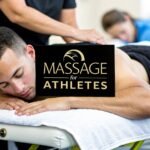
In the world of athletics, every advantage counts. While training and nutrition are paramount, a crucial third pillar often goes overlooked: recovery. This is where massage therapy transforms from a luxury into a necessity for any active individual. For dedicated athletes, understanding the profound benefits of massage is key to unlocking faster recovery, preventing injuries, and achieving peak performance.
This guide moves beyond generic advice to provide a detailed breakdown of the science-backed advantages of therapeutic bodywork. We will explore specific, actionable strategies for integrating massage into your routine to gain a competitive edge. You will learn precisely how targeted techniques can reduce pain, enhance circulation, improve sleep quality, and support your overall well-being. At spas like La Moon Massage and Facial in Houston, we see firsthand how targeted massage unlocks athletic potential, helping clients push their limits and recover smarter.
From managing chronic pain to boosting your immune system, the following points will equip you with the knowledge to make massage an essential component of your performance and recovery plan. Each section offers practical takeaways, ensuring you can apply these insights immediately to feel and perform your best.
1. Accelerated Muscle Recovery and Performance
For any athlete or active individual, the time between workouts is as critical as the training itself. Intense physical activity creates microscopic tears in muscle fibers, leading to inflammation and the accumulation of metabolic waste products. One of the primary benefits of massage is its ability to significantly speed up the body's natural healing processes, making it a cornerstone of modern athletic recovery protocols.
How It Works: The Science of Touch
Sports massage and deep tissue techniques directly address the physiological aftermath of exercise. The pressure applied by a skilled therapist enhances blood and lymph circulation. This improved flow helps flush out inflammatory substances and metabolic byproducts, like lactate, from muscle tissue. Simultaneously, it delivers fresh, oxygen-rich blood to the fatigued areas, providing the necessary nutrients for repair.
This process directly combats Delayed Onset Muscle Soreness (DOMS), the characteristic stiffness and pain felt 24 to 72 hours after strenuous activity. By mitigating DOMS, athletes can return to training sooner and maintain a higher level of performance without being hindered by excessive soreness.
Key Insight: Massage doesn't just mask soreness; it actively accelerates the cellular repair mechanisms that reduce it, allowing for greater training consistency and volume.
Practical Application and Actionable Tips
To effectively integrate massage into your routine, timing and technique are crucial.
- Post-Workout Recovery: Schedule a deep tissue or sports massage 24-48 hours after your most intense training session. This timing allows the initial acute inflammation to subside, making the muscles more receptive to deeper work that breaks down adhesions and realigns muscle fibers.
- Pre-Event Preparation: A lighter, faster-paced massage 1-2 days before a competition can be beneficial. This approach, often called a pre-event massage, focuses on stimulating circulation and increasing tissue pliability without causing deep soreness.
- Maximize Your Session: Enhance the effects by hydrating well before and after your appointment. Following your massage, perform light, dynamic stretches to maintain the newfound flexibility and range of motion.
- Communicate Clearly: Always inform your therapist about recent intense workouts or any acute injuries. They can adjust pressure and technique to avoid causing further damage and focus on promoting healing.
From NFL teams employing full-time massage therapists to Olympic training centers integrating it into daily protocols, the evidence is clear. Targeted massage is not a luxury but a strategic tool for anyone serious about their physical performance and longevity. For a deeper dive into the specific techniques involved, you can learn more about how massage supercharges muscle recovery.
2. Pain Relief and Management
While often associated with relaxation, one of the most powerful benefits of massage is its profound ability to alleviate both acute and chronic pain. For individuals dealing with everything from post-surgical discomfort to persistent conditions like lower back pain or fibromyalgia, massage therapy offers a non-invasive, drug-free approach to managing symptoms by addressing their root physiological causes.
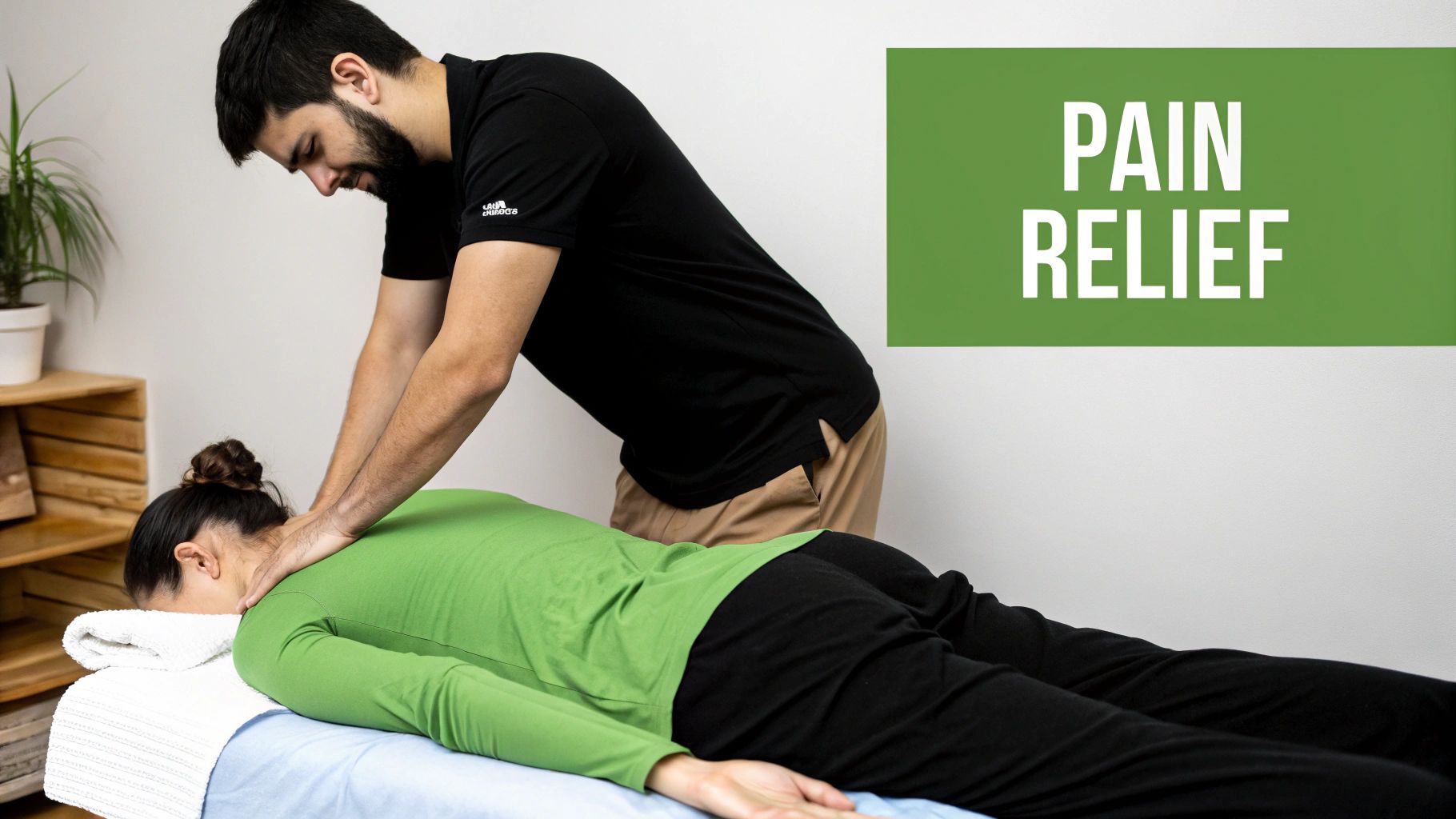
How It Works: The Science of Touch
Massage therapy provides pain relief through a multi-faceted approach. First, the manipulation of soft tissue increases local blood flow, which helps reduce inflammation and delivers oxygen to constricted, painful areas. Second, it directly targets and releases muscle tension and knots, or trigger points, which are often the source of referred pain in other parts of the body.
Furthermore, massage engages the "gate control theory of pain." The gentle pressure and movement create nerve signals that travel to the brain faster than pain signals. This effectively "closes the gate" on the pain signals, reducing their perception and providing immediate relief. This is why leading institutions like the Mayo Clinic and the Arthritis Foundation recommend massage for pain management.
Key Insight: Massage does more than just soothe sore muscles; it actively interrupts pain signals at the neurological level, providing a powerful alternative or complement to traditional pain medication.
Practical Application and Actionable Tips
To leverage massage for effective pain management, a targeted and communicative approach is essential.
- Address Chronic Pain: For conditions like arthritis or lower back pain, regular sessions (weekly or bi-weekly) can manage flare-ups and improve overall function. Techniques like trigger point therapy, pioneered by Dr. Janet Travell, are especially effective for chronic, knotted muscles.
- Post-Injury or Surgery: After an injury or surgical procedure, once cleared by a doctor, gentle massage can help reduce swelling, prevent scar tissue formation, and manage post-operative pain.
- Communicate Pain Levels: Your feedback is crucial. Use a 1-10 pain scale to tell your therapist what you’re feeling. This allows them to adjust pressure to be therapeutic without causing more pain or inflammation.
- Combine and Enhance: Maximize the benefits by staying hydrated to help flush metabolic waste released from muscles. Incorporate gentle stretching and apply heat or ice as recommended by your therapist post-session to prolong relief.
From professional athletes managing injuries to cancer centers incorporating massage to improve patient quality of life, targeted bodywork is a validated pain management strategy. To discover which techniques are best suited for your specific needs, you can explore the various types of massage for pain relief.
3. Improved Sleep Quality
For anyone struggling with restless nights or inconsistent sleep patterns, the cycle of fatigue can be debilitating, impacting everything from mental clarity to physical recovery. While many seek solutions in medication or complex routines, a fundamental benefit of massage lies in its profound ability to improve sleep quality. It works by addressing both the physical and biochemical barriers that stand in the way of deep, restorative rest.
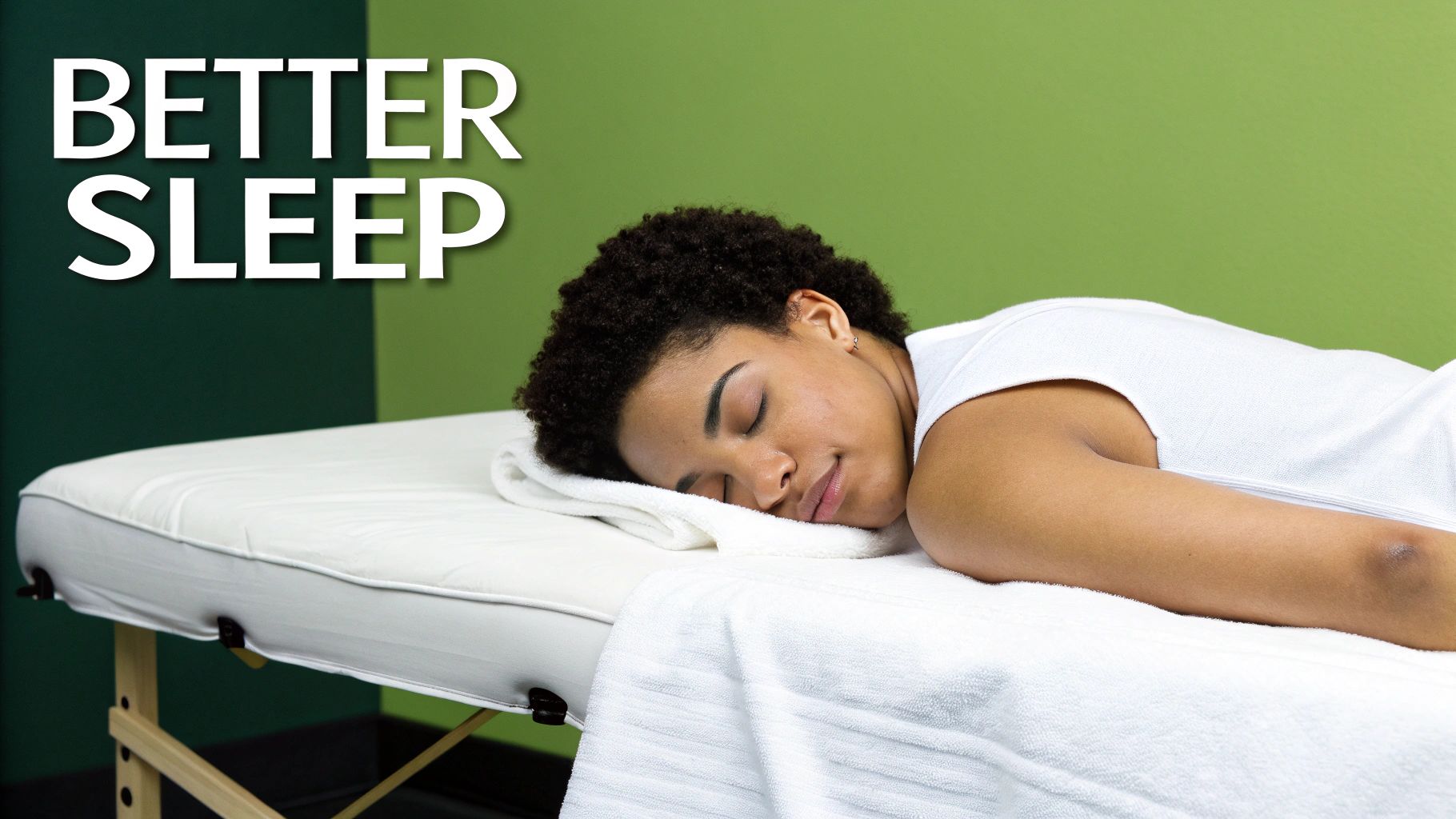
How It Works: The Science of Relaxation
The therapeutic touch of massage triggers a powerful physiological shift away from the body's "fight or flight" response and toward its "rest and digest" state. This process is mediated by the nervous system and involves a significant hormonal rebalancing. Massage has been shown to decrease levels of cortisol, the body's primary stress hormone, while simultaneously boosting the production of serotonin and dopamine.
Serotonin is a key precursor to melatonin, the hormone that directly regulates our sleep-wake cycles, or circadian rhythms. By promoting this biochemical cascade, massage helps reset the body's internal clock, making it easier to fall asleep and stay asleep. This effect is so recognized that sleep clinics and specialists, including those at the National Sleep Foundation, often incorporate massage therapy into holistic treatment protocols.
Key Insight: Massage doesn't just make you feel relaxed; it actively changes your body's chemistry to be more conducive to sleep, reducing stress hormones and increasing the production of sleep-regulating neurotransmitters.
Practical Application and Actionable Tips
To leverage massage for better sleep, strategic timing and creating the right environment are essential.
- Optimal Timing: Schedule your massage for the late afternoon or early evening, ideally 2-3 hours before your intended bedtime. This allows your body to fully embrace the relaxation response as you wind down for the night.
- Create a Routine: Treat your post-massage time as a dedicated pre-sleep ritual. Dim the lights, put away screens, and avoid stimulating activities. Keeping your bedroom cool and dark will enhance the sleep-promoting effects.
- Enhance with Aromatherapy: Ask your therapist to use calming essential oils like lavender or chamomile during your session. The scent can become a powerful sensory cue for relaxation that you can later use at home.
- Mind Your Intake: Avoid consuming caffeine or heavy meals after your massage. Instead, hydrate with water or a soothing, non-caffeinated herbal tea to support your body's detoxification and relaxation processes.
This approach is used effectively in various settings, from high-end hotels offering in-room massages to help guests overcome jet lag to retirement communities using gentle massage to address sleep disturbances in the elderly. By integrating massage as a purposeful tool, you can break the cycle of poor sleep and unlock better physical and mental performance.
4. Enhanced Circulation and Lymphatic Drainage
Beyond relaxing muscles, massage therapy acts as a mechanical pump for two of the body's most vital fluid systems: your blood and lymphatic networks. The physical manipulation of soft tissue directly stimulates flow, pushing nutrient-rich blood to tissues and encouraging the movement of lymphatic fluid, which is crucial for waste removal and immune response. This is one of the most fundamental benefits of massage, supporting everything from cellular health to athletic recovery.
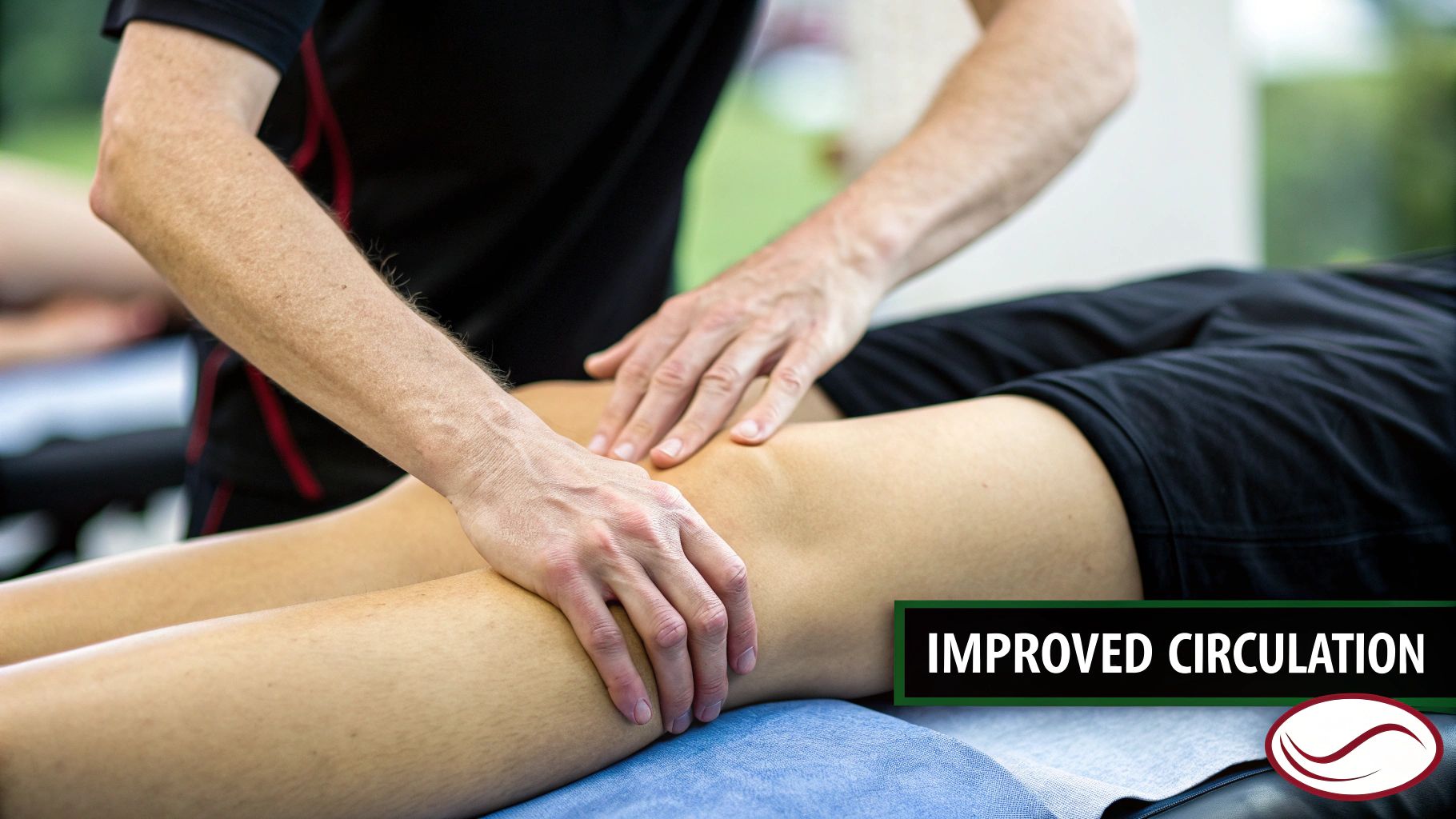
How It Works: The Science of Fluid Dynamics
Your circulatory system delivers oxygen and nutrients, while the lymphatic system clears metabolic waste, toxins, and excess fluid. Unlike the cardiovascular system, which has the heart as a central pump, the lymphatic system relies on muscle contractions and body movement to function. Massage provides external, targeted pressure that effectively propels these fluids along their pathways.
Techniques like effleurage (long, gliding strokes) and petrissage (kneading) create a pressure gradient that pushes venous blood toward the heart and moves stagnant lymph fluid into circulation for processing. This is why massage is frequently recommended for reducing swelling (edema) in post-surgical patients or for individuals with lymphedema. For athletes, this enhanced exchange means faster clearance of exercise byproducts and quicker delivery of repair materials to muscles.
Key Insight: Massage acts as an external pump for the lymphatic system, a passive network critical for immunity and detoxification that doesn't have its own pump like the heart.
Practical Application and Actionable Tips
Incorporating massage to boost circulation requires a mindful approach that supports your body's natural systems.
- Reduce Swelling: If you experience swelling in your limbs from injury, inactivity, or post-surgery, a lymphatic drainage massage can be highly effective. The gentle, rhythmic strokes are specifically designed to redirect fluid away from congested areas.
- Enhance Recovery: For post-workout benefits, focus on massage that moves toward the heart. This encourages venous return and helps clear metabolic waste from fatigued muscles more efficiently.
- Maximize Your Session: Hydration is paramount. Drink plenty of water before and after your session to help your kidneys and liver flush out the toxins that the massage has mobilized into your system.
- Combine with Movement: Amplify the circulatory benefits by engaging in light activity like walking or gentle stretching after your massage. This keeps the fluids moving and prevents them from stagnating again.
The techniques pioneered by Dr. Emil Vodder for Manual Lymphatic Drainage (MLD) are now a staple in clinical settings, from post-liposuction recovery to managing chronic conditions. Understanding how to leverage massage for circulatory health makes it a powerful tool for wellness and performance.
5. Muscle Recovery and Athletic Performance
For any athlete or active individual, the time between workouts is as critical as the training itself. Intense physical activity creates microscopic tears in muscle fibers, leading to inflammation and the accumulation of metabolic waste products. One of the primary benefits of massage is its ability to significantly speed up the body's natural healing processes, making it a cornerstone of modern athletic recovery protocols.
How It Works: The Science of Touch
Sports massage and deep tissue techniques directly address the physiological aftermath of exercise. The pressure applied by a skilled therapist enhances blood and lymph circulation. This improved flow helps flush out inflammatory substances and metabolic byproducts, like lactate, from muscle tissue. Simultaneously, it delivers fresh, oxygen-rich blood to the fatigued areas, providing the necessary nutrients for repair.
This process directly combats Delayed Onset Muscle Soreness (DOMS), the characteristic stiffness and pain felt 24 to 72 hours after strenuous activity. By mitigating DOMS, athletes can return to training sooner and maintain a higher level of performance without being hindered by excessive soreness.
Key Insight: Massage doesn't just mask soreness; it actively accelerates the cellular repair mechanisms that reduce it, allowing for greater training consistency and volume.
Practical Application and Actionable Tips
To effectively integrate massage into your routine, timing and technique are crucial.
- Post-Workout Recovery: Schedule a deep tissue or sports massage 24-48 hours after your most intense training session. This timing allows the initial acute inflammation to subside, making the muscles more receptive to deeper work that breaks down adhesions and realigns muscle fibers.
- Pre-Event Preparation: A lighter, faster-paced massage 1-2 days before a competition can be beneficial. This approach, often called a pre-event massage, focuses on stimulating circulation and increasing tissue pliability without causing deep soreness.
- Enhance the Effects: Complement the profound effects of massage by mastering breathing for stress relief, energy, and sleep recovery. Also, hydrate well before and after your appointment. Following your massage, perform light, dynamic stretches to maintain the newfound flexibility.
- Communicate Clearly: Always inform your therapist about recent intense workouts or any acute injuries. They can adjust pressure and technique to avoid causing further damage and focus on promoting healing.
From NFL teams employing full-time massage therapists to Olympic training centers integrating it into daily protocols, the evidence is clear. Targeted massage is not a luxury but a strategic tool for anyone serious about their physical performance and longevity. To explore the specific techniques involved, you can learn more about how massage supercharges muscle recovery.
6. Immune System Support
While often associated with muscles and relaxation, one of the most profound benefits of massage is its direct impact on the body's defensive capabilities. Regular massage therapy can bolster the immune system, making you more resilient against common illnesses and infections. This is particularly crucial for athletes, as intense training can temporarily suppress immune function, leaving them vulnerable.
How It Works: The Science of Touch
The connection between massage and immunity is multifaceted, involving both physiological and psychological mechanisms. Research, notably from institutions like the Touch Research Institute and studies led by figures like Dr. Mark Rapaport, has shown that massage therapy increases the activity of the body's "natural killer" cells. These are a type of white blood cell that plays a major role in the host-rejection of both tumors and virally infected cells.
Furthermore, massage significantly lowers levels of cortisol, the body’s primary stress hormone. Chronic elevation of cortisol is known to suppress immune function. By reducing stress and improving circulation, massage helps ensure that protective immune cells are transported effectively throughout the body, ready to respond to threats.
Key Insight: Massage acts as a biological regulator, decreasing stress hormones that impair immunity while simultaneously increasing the cells that actively fight off pathogens.
Practical Application and Actionable Tips
Integrating massage for immune health is a proactive strategy rather than a reactive one.
- Schedule Strategically: Book regular sessions during periods of high stress or increased exposure to illness, such as flu season or intense training blocks. Consistency is more effective than a single session.
- Focus on Stress Reduction: The immune boost is strongly linked to relaxation. To maximize these benefits, choose a massage style you find deeply calming, like a Swedish or aromatherapy massage, which can enhance the cortisol-reducing effects.
- Consider Lymphatic Drainage: For targeted immune support, a lymphatic drainage massage is ideal. This gentle technique specifically encourages the movement of lymph fluids, helping the body clear waste and transport immune cells more efficiently.
- Know When to Avoid It: Never get a massage when you are actively sick with a fever or contagious illness. Massage can potentially worsen symptoms and overtax a body that is already fighting an infection.
The integration of massage therapy in settings from cancer treatment centers to corporate wellness programs underscores its value. These institutions use massage not just for comfort but as a functional tool to support the body's intrinsic ability to defend itself, leading to fewer sick days and improved overall health resilience.
7. Mental Health and Emotional Well-being
While the physical benefits of massage are well-documented, its profound impact on mental and emotional health is equally significant. In our high-stress, always-on culture, the mind often carries as much tension as the body. Massage therapy serves as a powerful antidote, directly addressing the physiological roots of anxiety, depression, and emotional imbalance to foster psychological resilience.
How It Works: The Science of Touch
The therapeutic power of touch extends deep into our neurochemistry. A professional massage session is known to decrease levels of cortisol, the body’s primary stress hormone, by an average of 30%. Simultaneously, it stimulates the release of key mood-regulating neurotransmitters, including serotonin and dopamine, which are associated with feelings of happiness, calm, and well-being.
This biochemical shift provides a tangible reprieve from the relentless cycle of stress and anxiety. The safe, non-verbal, and nurturing environment of a massage allows the nervous system to switch from its "fight-or-flight" sympathetic state to the "rest-and-digest" parasympathetic state, promoting deep relaxation and emotional regulation.
Key Insight: Massage is not just a mental break; it's a neurochemical reset. It actively rebalances the hormones and neurotransmitters that govern your mood and stress response.
Practical Application and Actionable Tips
Integrating massage for mental wellness requires intentionality and a focus on creating a restorative experience.
- Schedule for Sanity: Book your massage during periods of high stress or as a preventative measure. Think of it as a non-negotiable appointment for your mental health, just like therapy or exercise.
- Communicate Emotional Needs: Don't hesitate to tell your therapist if you're feeling particularly anxious or overwhelmed. They can adapt the session with slower, more rhythmic strokes or focus on areas like the scalp and hands to promote deeper relaxation.
- Practice Mindfulness: Use the time on the table to focus on your breath. Pay attention to the sensation of the therapist's touch and the release of tension in your muscles. This turns the session into a meditative practice, amplifying its mental benefits.
- Allow for Integration Time: Avoid rushing back to a stressful environment immediately after your massage. Plan for 15-30 minutes of quiet time afterward to allow your mind to process the experience and integrate the sense of calm.
From mental health clinics integrating massage into treatment plans to addiction recovery centers using it for emotional healing, the approach is gaining widespread recognition. Research championed by figures like Dr. Christopher Moyer and supported by institutions like the National Institute of Mental Health confirms that the benefits of massage are a critical component of holistic well-being.
8. Improved Posture and Structural Alignment
In our modern, sedentary world, chronic postural stress from sitting at desks, looking down at phones, and repetitive movements is a leading cause of musculoskeletal pain. Poor posture creates a cascade of physical problems, from neck and back pain to headaches and reduced lung capacity. One of the most significant long-term benefits of massage is its ability to correct these structural imbalances by addressing the root muscular causes.
How It Works: The Science of Touch
Habitual poor posture forces certain muscles to remain chronically shortened and tight, while others become overstretched and weak. Massage therapy, particularly techniques like deep tissue, myofascial release, and structural integration pioneered by figures like Ida Rolf, directly targets these dysfunctional patterns. By manually lengthening tight muscles, such as the pectorals and anterior neck muscles in "desk workers' posture," therapists can restore balance.
This process allows the skeletal system to return to a more optimal and efficient alignment. Releasing trigger points and fascial adhesions that pull the body out of alignment reduces strain on joints and ligaments, alleviates chronic pain, and improves overall movement mechanics.
Key Insight: Massage corrects posture not by forcing bones into place, but by re-educating the soft tissues that dictate skeletal alignment, leading to more lasting and functional change.
Practical Application and Actionable Tips
Integrating massage for postural correction requires a consistent and holistic approach.
- Targeted Sessions: Work with your therapist to identify key problem areas. For office workers, this often means focusing on the neck, shoulders, chest, and lower back to counteract the effects of prolonged sitting.
- Combine with Ergonomics: Maximize the benefits by improving your environment. Adjust your chair, desk, and monitor height to support a neutral spine. The effects of a good massage can be quickly undone by an unsupportive workspace.
- Strengthen and Stretch: Between sessions, focus on strengthening neglected muscles like the upper back and core. Perform stretches recommended by your therapist for chronically tight areas like the chest and hip flexors.
- Mindful Movement: Become aware of your posture throughout the day. Set reminders to stand up, stretch, and reset your alignment. This daily practice reinforces the positive changes initiated during your massage.
Therapeutic massage is a powerful tool used in physical therapy clinics and chiropractic offices to support spinal alignment and functional movement. By addressing the soft tissue component of posture, it provides a foundational treatment for long-term structural health. To explore this topic further, you can learn more about how massage improves posture.
Benefits Comparison of 8 Massage Effects
| Massage Therapy Focus | Implementation Complexity 🔄 | Resource Requirements ⚡ | Expected Outcomes 📊 | Ideal Use Cases 💡 | Key Advantages ⭐ |
|---|---|---|---|---|---|
| Stress and Anxiety Reduction | Moderate – requires skilled therapist | Medium – regular sessions advised | Significant cortisol reduction, serotonin boost | Corporate wellness, hospitals, spas | Immediate stress relief, long-term anxiety reduction, natural, no side effects |
| Pain Relief and Management | Moderate to High – skilled therapist needed | Medium to High – multiple sessions | Pain reduction, improved joint mobility | Chronic pain, injury recovery, arthritis | Drug-free pain management, treats root causes, improves quality of life |
| Improved Sleep Quality | Moderate – timing and environment matter | Medium – regular sessions beneficial | Better sleep onset and quality | Sleep clinics, infant care, elderly sleep issues | Natural sleep aid, safe for all ages, addresses multiple sleep disruption causes |
| Enhanced Circulation & Lymphatic Drainage | Moderate – requires proper technique | Medium – consistent treatment needed | Increased blood flow and lymph drainage | Post-surgical recovery, athletes, pregnancy | Supports cardiovascular health, reduces swelling, boosts immune function |
| Muscle Recovery & Athletic Performance | High – timing and therapist skill crucial | Medium to High – frequent sessions | Faster recovery, reduced soreness, enhanced flexibility | Professional sports teams, athletes | Improved performance, injury prevention, faster recovery |
| Immune System Support | Moderate – consistent treatments required | Medium – regular sessions advised | Enhanced natural killer cell activity, reduced inflammation | Cancer centers, wellness programs, elderly care | Natural immune boost, reduces illness frequency, complements treatments |
| Mental Health & Emotional Well-being | Moderate – trust and environment important | Medium – regular sessions beneficial | Depression and anxiety symptom reduction | Mental health clinics, PTSD, addiction recovery | Mood enhancement, emotional support, complements therapy |
| Improved Posture & Structural Alignment | High – requires multiple sessions and lifestyle changes | Medium – ongoing treatment recommended | Corrected posture, reduced chronic pain | Office workers, physical therapy, ergonomics | Long-term pain reduction, improved movement efficiency, prevents future issues |
Integrating Massage Into Your Winning Strategy
Throughout this guide, we've explored the extensive and scientifically-backed benefits of massage, moving far beyond the common perception of it as a mere luxury. For the dedicated athlete and the active individual, these advantages are not just pleasant side effects; they are essential components of a comprehensive performance, recovery, and wellness protocol. Viewing massage therapy as an integral part of your training regimen is the shift in mindset that separates good athletes from great ones.
We have seen how targeted massage can dismantle the physiological barriers holding you back. From mitigating the chronic pain that hinders your movement to accelerating muscle recovery, each session is a direct investment in your physical capabilities. The enhanced circulation and lymphatic drainage discussed are not abstract concepts; they are the very mechanisms that clear metabolic waste and deliver nutrient-rich blood to your hard-working tissues, allowing you to bounce back faster and train more effectively.
From Physical Gains to Mental Fortitude
The journey to peak performance is as much a mental game as it is a physical one. This is where the profound psychological benefits of massage come into play. By actively reducing stress hormones like cortisol and promoting a state of deep relaxation, massage sharpens your mental focus, improves your emotional regulation, and combats the anxiety that can sabotage a competition or a crucial training session.
Furthermore, the significant improvement in sleep quality cannot be overstated. Rest is the cornerstone of recovery, and by facilitating deeper, more restorative sleep cycles, massage ensures your body and mind have the resources they need to repair, rebuild, and adapt. When you combine this with a strengthened immune system and better structural alignment, you aren't just treating symptoms; you are building a more resilient, efficient, and injury-resistant foundation.
Making Massage a Consistent Part of Your Routine
To truly unlock these powerful benefits, consistency is paramount. A single massage can provide temporary relief, but integrating it into your regular schedule transforms it into a strategic tool for long-term success.
- For Pre-Event Preparation: Schedule a lighter, circulation-focused massage 2-3 days before a major competition to prime your muscles without causing deep tissue soreness.
- For Post-Event Recovery: Plan a session within 24-48 hours after a strenuous event or workout to address inflammation, reduce delayed onset muscle soreness (DOMS), and kickstart the recovery process.
- For Ongoing Maintenance: A regular session every 1-4 weeks, depending on your training intensity, can help manage chronic issues, improve posture, and prevent injuries from developing in the first place.
Adopting this proactive approach means you are no longer just reacting to pain or fatigue. Instead, you are actively cultivating an environment within your body that fosters peak performance, longevity, and an unbreakable connection between mind and muscle. This is how you build a winning strategy that lasts.
Ready to experience the transformative benefits of massage firsthand? At La Moon Massage and Facial, our expert therapists specialize in creating personalized treatment plans designed to meet the unique demands of athletes and active individuals. Stop letting pain and slow recovery dictate your limits and start building a more powerful you by visiting La Moon Massage and Facial to book your session today.
How Often Should I Get a Massage? Find the Perfect Frequency
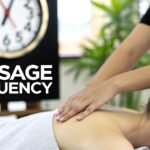
So, how often should you really be getting a massage? While there's no single magic number, a great rule of thumb for general wellness is about once or twice a month. But if you're tackling something more specific, like recovering from a tough workout or managing chronic pain, you might need to book appointments more often—think weekly or every other week.
The real key, no matter your goal, is consistency. That’s how you unlock the long-term benefits.
Finding Your Perfect Massage Rhythm
Figuring out the right massage schedule is a lot like creating a custom workout plan. It's deeply personal and depends entirely on what you're hoping to achieve, your lifestyle, and how your body feels. There’s no universal answer, but looking at common scenarios can give you a fantastic starting point.
This chart breaks down the average monthly massage frequencies people get based on their goals.
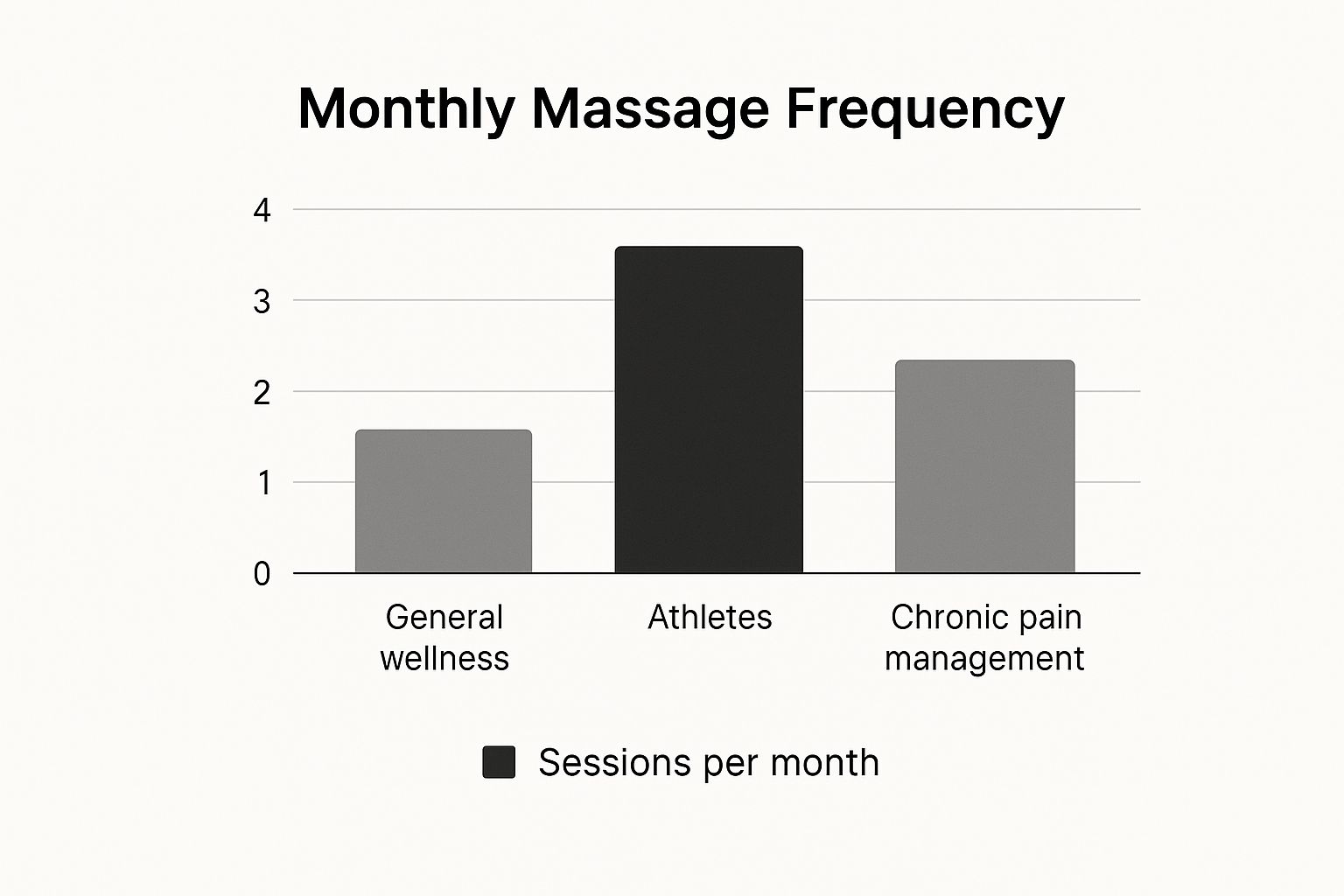
As you can see, your "why" directly shapes the "how often." Athletes, for example, need more frequent sessions to stay in peak condition, while someone focused on relaxation might only need a monthly tune-up.
To give you a clearer picture, I've put together a quick-glance table. It summarizes the most common goals and the frequency that usually works best for each.
| Recommended Massage Frequency Based on Your Goal |
| :— | :— | :— |
| Your Primary Goal | Recommended Frequency | Best For |
| General Wellness & Stress Relief | 1-2 times per month | Maintaining balance, managing everyday tension, and proactive self-care. |
| Chronic Pain Management | 1-4 times per month | Addressing persistent issues like back pain or sciatica. More frequent initially. |
| Athletic Performance & Recovery | 2-4 times per month | Enhancing muscle recovery, improving flexibility, and preventing injuries. |
| Injury Rehabilitation | 4+ times per month (initially) | Working with a therapist as part of a targeted recovery plan from a specific injury. |
| Pregnancy (Prenatal Massage) | 1-2 times per month | Easing discomfort associated with pregnancy, like back pain and swelling. |
This table is just a guide, of course. The best approach is always to listen to your body and work with your massage therapist to adjust the plan as you go.
Start With Your Primary Goal
The first and most important question to ask yourself is: Why do I want a massage? Are you trying to escape the stress of a demanding job, or are you trying to manage a physical issue that just won't go away?
-
For General Stress Relief and Wellness: Think of a monthly massage as your personal "reset button." It's a fantastic way to keep everyday stress in check and maintain a baseline of feeling good in your own skin.
-
For Athletic Performance and Recovery: If you're active in sports or hit the gym regularly, a more frequent schedule is your best bet. Getting a massage once a week or every other week can help your muscles recover faster, prevent nagging injuries, and keep you flexible.
-
For Chronic Pain or Specific Conditions: If you're dealing with something persistent like chronic back pain, fibromyalgia, or sciatica, you'll likely need weekly sessions, at least at the beginning. This helps break the pain cycle and get your symptoms under control.
The goal isn't just about feeling better for an hour. It's about creating cumulative benefits. Each massage builds on the last, leading to more profound and lasting improvements in muscle health, flexibility, and your ability to handle stress.
This mindset is becoming more common. People are increasingly seeing massage as a crucial part of their health routine, not just a luxury. In fact, a whopping 61% of consumers get massages specifically for medical or health reasons. It's a clear signal that we're moving toward a more holistic view of healthcare, and you can learn more about the growth of massage therapy services in recent industry reports.
Matching Your Massage Schedule to Your Lifestyle
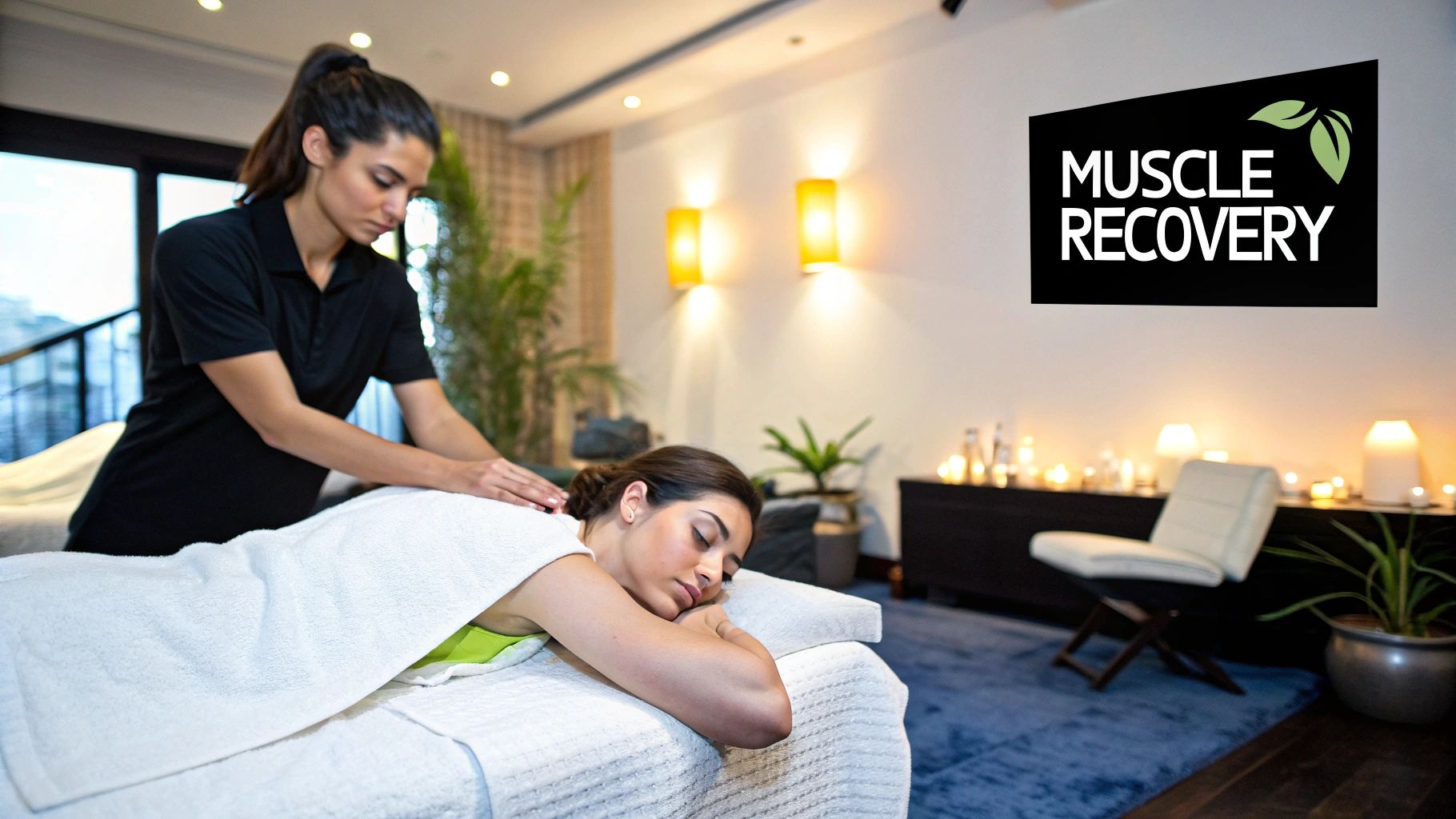
The perfect massage schedule isn’t something you’ll find on a generic chart. It’s something you discover by looking at your own life, because a one-size-fits-all approach just doesn't cut it when everyone’s daily grind is so different. Think of yourself as a detective, piecing together clues from your own routine to find what works for you.
It's a bit like watering a plant. You wouldn't give a hardy cactus the same amount of water as a thirsty fern basking in the sun, right? Your body is no different. Its need for massage therapy rises and falls based on the physical and mental demands you place on it day in and day out.
To really nail down your ideal frequency, you’ve got to get honest about your activity levels, the stress of your job, and what triggers your tension. This self-awareness is the first and most important step toward creating a routine that gives you real, lasting relief.
The Desk Worker and “Tech Neck”
If you spend 8 hours a day glued to a desk, your body is fighting a very specific battle. That constant forward-leaning posture, staring at a screen, is the perfect recipe for what many now call "tech neck"—that nagging combination of tight shoulders, a stiff neck, and a persistent ache in the upper back.
For desk workers, the tension is cumulative. It sneaks up on you, building quietly from Monday to Friday, until you can really feel it by the end of the week.
A massage every 2 to 4 weeks is your secret weapon. It acts as a powerful reset button, counteracting the gradual shortening of your chest muscles and the constant strain on your back. This helps restore your natural posture and stops chronic pain patterns from taking hold.
Think of it as undoing the postural damage before it becomes a much bigger problem, keeping you comfortable and focused at your desk.
The Physically Demanding Job
Now, let's flip the script and think about someone whose job is all about physical effort. Maybe you're a construction worker, a nurse who is constantly on the move, or a warehouse employee lifting and carrying all day. In these roles, muscle fatigue isn't just a possibility; it's a daily reality. The goal here shifts from simple relaxation to active recovery and preventing injuries.
For this kind of work, a more frequent massage schedule is often what’s needed to keep your body from breaking down.
- Weekly Sessions: This is a fantastic idea during especially tough work weeks or for anyone who deals with constant muscle soreness. A weekly massage helps flush out metabolic byproducts and reduce inflammation.
- Bi-Weekly Sessions: This works as a solid maintenance plan to manage the ongoing physical stress. It allows for regular deep tissue work to break up knots and adhesions before they start messing with your mobility.
For people in physically demanding jobs, a massage isn't an indulgence. It's essential maintenance, just like getting an oil change for a car you rely on every single day.
The Weekend Warrior or Dedicated Athlete
Are you a gym enthusiast whose legs are screaming after a tough workout? Or maybe you're a "weekend warrior," packing a whole week’s worth of running, hiking, or sports into two days? If so, your massage needs are tied directly to your training schedule.
When you're in the middle of intense training or gearing up for a competition, a weekly sports massage can be a game-changer. It can seriously boost your performance and slash your recovery time. These sessions are targeted, focusing on the specific muscles you're pushing to the limit to improve flexibility and fix minor strains before they sideline you with an injury.
During your off-season or when your activity level is lighter, you can ease up a bit, maybe scaling back to a bi-weekly or monthly massage to maintain muscle health. The key is to listen to your body. If you're feeling extra sore or your recovery is dragging, that's your cue to get back on the table.
Using Massage for Chronic Pain and Health Conditions
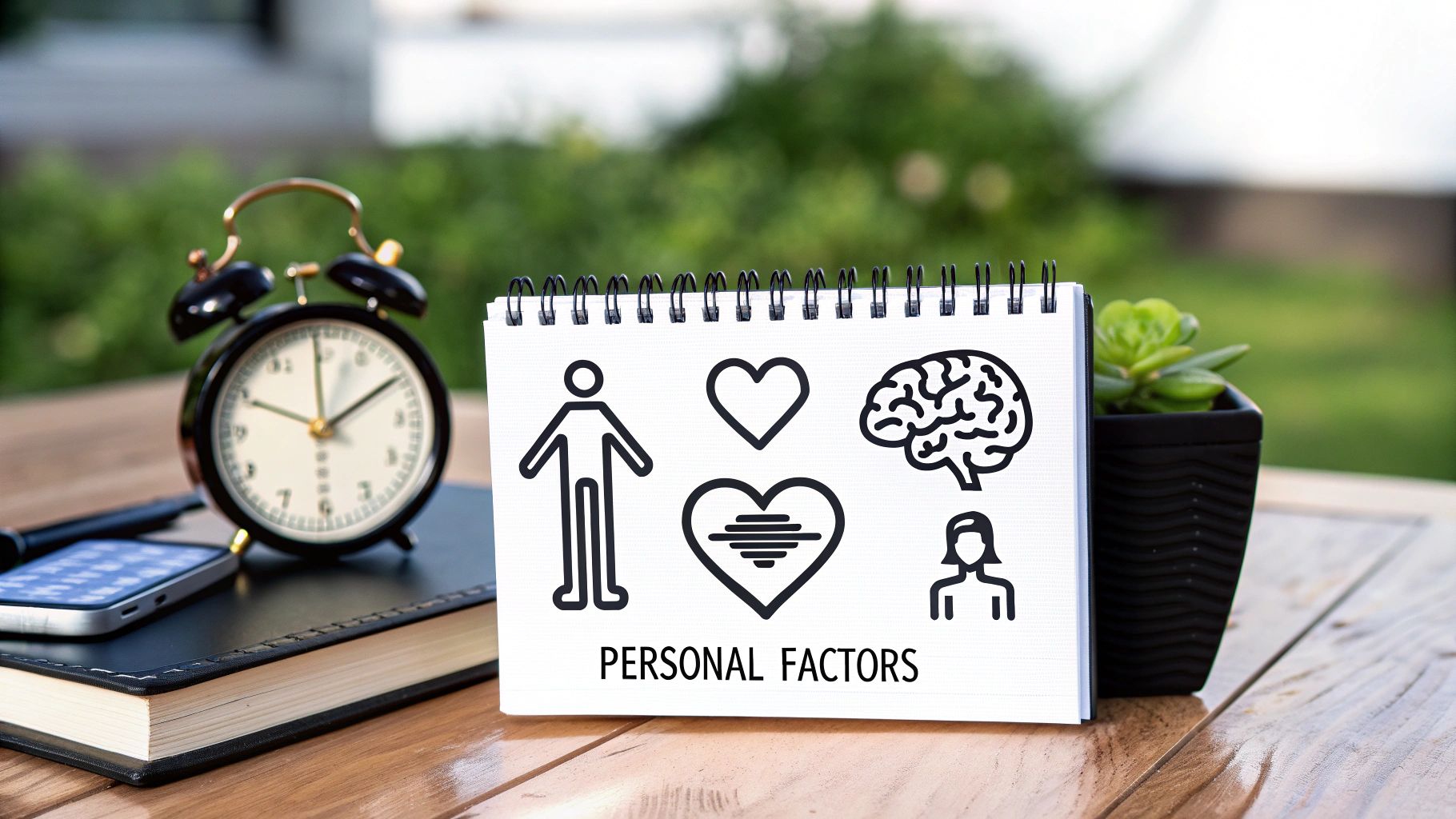
When you're dealing with a chronic condition like fibromyalgia, sciatica, or arthritis, massage therapy shifts from a "nice-to-have" luxury to an essential part of your management plan. The question of how often you should get a massage becomes less about general wellness and more about targeted, therapeutic care. The goal here isn’t just relaxation; it's about getting your quality of life back.
Think of chronic pain like a stubborn, smoldering fire. A single massage might pour some water on it and cool things down for a bit, but consistent sessions are what truly reduce the heat and keep it from flaring up again. Regular massage helps soothe a nervous system that's often stuck in high alert from chronic pain, and it boosts circulation to bring vital oxygen and nutrients to sore, inflamed tissues.
Breaking the Pain Cycle
With many chronic conditions, the first and most important step is to break the relentless pain cycle. This usually means starting with a more intensive schedule to really get a handle on your symptoms and make a noticeable impact.
-
Initial Phase (Breaking the Cycle): It’s very common to begin with weekly massages. This frequency helps interrupt the constant pain signals and gives your muscles a genuine chance to let go of deeply held tension. For instance, someone with acute sciatica might need weekly sessions to relieve pressure on the nerve and calm the inflammation.
-
Maintenance Phase (Managing Symptoms): Once you start to feel a real difference and your pain is more manageable, you can usually scale back to a maintenance schedule. This could mean getting a massage every two to three weeks. This rhythm is all about sustaining your progress and stopping the pain from creeping back to its old intensity.
The real secret is to see massage as a cumulative therapy. Each session builds on the last, gradually retraining your body's muscles and nervous system. It’s not about a single magic fix, but about establishing a new, more comfortable normal for your body.
Creating a Safe and Effective Plan
While working with a licensed massage therapist is vital, teaming up with your primary doctor or specialist is just as critical. A knowledgeable therapist will understand which techniques are safe and effective for your specific condition and, just as importantly, which ones to avoid. For example, deep tissue work might be too much during a fibromyalgia flare-up, whereas a gentler approach could bring incredible relief.
This is where a therapeutic massage really shines. It's an approach focused entirely on achieving specific health goals, whether that’s reducing pain or improving your range of motion. If you're wondering how this is different from a standard relaxation massage, our guide explains in detail what therapeutic massage is and how it can be customized just for you.
The growing trust in massage as a legitimate health tool is undeniable. In the U.S. alone, there are over 321,000 registered massage therapists, and it's estimated they delivered 150 million sessions in 2023. These numbers show just how many people are turning to massage for both physical and mental well-being.
Understanding complementary techniques can also be incredibly helpful. Learning about the role of lymphatic drainage in skin health, for example, provides insight into how different modalities can support the body’s innate healing systems. Ultimately, finding the right massage frequency is about creating a personalized plan—a collaboration between you, your therapist, and your doctor—to help you live more comfortably.
Finding Your Rhythm: Massage for Stress and Mental Health
https://www.youtube.com/embed/SxroabUx1Xs
Think of your stress levels like a bucket. Every single day, little things—work deadlines, family duties, the constant ping of your phone—add more water. If you don't find a way to empty it, that bucket is going to overflow. When it does, you're left feeling swamped, anxious, and just plain drained. Regular massage is one of the best ways to keep that bucket from spilling over.
There's real science behind the connection between touch and mental clarity. A good massage helps dial down your body's "fight or flight" response by lowering levels of the stress hormone, cortisol. As cortisol decreases, your body gets the signal to ramp up production of feel-good chemicals like serotonin and dopamine. The result is a profound sense of calm that sticks with you long after the session ends.
Proactive Care vs. Crisis Management
So, what’s the magic number for mental health massages? It really depends on whether you're playing defense against everyday stress or offense during a particularly tough time.
For general, proactive mental wellness, a monthly massage is a fantastic starting point. This cadence works like preventative maintenance for your mind, consistently keeping your stress levels in check. It helps you maintain a sense of balance, making you far more resilient when life throws you a curveball.
But what about those times when life is just a lot? Maybe you're facing a huge project at work, dealing with a family crisis, or going through a major life transition. During these high-stakes periods, your needs change. Upping your sessions to weekly or bi-weekly can be a lifeline. It provides immediate relief and helps stop stress from spiraling into something more serious, like burnout or chronic anxiety.
Think of it this way: A monthly massage is your routine mental health tune-up, keeping everything running smoothly. A weekly session during a rough patch is like calling in the cavalry—it gives your mind and body the extra support they desperately need to weather the storm.
Getting the Most Out of Your Sessions
The type of massage you choose makes a difference, too. While a classic, gentle Swedish massage is wonderful for overall relaxation, don't be afraid to ask for more focused work if you need it. Stress has a funny way of showing up physically as tight shoulders, a stiff neck, or tension headaches, all of which just add to your mental load.
Sometimes, the fastest way to mental peace is by tackling that physical tension head-on. Understanding the benefits of deep tissue massage can help you figure out if you need a more targeted approach to release those stubborn knots that are fueling your stress. When you treat the physical symptoms, the mental relief often follows.
Ultimately, the goal is to shift your mindset. Massage isn't just a treat for when you're already stressed out; it's a powerful, proactive tool for building a more resilient and centered mind. By finding a schedule that fits your life, you can make massage a core part of your mental health strategy.
How to Adjust Your Massage Schedule Over Time
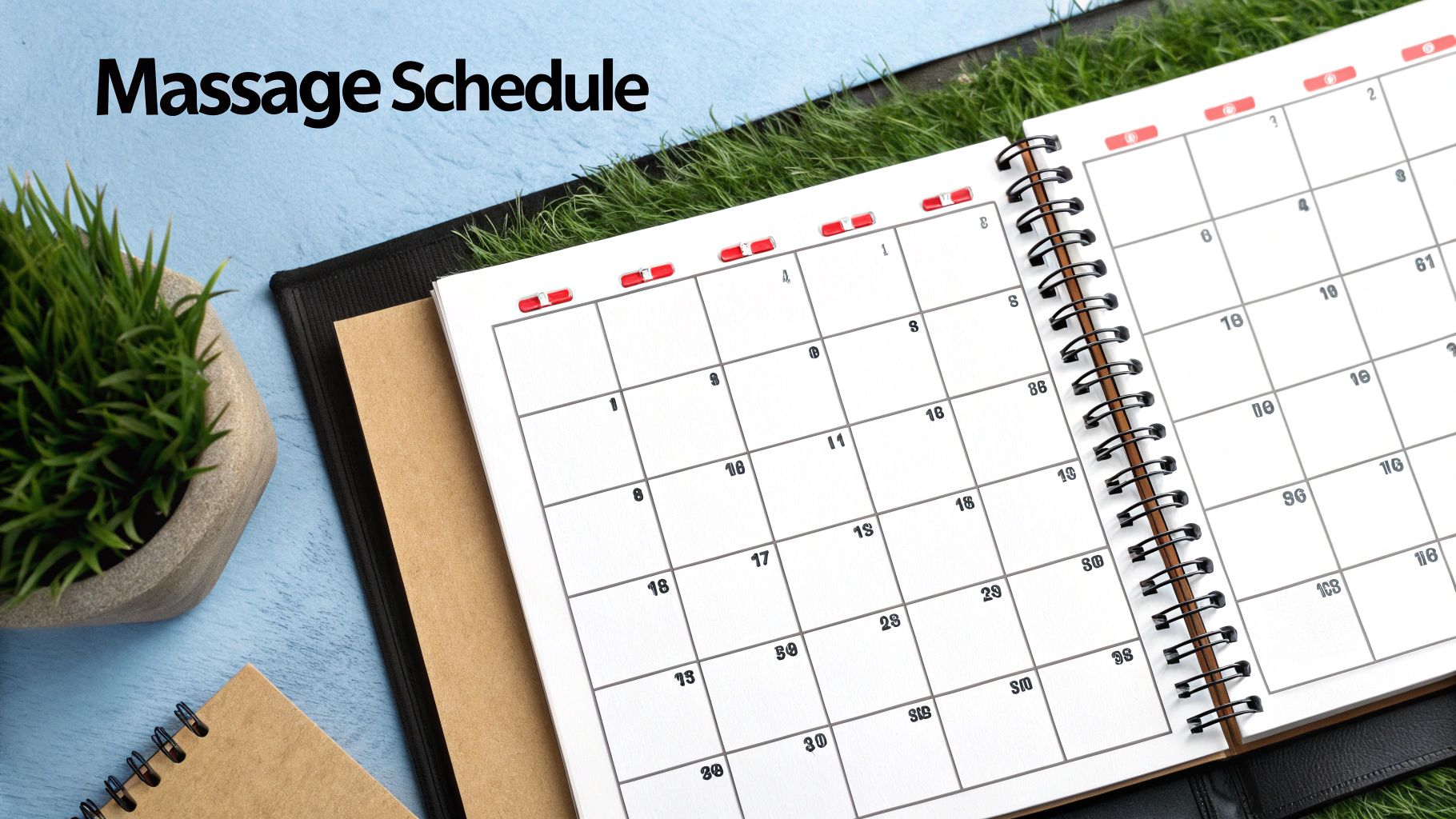
Your body isn't a static machine that runs on a fixed maintenance schedule. It's a living, breathing system that’s always changing. The massage frequency that worked wonders for you six months ago might not be the right fit today.
This is why a truly effective wellness plan treats massage frequency as a flexible tool, not a rigid rule. You can—and should—adapt your schedule based on what your body is telling you right now.
Thinking this way puts you in the driver’s seat. You’re empowered to make smart adjustments that keep your sessions effective and perfectly tuned to your current needs. Honestly, learning to listen to your body is the most important skill you can develop in your wellness journey.
Reading Your Body’s Signals
Your body is constantly sending you messages—some subtle, others not so much. Recognizing these cues is the secret to knowing when it’s time to book your next appointment or maybe even push it back a bit.
Here are a few tell-tale signs that you might need to schedule a massage sooner rather than later:
- Recurring Tension: Is that old knot in your shoulder making a comeback faster than usual?
- Trouble Sleeping: If you're tossing and turning more, it's often a sign that physical tension or stress is getting in the way of a good night's rest.
- Increased Workout Intensity: Have you ramped up your fitness routine or started training for an event? Lingering muscle soreness is a clear signal your body needs more recovery support.
- Frequent Headaches: A sudden spike in tension headaches often points directly to overworked muscles in your neck and shoulders that are crying out for relief.
On the flip side, if you're feeling fantastic, bouncing back from workouts with ease, and those old aches are a distant memory, you might have some room to space your sessions out a little more.
Think of your massage therapist as your co-pilot. They have the expertise to help you interpret your body’s signals and adjust your flight plan accordingly. An open, honest conversation about how you’re feeling is one of the most valuable parts of your therapy.
Having Productive Conversations with Your Therapist
To get the most out of every single session, regular check-ins with your therapist are absolutely essential. Don't be shy about starting the conversation; they genuinely want to know what’s working and what isn’t.
Here’s a simple way to frame the discussion at the start of your appointment:
- Share Your Progress: Tell them how you felt after the last session. Did the relief last for three days or three weeks? Be specific.
- Discuss New Developments: Let them know about any changes in your life. Have you started a new desk job, been under a lot more stress, or picked up a new physical hobby?
- Talk About Your Goals: Revisit why you started getting massages in the first place. Are you still focused on the same goal, or has a new one cropped up?
This kind of teamwork turns your massage from a passive treatment into a true health partnership. It ensures your plan is always targeted and responsive, giving you the right answer to "how often should I get a massage?" for whatever life throws your way.
Of course. Here is the rewritten section, crafted to sound completely human-written and natural.
Making Regular Massages an Affordable Part of Your Life
Let's be real for a moment: the cost is often the biggest roadblock when it comes to getting massages regularly. You know consistent bodywork is what your body needs, but shelling out for a premium session every week or two can feel like a pipe dream. The good news? It doesn't have to be. With a bit of savvy planning, you can absolutely make regular massage a sustainable part of your life.
The trick is to think beyond the sticker shock of a single, drop-in appointment. There are plenty of fantastic, high-quality options out there that won't break the bank.
Find Smart Savings Opportunities
One of the best-kept secrets in the wellness world is the student clinic. Reputable massage schools have clinics where advanced students provide massages at a huge discount to get their required practice hours. Don't worry, they're always supervised by seasoned instructors. It’s a win-win: you get excellent, affordable bodywork, and you help a future therapist hone their craft.
Another great strategy is to scout out membership programs or package deals at your local massage studios and spas.
Buying sessions in a bundle or signing up for a monthly plan almost always drops the per-session price. This simple shift in thinking turns massage from an occasional, guilt-ridden splurge into a predictable, manageable line item in your wellness budget.
Finally, don't forget to check your benefits. You might be surprised to learn that your health insurance could cover massage therapy if a doctor prescribes it for a specific medical issue. Many people can also use pre-tax dollars from a Flexible Spending Account (FSA) or Health Savings Account (HSA) to pay for therapeutic massages.
When you start exploring these avenues, the entire financial picture can change. Suddenly, regular massage stops feeling like an out-of-reach luxury and starts looking like the essential, affordable self-care it truly is.
Common Questions About Finding Your Massage Rhythm
Even with the best advice, you probably still have a few questions floating around. Let's tackle some of the most common ones so you can feel completely confident in your massage schedule.
Does the Type of Massage Change How Often I Should Get One?
Absolutely. Think of it like a workout. An intense deep tissue or sports massage is a serious workout for your muscles, so giving them a couple of weeks or even a full month to recover is smart.
On the other hand, a gentler Swedish massage is more like a brisk walk. It’s much less demanding, so you could easily enjoy one every week without overdoing it.
What Happens If I Miss an Appointment?
Life happens! Don't sweat it. The real magic of massage comes from consistency over the long haul, not from a perfect attendance record.
If you miss a session, just hop back into your routine as soon as you can. You might feel some of that old tension creeping back, which is just a little reminder of how much your body loves those regular treatments.
Is It Possible to Get Too Much Massage?
It’s not common, but yes, you can overdo it, especially with more intensive bodywork. The biggest signs are feeling constantly sore, bruised, or tender to the touch long after your session.
This is your body's way of saying it needs more downtime to heal. As you figure out your ideal frequency, learning about different techniques, like the ones in our guide to pain relief massage therapy, can make a big difference. The number one rule is always to listen to what your body is telling you and keep an open line of communication with your therapist.
Ready to build a massage plan that truly works for you? The experienced therapists at La Moon Massage and Facial are masters at helping you find the perfect rhythm for wellness. Discover how our premium treatments can soothe your body and mind by booking your next session at https://www.lamoondayspa.com.
Effective Massage for Muscle Stiffness | Relieve Pain & Improve Flexibility
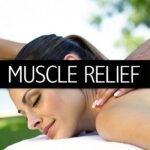
Yes, a massage provides that incredible, instant relief for stiff muscles, but what's happening beneath the surface is more than just a fleeting "feel-good" moment. It's a powerful mechanical process. The pressure from a skilled massage physically pushes out cells that cause inflammation, reduces fluid buildup, and jump-starts healing by improving blood flow right where you need it most.
Why Massage Actually Works for Stiff Muscles
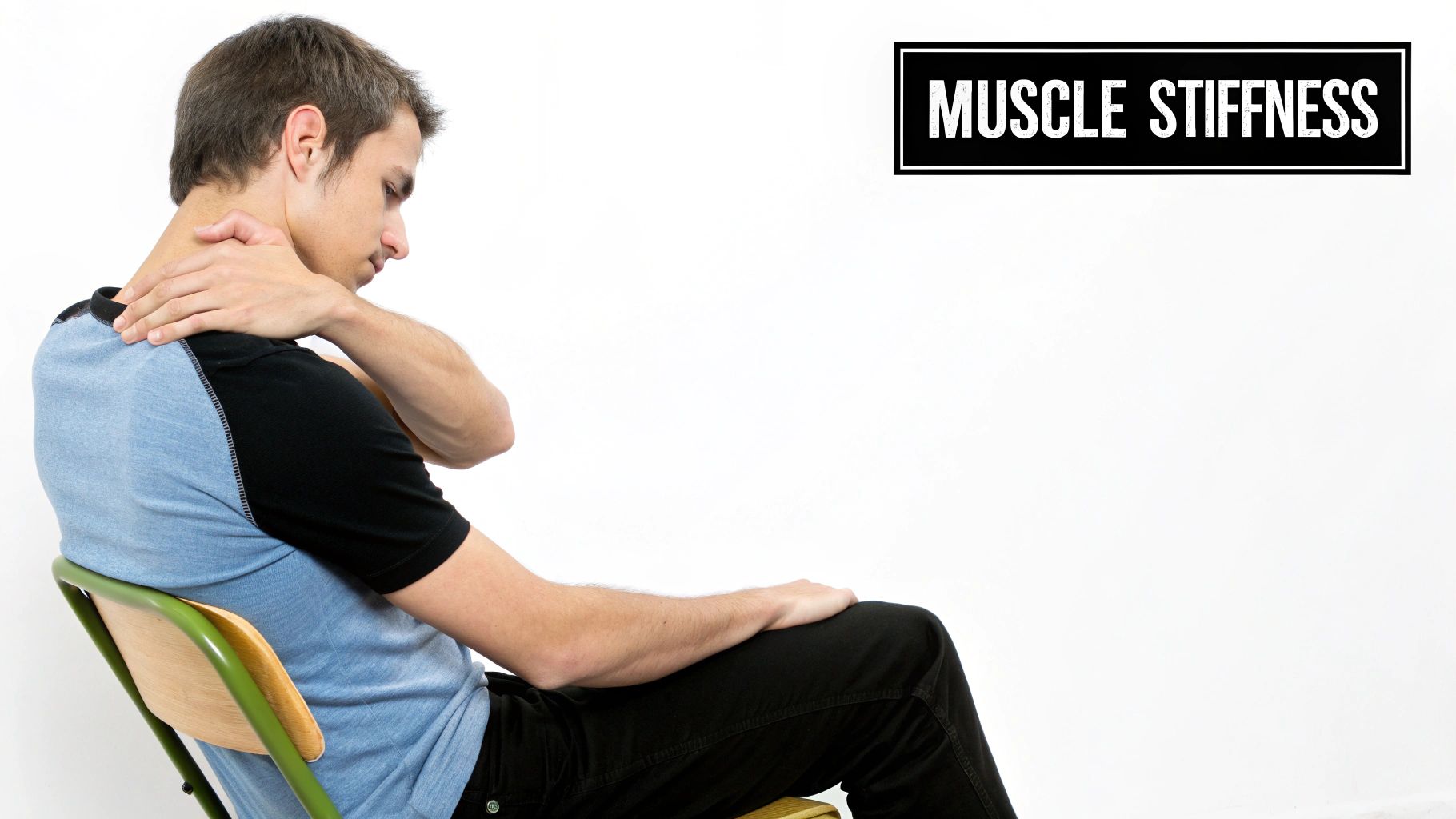
When your muscles are tight and full of knots, it’s usually because of a buildup of metabolic waste and inflammatory responses. This happens after a tough workout, a stressful week, or even just from sitting at a desk all day. Massage acts as a direct, hands-on solution to these biological traffic jams.
I like to think of a stiff muscle as a sponge soaked in murky water. The targeted pressure of a massage literally squeezes that "murky water" out. This isn't just water; it's a mix of inflammatory substances like cytokines and neutrophils that are causing your pain. Once they're cleared, fresh, oxygen-rich blood can soak back into the muscle tissue. This improved circulation is everything—it delivers the nutrients your muscles are crying out for to repair and recover.
This isn't just a nice analogy; it's what's really happening. Research from Harvard Wyss Institute backs this up, showing how mechanical compression, just like a massage, significantly speeds up healing in injured muscles. Researchers found that the pressure physically expelled the inflammatory cells from the muscle tissue, which directly led to faster and stronger muscle fiber regeneration.
How Massage Directly Impacts Stiff Muscles
To really get it, let's break down how massage directly interacts with your muscle tissue to alleviate that stiffness and get you back to feeling good.
| Mechanism | Effect on Muscle Stiffness | Benefit |
|---|---|---|
| Mechanical Pressure | Squeezes out and clears inflammatory cells (like neutrophils) from the muscle. | Reduces the primary source of pain and swelling. |
| Increased Circulation | Brings fresh, oxygenated blood to the muscle fibers. | Delivers vital nutrients needed for repair and recovery. |
| Myofascial Release | Loosens tight muscle fibers ("knots") and the surrounding connective tissue (fascia). | Relieves localized pain and restores ease of movement. |
| Nervous System Response | Signals the brain to relax the muscles, decreasing tension. | Enhances overall relaxation and reduces protective muscle guarding. |
Essentially, the relief you feel is the direct result of these actions working together inside your muscles.
What This Means for You
Understanding these mechanisms helps you see why specific massage techniques feel so effective. It’s not magic; it’s physiology.
- Less Inflammation: By physically clearing out inflammatory agents, massage directly tackles the source of your soreness.
- Better Blood Flow: Think of it as opening up a superhighway for healing nutrients to reach damaged muscle fibers.
- Reduced Muscle Tension: Those painful "knots" are released, immediately easing localized pain and improving how you move.
- Improved Flexibility: When your muscles and the connective tissue around them (the fascia) are loosened, your range of motion naturally increases.
The key thing to remember is that massage is an active treatment. It’s a hands-on intervention that changes the physiological environment within your muscles, creating the perfect conditions for healing and pain relief.
This is a huge deal for athletes and anyone who is physically active. If you’re looking to boost your recovery and performance, knowing this is a game-changer. In fact, our guide on sports massage therapy dives deeper into how specific techniques can make all the difference in your training. By targeting problem areas, you bounce back faster and lower your risk of future injuries.
Practical Self-Massage for Neck and Shoulder Tension
Let’s be honest, that nagging stiffness in your neck and shoulders feels like a constant companion these days. It’s the price we pay for long hours at a desk, stressful commutes, or even just sleeping awkwardly. But you don't have to just put up with it. You’ve got the power to work out those kinks yourself, and it’s easier than you think.
True relief isn't about some complicated, hour-long routine. It's about finding simple, effective ways to target tension the moment you feel it. When that familiar ache starts creeping up your neck at work, you can take action right there at your desk. Just use your hand to gently squeeze and knead the trapezius muscle—that large, meaty muscle connecting your neck and shoulder. It’s an instant release.
Simple Techniques for Immediate Relief
One of my favorite tricks for hitting those stubborn knots uses nothing more than a wall and a tennis or lacrosse ball. Just stand with your back to a wall, pop the ball between it and the tight spot in your shoulder, and bend your knees. This lets you roll the ball right over the tension, applying as much or as little pressure as you need. It’s fantastic for getting into those spots you can’t quite reach on your own.
For the neck itself, here are a couple of go-to moves you can do anywhere:
- The Squeeze & Breathe: Gently pinch the tight muscle on the side of your neck with your thumb and forefinger. Hold it for about 10-15 seconds while you take a deep, slow breath, then let go. Feel the tension melt away with your exhale.
- The Press & Tilt: Place the pads of your fingers on the back of your neck, right where it slopes down to your shoulder. Press firmly into the muscle and, at the same time, slowly tilt your head away from that side. You’ll feel a wonderful, deep stretch.
The real magic here is accessibility. These aren't just exercises; they're practical, real-world solutions. You can do them in a five-minute break between meetings or after a particularly tense phone call to reset your body.
The image below highlights some common reasons we get so stiff in the first place.
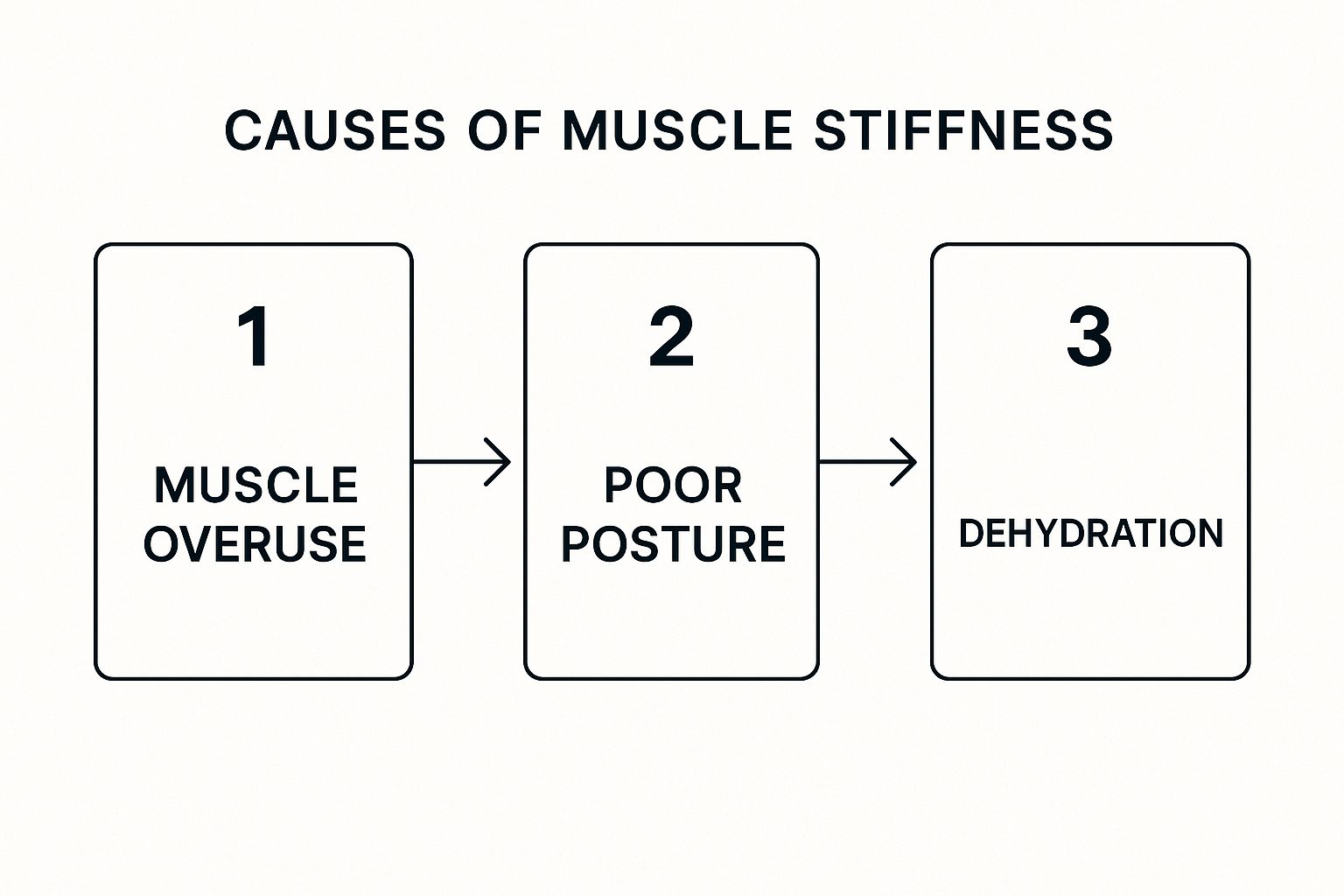
As you can see, things like poor posture and repetitive strain create a vicious cycle of tension. The good news is that a little self-massage is one of the best ways to break that cycle. For a deeper dive, our guide on https://blog.lamoondayspa.com/massage-for-neck-and-shoulder-pain/ has even more specific techniques you can try.
Making It a Consistent Habit
Turning these quick fixes into a regular habit is what delivers lasting change. Think about ways to build these moments into your day. Maybe you can even utilize shower body spray massage jets to work on tight muscles while you’re getting ready. The goal is to make self-care a seamless part of your routine, not another item on your to-do list.
It’s no surprise that so many people rely on massage for relief. In fact, studies show that its use for muscle and joint problems ranges from 2.2% to a staggering 81.2% across different parts of the world. North America, in particular, has one of the highest rates of use, which just goes to show how many of us have found it to be a trusted solution for stiffness and pain.
Targeting Leg and Hip Stiffness Like an Athlete
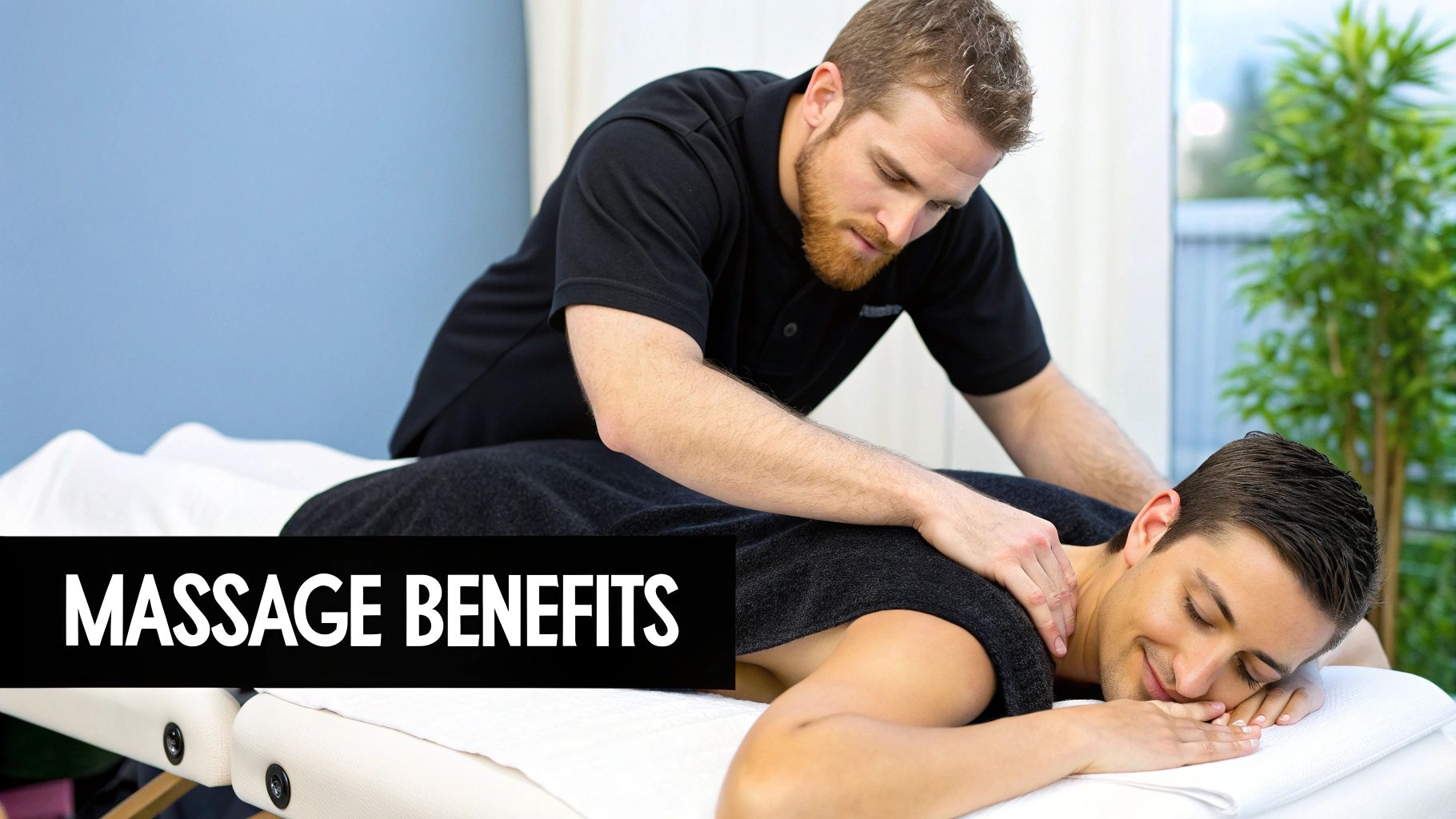
Your legs and hips are your body's engine, home to its largest and most powerful muscles. So, when they lock up—whether from a punishing workout or just a long day stuck in a chair—it can throw your whole body out of whack. This kind of stiffness calls for a more serious, targeted approach to massage.
From marathon runners to office workers, almost everyone has felt the misery of tight quads, hamstrings, or glutes. The fix usually involves more than a few basic stretches. You need techniques that can get deep into these dense muscles to really make a difference. It's all about applying the right kind of pressure to get rid of that soreness and restore your full range of motion.
Mastering the Foam Roller for Quads and IT Bands
There’s a good reason you see foam rollers in every gym. They’re fantastic for self-myofascial release—a technical term for breaking up the knots and adhesions in your muscles and the web of connective tissue, or fascia, that surrounds them. This is especially effective for big, broad muscles like your quadriceps.
To work on your quads, get into a plank position on your forearms with the roller under your thighs. Use your arms to slowly guide your body, rolling from just above your knees all the way up to your hip flexors. When you hit a spot that feels extra tender, stop. Just pause there for 20-30 seconds, breathe, and let the sustained pressure convince the muscle to let go.
Then there’s the IT band, that stubborn strip of tissue running along the outside of your thigh. The process is similar but often much more intense.
- Start by lying on your side with the foam roller positioned under your hip.
- Support your weight with your arms and your top leg, which gives you control over the intensity.
- Slowly roll down the outer side of your thigh, from your hip to just above your knee.
It’s going to be uncomfortable, no doubt about it. Go slow and focus on deep, steady breathing to work through it.
Quick, frantic rolling won't get you anywhere. The real magic happens with slow, deliberate pressure. Think of it like you're ironing out a stubborn wrinkle in a shirt—you need that slow, steady heat and pressure to smooth it out.
Releasing Deep Glute and Hip Tension
Sitting all day is a recipe for painfully tight glutes, which can sometimes lead to sciatica-like pain shooting down your leg. For this, a simple massage ball is your best tool. A lacrosse or even a tennis ball will do the trick.
Just sit on the floor, place the ball under one of your glutes, and gently roll around until you find a sore spot.
The goal here is sustained pressure. Once you've found a trigger point, lean your weight into it to deepen the massage. This direct approach can release knots that stretching alone simply can't touch. Runners, in particular, find this kind of targeted work incredibly beneficial. If you're looking for a more complete routine, our guide on https://blog.lamoondayspa.com/sports-massage-for-runners/ is a great resource to build upon this self-care.
While working on your legs and hips, don't forget that your feet are the foundation of it all. Problems there can easily travel up the chain. Incorporating some good foot stretches for flat feet can be a game-changer for your lower body's alignment and flexibility. It’s a holistic approach that tackles the root causes of stiffness, not just the symptoms.
So, you've decided to see a professional. Smart move. But walking into a spa and staring at a long menu of massage options can be overwhelming. It feels a bit like trying to order a coffee in a new city—they all sound promising, but which one is actually right for you?
Choosing the correct massage style is the single most important factor in getting real relief. It’s the difference between a pleasant, relaxing hour and a session that genuinely resolves your specific muscle stiffness.
The secret is matching the technique to what your body is telling you. If you’re just feeling generally wound up and tight from the daily grind, one style will be perfect. But if you have a gnarly knot in your shoulder that’s been bugging you for weeks, you’ll need a completely different approach.
Let's break down the most common types so you can book your next appointment like a pro.
Choosing the Right Professional Massage Style
For Overall Relaxation and General Tightness
If your main goal is to simply melt away stress and soothe muscles that are achy from everyday life, the classic Swedish massage is your best bet. Think of it as the gold standard for relaxation.
This style relies on long, flowing strokes (called effleurage), gentle kneading, and circular motions. The whole point is to calm your nervous system, ease surface-level tension, and get your blood flowing. It’s an excellent entry point if you're new to massage or just need to hit the reset button without the intensity of deeper work.
For Chronic Knots and Deep-Seated Tension
When you're dealing with that stubborn, deep ache in your lower back, a stiff neck that won't quit, or tight hamstrings, it's time to call in the heavy artillery: Deep Tissue massage. This technique goes way beyond the surface to work on the deeper layers of muscle and the connective tissue around them.
Your therapist will use slower, more deliberate strokes and apply focused, firm pressure to break up adhesions—those painful "knots" that mess with your mobility and cause chronic pain. It can be intense, for sure, but it should never be excruciating. A skilled therapist will always work with you to find a pressure that’s productive, not just painful.
Key takeaway: Don't mistake "deep tissue" for just "hard pressure." A proper deep tissue massage is strategic. It’s about targeting specific muscle fibers and fascia with precision, not just brute force.
Tailored for an Active Lifestyle
For athletes, gym regulars, or anyone with a physically demanding job, a Sports massage is built from the ground up to address your specific needs. This isn't a one-size-fits-all approach; it’s all about preventing and treating injuries, boosting flexibility, and keeping you at the top of your game.
A sports massage often blends different modalities—like stretching, deep tissue, and trigger point therapy—all focused on the muscle groups you rely on most.
You might book a sports massage for a few different reasons:
- Pre-event: A faster, lighter session to warm up the muscles and get you ready for action.
- Post-event: To help flush out lactic acid, reduce the dreaded delayed onset muscle soreness (DOMS), and kickstart recovery.
- Maintenance: Regular sessions to work out strain and imbalances before they sideline you with an injury.
Targeting the Connective Tissue
Sometimes, the root of your stiffness isn't just in the muscle belly itself. It’s in the intricate web of connective tissue that wraps around your muscles, called fascia. When this tissue gets tight and restricted, it can pull on everything, causing widespread pain and limited movement.
Myofascial Release is a specialized therapy that applies gentle, sustained pressure to these fascial restrictions. It doesn't feel like a typical massage; it's more like a slow, deep, targeted stretch. The goal is to gently coax the fascia to unwind and lengthen, giving the muscles underneath the freedom to move properly again. It's incredibly effective for pain that feels diffuse and achy rather than sharp and localized to one spot.
To make it even simpler, think of it this way: choosing a massage is about diagnosing your stiffness and picking the right tool for the job.
Matching the Massage Style to Your Stiffness
This table is a quick guide to help you select the most effective massage type based on what your body needs right now.
| Massage Style | Best For | Pressure Level | Key Technique |
|---|---|---|---|
| Swedish Massage | General relaxation, stress relief, mild tension | Light to Medium | Long, flowing strokes (effleurage), kneading |
| Deep Tissue Massage | Chronic pain, stubborn knots, deep muscle stiffness | Firm to Deep | Slow, deliberate strokes with focused pressure |
| Sports Massage | Injury prevention, enhancing athletic performance | Varies (Light to Deep) | A mix of stretching, deep tissue, and targeted work |
| Myofascial Release | Widespread stiffness, improving mobility, fascial restrictions | Gentle & Sustained | Slow, sustained pressure to stretch connective tissue |
Ultimately, the best massage for you is the one that addresses your specific symptoms. Don't be afraid to talk to your therapist beforehand about what you’re feeling—a good professional will help guide you to the perfect session.
Knowing When to See a Professional
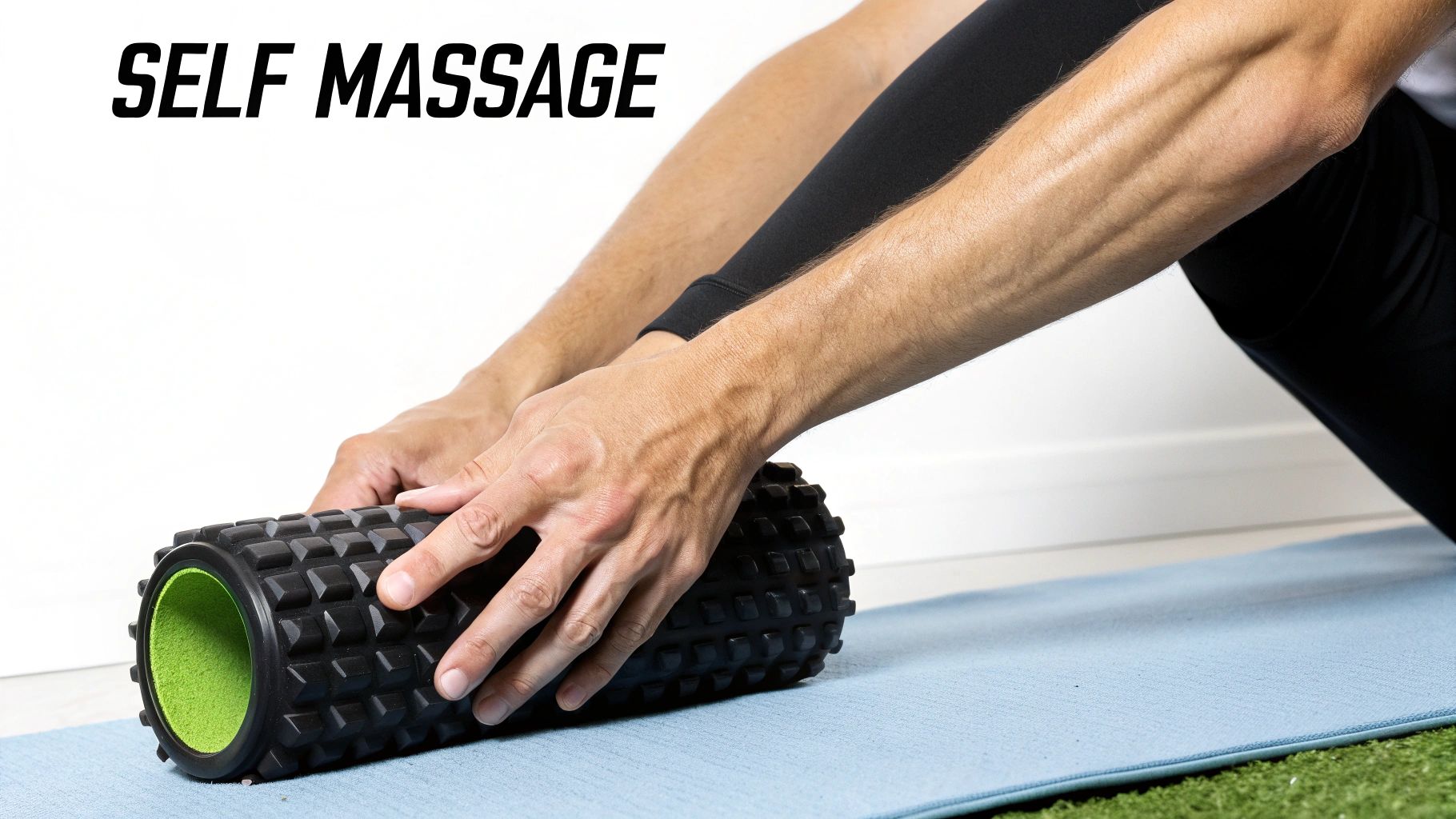
While self-massage gives you incredible control over your day-to-day muscle care, it’s just as important to know its limits. Think of it as first aid for muscle stiffness—perfect for general soreness and minor knots. But it's not a replacement for a professional diagnosis when something more serious might be going on.
Understanding the difference is key to staying safe and getting the right treatment. Your body is pretty good at telling you when a problem is beyond a DIY fix. Learning to listen to those signals is a skill, just as valuable as mastering any massage technique. It’s all about being smart with your recovery.
Red Flags That Signal a Professional Visit
So, when should you put down the foam roller and pick up the phone? Certain symptoms are more than just typical muscle stiffness; they're your body's way of saying, "Hey, I need an expert opinion on this."
Keep an eye out for these red flags:
- Sharp, Shooting, or Radiating Pain: A dull ache is one thing, but a sharp pain that zips down an arm or leg could point to nerve involvement.
- Numbness or Tingling: That persistent "pins and needles" feeling or a loss of sensation isn't something to ignore. It’s a clear sign to see a doctor.
- Stiffness That Gets Worse or Won't Quit: If you’ve been diligently working on an area for a week with no improvement—or if the pain is actually increasing—it’s time for a professional to take a look.
- Visible Swelling or Bruising Without an Obvious Cause: Unexplained swelling or discoloration around a stiff muscle might be a sign of something more than just a simple knot.
The goal here isn’t to cause alarm, but to empower you. Recognizing these signs helps you avoid making a problem worse. It ensures you’re addressing the root cause, not just putting a band-aid on the symptoms.
The Proven Power of Professional Care
When you see a qualified professional, you’re getting a level of care that can deliver some pretty significant results. Their expertise goes far beyond just rubbing a sore spot; they have a deep understanding of how your body's systems all work together.
The science backs this up, too. A comprehensive analysis of multiple studies confirmed just how effective professional massage is. It found that massage significantly reduced muscle soreness at 24 hours, 48 hours, and even 72 hours after a session. It didn’t just make people feel better—it also measurably improved their muscle function. You can dive into the full study about massage and muscle recovery to see the data for yourself.
This shows that getting a professional massage for muscle stiffness is a powerful move for both pain relief and real, functional recovery. It helps get you back to feeling and performing your best, safely and effectively.
Got Questions About Massage and Stiffness? We’ve Got Answers.
As you start exploring massage to ease muscle stiffness, you're bound to have some questions. It’s totally normal. Getting the right information is the key to feeling confident and making sure you’re getting the most out of every session, whether you’re at home or with a pro. Let’s dive into some of the things people ask me all the time.
How Often Should I Be Doing This?
This is easily the number one question I get. The honest answer? It really depends on your body, your lifestyle, and what you’re trying to achieve. While there’s no magic number, I can give you some solid guidelines based on my experience.
For your at-home toolkit—think foam rollers and massage balls—a good rhythm for general upkeep is 3 to 5 times a week. If you’ve just crushed a hard workout or a long run, don't be afraid to use them daily for a few days to speed up recovery. Just keep the sessions brief and to the point, maybe 10-15 minutes targeting the big, overworked muscle groups.
Now, for professional massage, it's a different ballgame that often comes down to your specific needs and, let's be real, your budget.
- Tackling Chronic Issues: If you're dealing with stubborn, long-term stiffness, getting on the table every 1-2 weeks can be a game-changer. This frequency really helps break the cycle of tension.
- General Wellness and Prevention: If you're looking to stay loose and keep stress from building up, a monthly massage is a fantastic routine. It’s like a regular tune-up for your body.
Is It Normal to Be Sore After a Deep Tissue Massage?
Yes, absolutely. A little soreness the day after a deep tissue or sports massage is completely normal. We often call it post-massage soreness, and it feels a lot like the ache you get after a good, challenging workout.
Think of it this way: your therapist is manually breaking up adhesions and tight knots that have been stuck deep in your muscles for a while. This process intentionally creates a small, controlled inflammatory response, which is actually the first step in your body's healing process. This feeling usually fades within 24 to 48 hours.
Here's the crucial part: you need to know the difference between "good sore" and "bad pain." A dull, tender ache in the muscles that were worked on is fine. Sharp, stabbing, or radiating pain is not.
To help yourself feel better faster, make sure you drink plenty of water after your appointment. This helps flush out all the metabolic byproducts released from your muscles. A gentle walk or some light stretching can also do wonders to keep things from tightening back up.
Could a Massage Actually Make My Stiffness Worse?
It’s rare, but yes, in certain situations, a massage can backfire. The biggest mistake I see is someone applying intense, deep pressure directly on an acute injury or a highly inflamed area. If you just pulled a muscle, for example, digging into it with a deep tissue massage can cause more damage and set your recovery back.
Using the wrong approach can also be a problem. A light, relaxing Swedish massage probably won't touch those deep, chronic knots, leaving you feeling like nothing happened. On the flip side, getting an aggressive sports massage when all you wanted was to de-stress might just leave you feeling beat up and more tense than when you walked in.
The takeaway is simple: listen to your body and talk to your therapist. A good professional knows when to back off and how to tailor the pressure. If you're doing self-massage, always start gently and immediately stop anything that causes sharp pain.
Ready to experience how a professional, targeted massage can help you? The expert therapists at La Moon Massage and Facial in Houston are here to help you relieve stiffness, reduce pain, and get your body back in balance. Book your session today and feel the difference for yourself.
Difference Between Sports Massage and Deep Tissue: Key Comparison

So, what's the real difference between a sports massage and a deep tissue massage? It really boils down to one simple question: are you trying to improve your athletic performance, or are you trying to get rid of nagging, chronic pain?
While both feel intense and get into the deeper layers of muscle, their goals are worlds apart. Think of it this way: a sports massage is a highly specialized tool for an athlete's body, while a deep tissue massage is a more universal solution for deep-seated tension anyone might experience.
Sports Massage vs. Deep Tissue: Which Is Right For You?
The core difference is all about intent. Sports massage was born out of the athletic world to help prevent injuries, prepare the body for intense activity, and speed up recovery. It zeroes in on the specific muscles you use for your particular sport.
On the other hand, deep tissue massage is designed to tackle chronic pain and stiffness—that nagging lower back ache from sitting at a desk or the tension in your shoulders that never seems to go away. It uses sustained, firm pressure to release those stubborn knots. For a deeper dive into their unique applications, you can learn more about the distinctions between sports and deep tissue massage.
This image perfectly captures the essence of a sports massage—it’s not just a general rubdown, but a targeted treatment focused on a specific muscle group to aid an athlete's recovery.
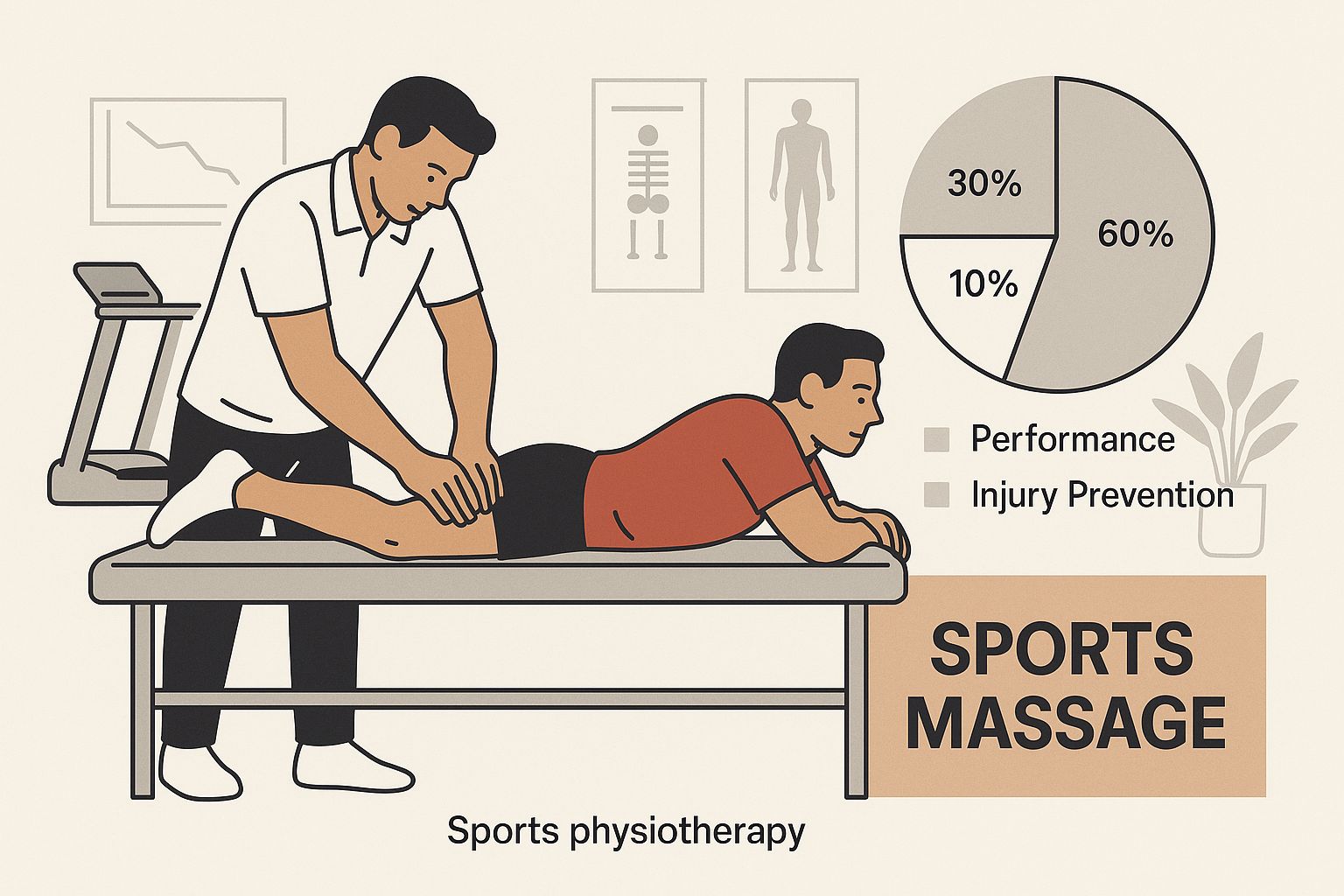
As you can see, sports massage is an integral part of a structured training and recovery regimen.
Here’s the simplest way I can put it: A sports massage therapist asks, "What activity are you training for?" A deep tissue therapist asks, "Where have you been hurting, and for how long?"
To help you decide, let's lay out the key differences side-by-side.
Sports Massage vs Deep Tissue Quick Comparison
Here's a quick cheat sheet to help you see the differences at a glance.
| Characteristic | Sports Massage | Deep Tissue Massage |
|---|---|---|
| Primary Goal | Enhance performance, prevent injury, and accelerate recovery. | Relieve chronic pain, break down adhesions, and improve posture. |
| Typical Use Case | Pre-event warm-up, post-event recovery, or training maintenance. | Persistent lower back pain, tension headaches, or stiff neck and shoulders. |
| Pressure & Style | Varies—can be fast and stimulating or slow and deep with stretching. | Slow, deliberate, and sustained firm pressure on deep muscle layers. |
| Ideal Frequency | Often weekly or bi-weekly during peak training seasons. | Usually every 2-4 weeks to manage chronic issues and allow for healing. |
Ultimately, this table highlights that your choice depends entirely on your immediate needs—whether that’s preparing for a marathon or finding relief from daily aches and pains.
Understanding the Purpose Behind Each Massage
To truly get to the heart of the sports massage vs. deep tissue debate, you have to look past the techniques and ask one simple question: What's the goal? They each answer a very different call from your body. One is all about function and performance, while the other is focused squarely on resolving chronic pain and tension.
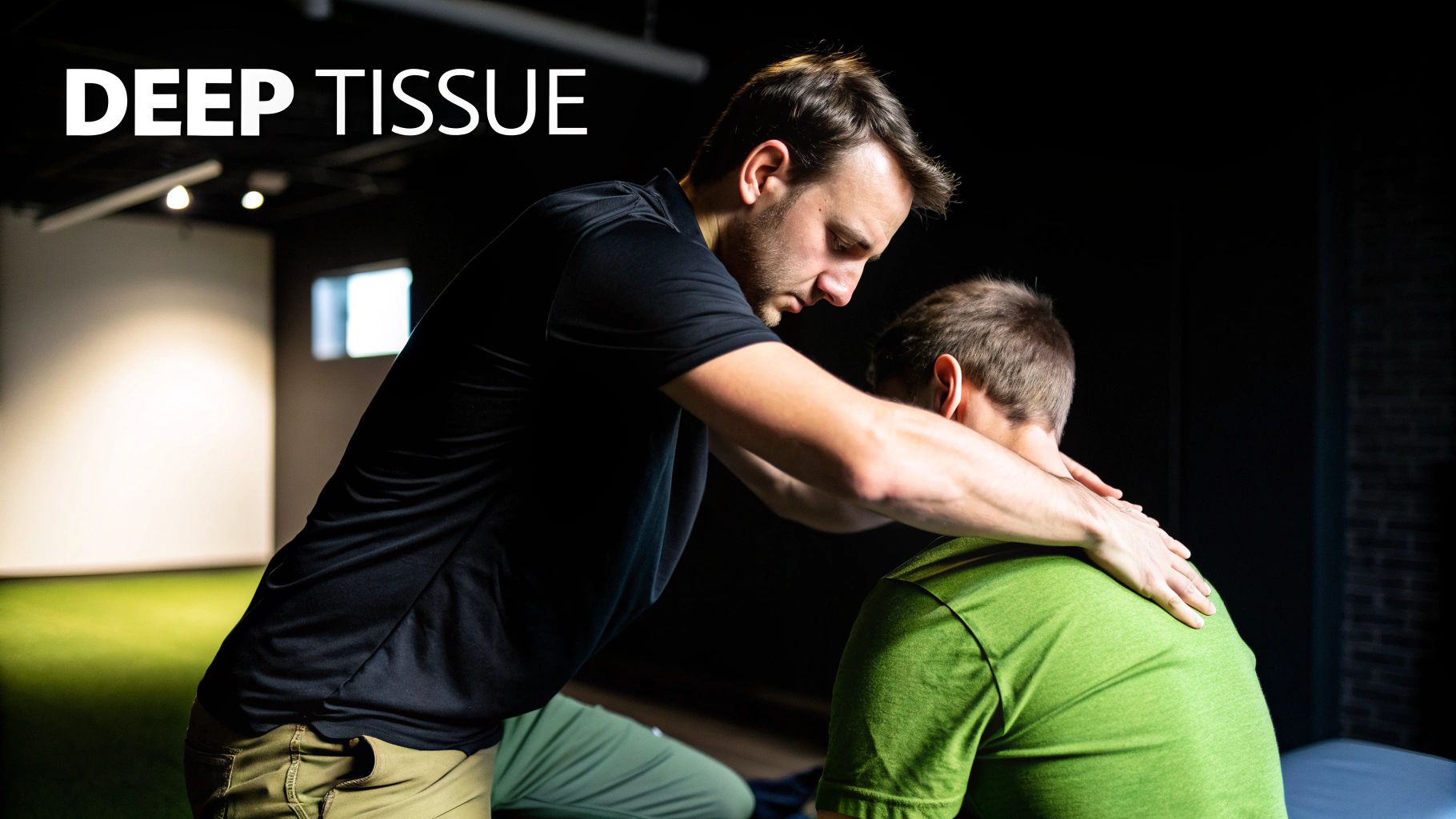
The entire philosophy of a sports massage is woven into an athlete’s training cycle. It's not a one-off treat; it’s a strategic part of a bigger plan. The main objectives are prepping the body for intense effort, speeding up recovery after a big event, and keeping muscles healthy to sidestep injuries down the road.
Functional Performance vs. Therapeutic Relief
Think of sports massage therapy as a proactive tool you use to boost your physical potential. A marathon runner, for instance, might get a quick, stimulating massage before a race to wake up their leg muscles. After they cross the finish line, they’d get a different, more restorative massage to help flush out metabolic waste and ease soreness. The application is always tied to a specific athletic goal.
Deep tissue massage, on the other hand, comes from a place of therapeutic relief. Its job is to tackle chronic problems like that nagging lower back pain from sitting at a desk all day, postural misalignments, or stubborn knots—what we call adhesions—that have settled in over months or years. Here, the aim isn't about running faster; it's about restoring comfort and normal movement to muscles that have been causing you trouble.
Here's the key takeaway: Sports massage is part of a training regimen to optimize how your body performs. Deep tissue massage is a targeted solution for long-term pain and deep-seated muscle tension, whether you're an athlete or not.
This difference in purpose really dictates who benefits most. While anyone can get a sports massage, it's typically used by athletes and highly active people as a regular part of their routine. You can learn more about why sports massage therapy is your recovery game-changer in our dedicated guide.
Conversely, deep tissue massage serves a much wider crowd. It's for the office worker with stiff shoulders, the weekend warrior with a persistent hamstring issue, or anyone dealing with chronic aches. Your choice really boils down to whether your objective is performance-driven or pain-related.
Comparing Massage Techniques and Application
When you’re actually on the massage table, the hands-on differences between sports massage and deep tissue become crystal clear. One feels like a focused, dynamic tune-up for your muscles, while the other is more of a slow, methodical mission to release deeply ingrained tension. The entire experience is dictated by the end goal.
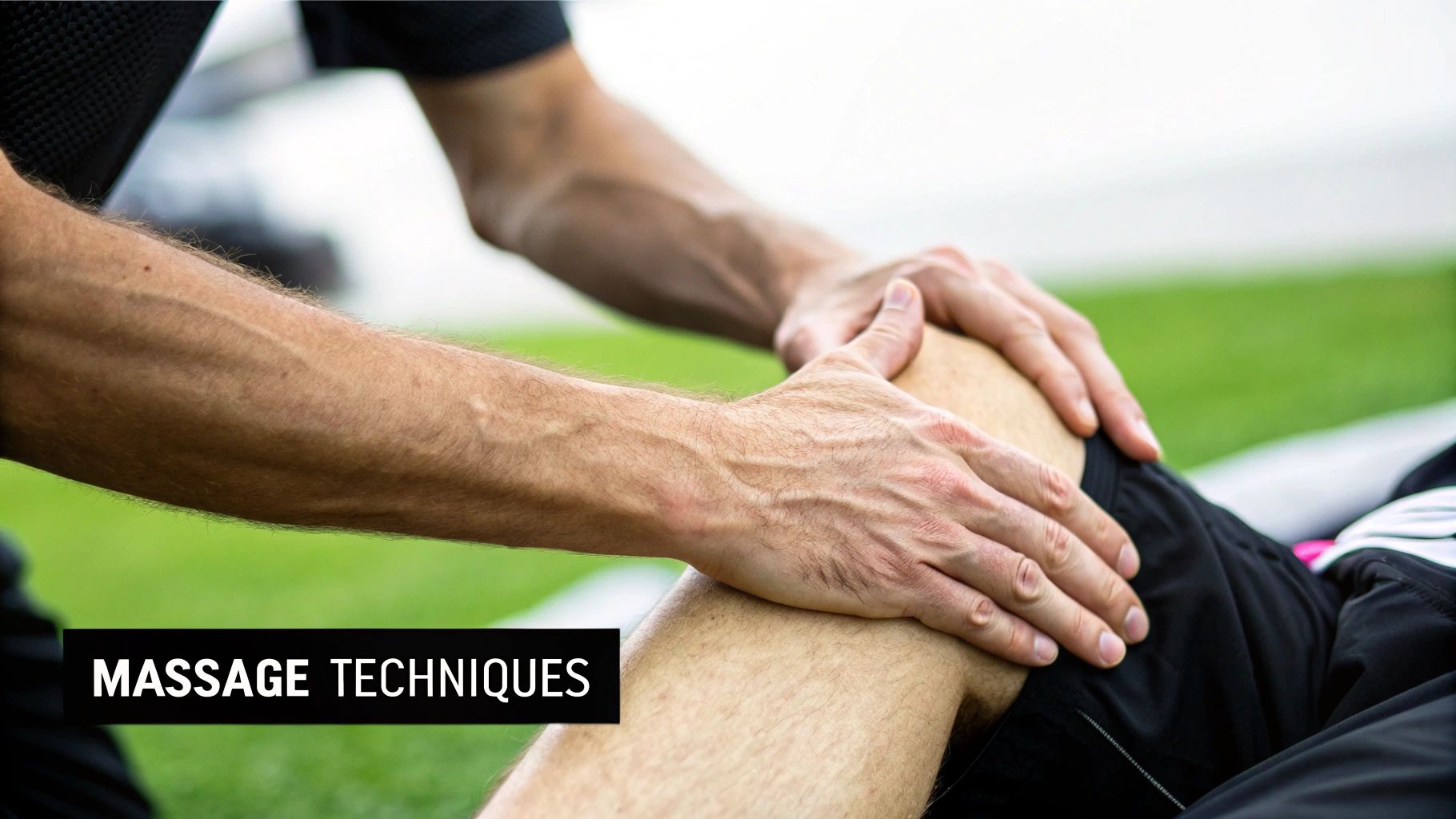
A sports massage session is almost never a passive experience. Your therapist will likely use a whole toolkit of techniques, sometimes in quick succession, to either prepare your muscles for action or help them recover afterward.
- Active Engagement: This is a big one. It often involves assisted stretching, where the therapist guides your limbs through specific ranges of motion to boost flexibility.
- Varied Strokes: You might experience brisk, stimulating strokes (tapotement) to wake up muscles before an event, or targeted friction applied directly to a stubborn adhesion.
- Dynamic Application: The pressure and speed are constantly adjusted based on where you are in your training cycle. It’s an active, collaborative process.
Methodical Strokes Versus Dynamic Movement
Deep tissue massage, on the other hand, is all about its slow, deliberate pace. The therapist applies sustained, intense pressure—often using their knuckles, forearms, or even elbows—to access those deeper layers of muscle and fascia. The aim isn't to energize the muscles, but to methodically "melt" away the chronic knots and adhesions that cause pain and limit your movement.
The core technical difference is this: Sports massage uses varied, active techniques tailored to an athletic function. Deep tissue massage uses slow, sustained pressure to resolve deep, chronic tension patterns.
While both can feel intense, the sensation itself is quite different. A sports massage might have brief, sharp moments of discomfort during friction or stretching, but it's part of a constantly changing sequence. Deep tissue maintains a consistent, firm pressure on specific trouble spots until they release. This distinction is crucial; it’s not just a regular massage with more oomph.
For a deeper dive into these nuances, check out our guide on sports massage vs regular massage. Ultimately, the how of each massage directly serves its unique purpose—one is for performance, the other is for chronic pain relief.
What Results Can You Actually Expect?
When you’re trying to choose between these two powerful therapies, it’s all about knowing what you want to achieve. Both will help ease tight muscles, but the tangible results they deliver are worlds apart. This is where the difference between sports massage and deep tissue really comes into focus.
Think of a sports massage as a tune-up for your body, with results geared toward performance and recovery. You’ll walk away with a noticeable improvement in flexibility and range of motion in the specific muscles that were worked on. But for most athletes, its biggest win is how it helps you bounce back after training.
Recovery Enhancement vs. Chronic Pain Relief
For anyone dealing with the fallout from intense activity, a sports massage can be a game-changer. It’s fantastic for healing athletic injuries like shin splints and actively reduces the misery of delayed onset muscle soreness (DOMS)—that all-too-familiar ache that sets in a day or two after a hard workout.
Key Insight: A 2020 meta-analysis confirmed that sports massage provides a small but statistically significant improvement in flexibility and a reduction in DOMS. This makes it an incredibly valuable tool for managing recovery and staying on top of your game.
Deep tissue massage, on the other hand, is designed to resolve problems that have been around for a while. The main goal here is significant, lasting relief from chronic pain, like that nagging lower back ache or the stubborn tension that’s taken up residence in your neck and shoulders.
People often report better posture after a deep tissue session. That's because releasing those tight, shortened muscles allows your body to settle back into a more natural, comfortable alignment. It also excels at breaking down old scar tissue and adhesions, which frees up movement and eases stiffness that might have been building for years.
In short, sports massage gets your body primed for peak performance, while deep tissue works to undo chronic pain patterns and restore long-term function.
When to Choose Sports Massage vs. Deep Tissue
Figuring out whether you need a sports massage or a deep tissue massage really boils down to what you’re trying to achieve right now. The best choice depends entirely on your immediate goals, your activity level, and the kind of pain or stiffness you're experiencing.
Let's cut through the noise and look at real-world situations. This will give you a much clearer picture of which massage is the right tool for the job.
Scenarios Where Sports Massage Is Best
A sports massage is the clear winner when your body’s needs are tied directly to athletic performance. Think of it as a functional therapy designed to support your training, competition, and recovery cycle. It's not about general relaxation; it's about results.
You should book a sports massage if:
- You're gearing up for a big race or game: A pre-event massage is all about preparation. It uses quick, stimulating strokes to warm up the exact muscles you'll be using, boosting blood flow and getting your body primed for intense effort.
- You just crossed the finish line: A post-event massage is a non-negotiable part of smart recovery. The techniques help flush out lactic acid and other metabolic byproducts, calm your nervous system, and dramatically reduce post-exercise soreness.
- You're deep into a tough training schedule: Regular maintenance massages are your secret weapon against injury. A good therapist can find and work out muscle imbalances or adhesions before they sideline you, keeping your body fine-tuned.
Situations That Call for a Deep Tissue Massage
Deep tissue massage shines when you’re dealing with stubborn, chronic pain and tension that has settled in deep. It’s the ideal choice for long-term issues that impact your daily life, whether you're an athlete or not. While many active people get them, you can learn more about the specific benefits by reading about deep tissue massage for athletes.
You should book a deep tissue massage if:
- You have "desk-jockey" pain: That constant ache in your lower back or the rock-solid knots in your neck and shoulders from sitting at a computer are exactly what deep tissue work is designed to fix.
- You're dealing with a chronic condition: People managing issues like fibromyalgia, sciatica, or recurring tension headaches often get incredible relief from the slow, deliberate pressure that releases deep-seated trigger points.
- You have lingering stiffness from an old injury: Deep tissue is fantastic for breaking down old scar tissue and adhesions that restrict your movement. It helps restore flexibility to areas that have felt tight for months or even years.
Common Questions, Answered by the Experts
Even after comparing the two side-by-side, you might still be weighing your options. That's perfectly normal. Let's dig into a few of the most common questions we hear from clients to clear things up and help you decide.
Which One Hurts More?
This is a tricky one because pain is so personal, but most people will tell you that deep tissue massage feels more consistently intense. The whole point is to apply slow, deliberate pressure to break up stubborn knots, and that process can definitely be uncomfortable.
A sports massage has its moments, for sure. Think about a therapist working with friction on a tight IT band or guiding you through a deep, assisted stretch. Ouch. But the overall session usually blends that intensity with more relaxing, flushing strokes. No matter which you choose, talking to your therapist is non-negotiable. It's the only way to keep the pressure productive, not painful.
A Pro's Take: A good therapist knows the difference between "good pain" and "bad pain." As a rule of thumb, the pressure should never go above a 7 or 8 on a 1-10 scale. You need to be able to breathe through it. If you find yourself tensing up and fighting against the pressure, it's too much.
Can I Use a Deep Tissue Massage for Sports Recovery?
It seems like it would make sense, right? But using a deep tissue massage for immediate post-game recovery is usually a bad idea. After intense activity, your muscles are already inflamed and tired. The focused, sometimes aggressive nature of deep tissue work can actually make that inflammation and soreness worse.
This is where sports massage truly shines. It’s built for recovery. Post-event techniques focus on things like light, flushing strokes that help clear out lactic acid and other metabolic byproducts. It promotes healing without adding extra stress to your already overworked muscles.
How Often Should I Get One?
The ideal schedule really comes down to your body, your budget, and your goals. There's no one-size-fits-all answer.
- For sports massage: If you're an athlete deep in a training block, getting a massage weekly or every other week is a great strategy for maintenance and keeping injuries at bay.
- For deep tissue massage: Because the work is so intensive and meant to create lasting change, you'll want more recovery time. Scheduling sessions every 2-4 weeks usually gives your body the time it needs to heal and adapt.
Your best bet is to talk it over with a qualified therapist. They can assess your specific situation and recommend a frequency that will give you the best results.
Ready to address your specific needs with a targeted massage? The expert therapists at La Moon Massage and Facial are here to help you choose the right therapy to relieve pain, enhance performance, and restore your body. Book your personalized massage session in Houston today!
Massage for Back Pain Relief: Find Lasting Comfort

If you've ever found yourself wondering whether a massage can really do anything for your back pain, you're not alone. The simple answer is yes, absolutely. It's more than just a feel-good luxury; a proper massage triggers real, beneficial changes in your body to fight pain, melt away chronic tension, and help injured muscles heal. It's a time-tested, hands-on path to finding genuine relief.
How Massage Actually Works to Relieve Back Pain
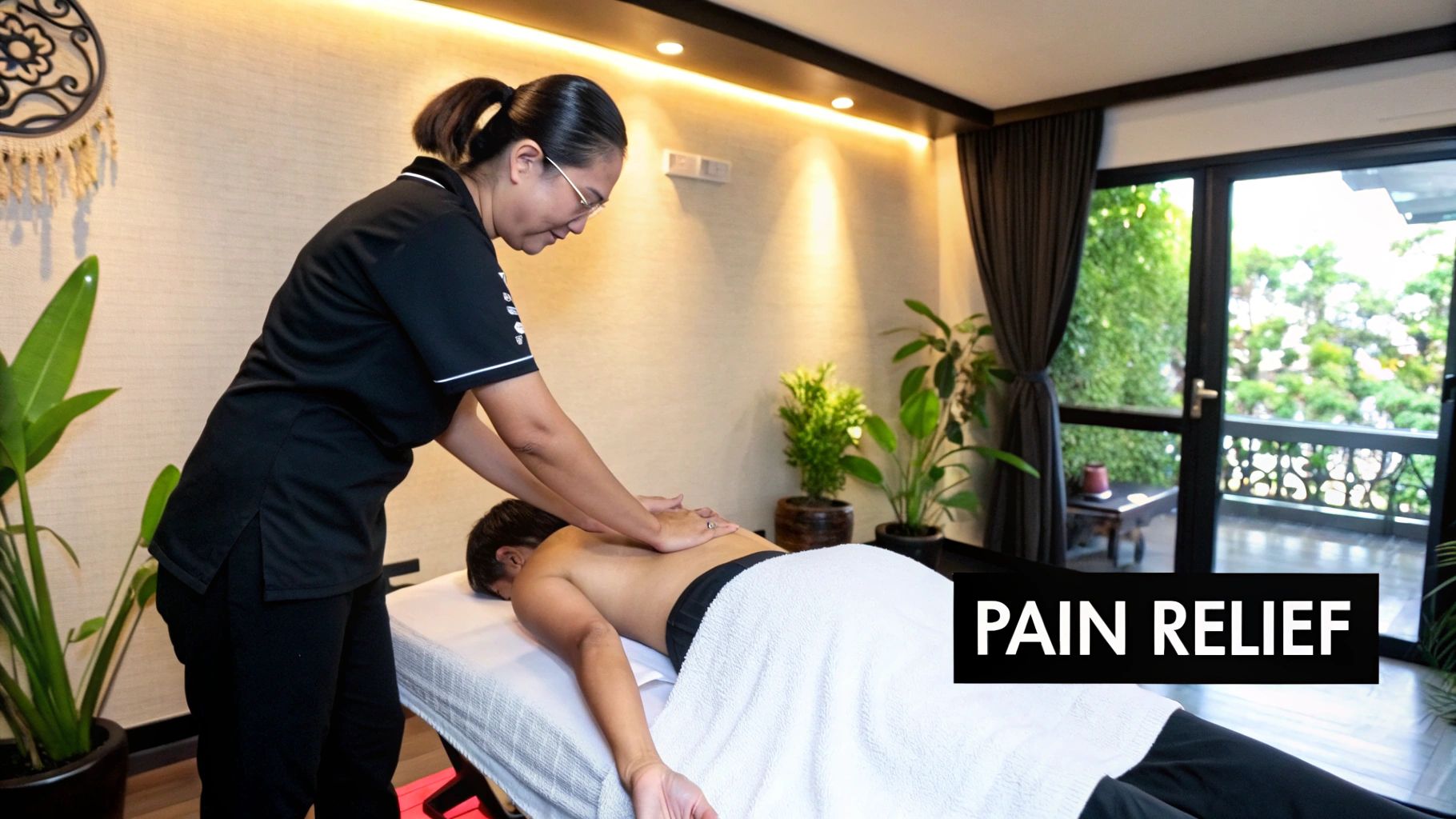
When your back starts aching, what's your first instinct? For most of us, it's to rub the sore spot. That simple, intuitive action is a window into the powerful science behind professional massage therapy. It’s not just wishful thinking—there are concrete reasons why massage is so effective for everything from a sudden twinge to persistent, nagging discomfort.
The scale of back pain is just staggering. In 2020, it affected 619 million people around the globe, and experts predict that number could swell to 843 million by 2050. It's no wonder that in the U.S., nearly 43% of people who get a massage are doing it for health reasons like pain management.
To help you understand exactly how it works, here's a quick summary of the main ways massage therapy helps ease back pain.
Quick Overview of How Massage Eases Back Pain
| Mechanism | How It Relieves Back Pain |
|---|---|
| Increased Circulation | Delivers fresh, oxygen-rich blood to tight muscles, flushing out inflammatory waste products that cause soreness. |
| Muscle Relaxation | Manually softens and lengthens tense muscle fibers, breaking the "pain-spasm-pain" cycle of chronic discomfort. |
| Endorphin Release | Triggers the body's natural painkillers and mood elevators, offering immediate pain relief and a sense of well-being. |
| Reduced Cortisol | Lowers levels of the stress hormone cortisol, which can otherwise increase muscle tension and pain sensitivity. |
Let's dive a little deeper into these points.
Boosting Blood Flow to Heal and Soothe
One of the most immediate benefits of massage is how it jump-starts circulation. When your muscles are tight and knotted up, blood flow gets restricted. Think of it like a traffic jam on a highway—nothing can get through efficiently. This slowdown traps metabolic waste and prevents healing nutrients from reaching the tissue.
A massage therapist acts like a traffic controller, physically manipulating the tissue to break up that congestion. The pressure and gliding strokes encourage fresh, oxygenated blood to flood the area. This influx of blood is crucial; it not only delivers the building blocks for repair but also helps flush out the inflammatory byproducts that make you feel sore. The result is less pain and a faster recovery.
Releasing Tension and Breaking the Pain Cycle
Chronic back pain loves to create a vicious cycle. The initial pain makes you tense up your muscles as a natural defense. But that constant tension creates more soreness, which leads to even more guarding and tension. It's a feedback loop that's hard to escape.
This is where a skilled massage therapist can make a world of difference. By applying focused, sustained pressure to those stubborn knots (often called trigger points), they can coax the muscle fibers to release. This doesn't just feel good in the moment; it helps interrupt that pain-spasm-pain cycle and retrains your muscles to exist in a more relaxed, natural state. If you're dealing with stubborn pain, our guide on pain relief massage therapy goes into more detail on these specialized techniques.
A key benefit of massage is the release of endorphins. These are your body's natural painkillers and mood elevators. A good massage can trigger a rush of these feel-good chemicals, providing immediate pain relief and a sense of well-being that can last long after your session ends.
Finally, never underestimate the role of stress. When you're stressed, your body pumps out cortisol, a hormone known to increase muscle tension and make you more sensitive to pain. By promoting deep relaxation, massage helps lower your cortisol levels, directly calming the physical toll that stress takes on your back.
Choosing the Right Professional Massage Therapist
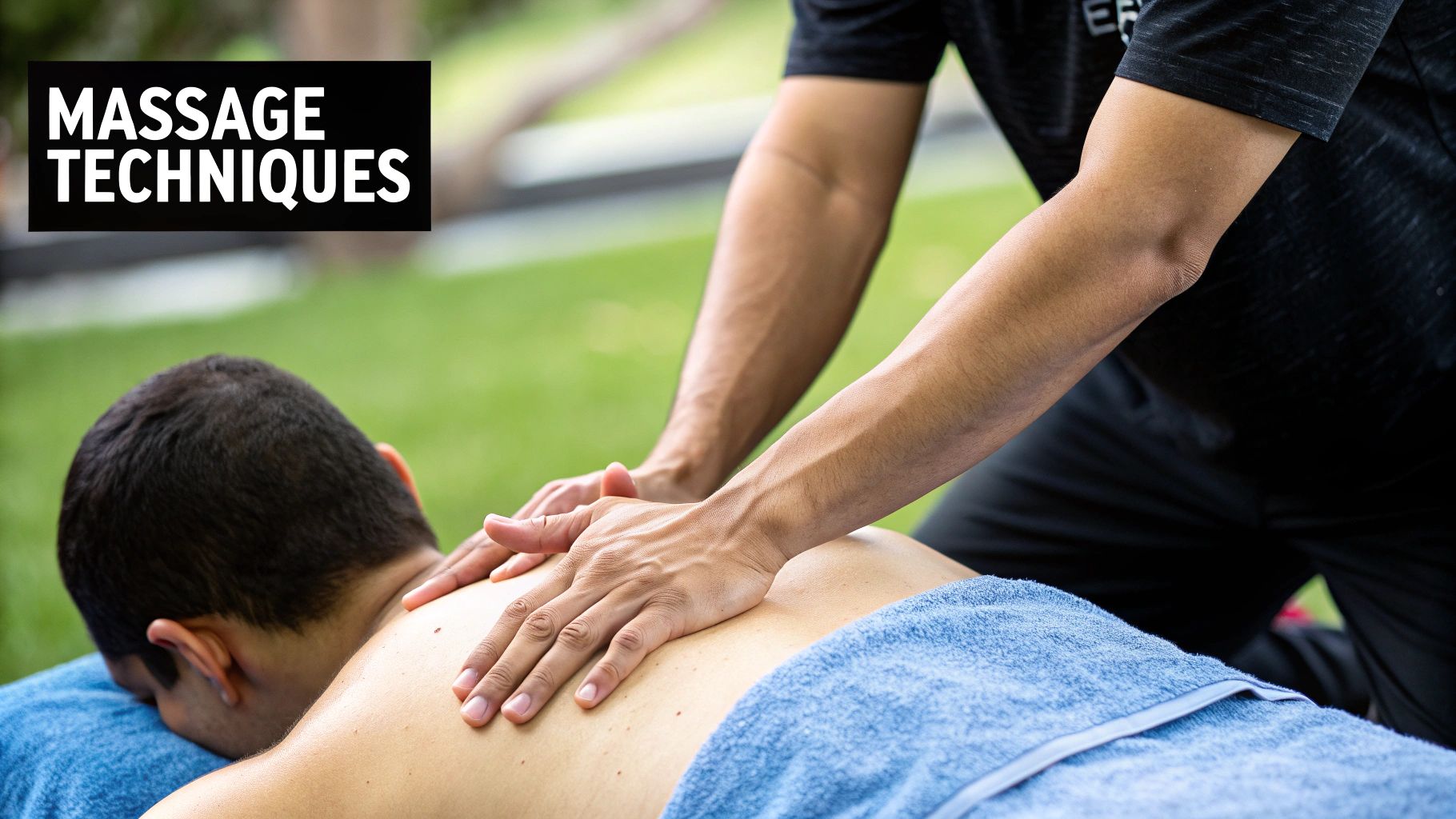
Finding a massage that actually helps your back pain goes far beyond the technique itself. The real magic happens when you find the right therapist. A skilled professional can take a massage from a pleasant hour on the table to a genuinely effective, healing treatment.
It’s important to remember that not every therapist is a pain management specialist. So, knowing what to look for is your first and most critical step.
Your initial check should always be for credentials. Is the therapist a Licensed Massage Therapist (LMT)? This isn't just a fancy acronym; it's your assurance that they've completed hundreds of hours of formal training and passed a state board exam, guaranteeing a professional standard of knowledge and safety.
From there, dig a little deeper into their specializations. Therapists with advanced certifications in modalities like neuromuscular therapy or myofascial release are often the best bet for chronic back pain. They’ve invested extra time and training to understand the complex mechanics of pain and how to relieve it.
How to Find Your Ideal Therapist
So, where do you start looking? A referral from a trusted doctor or physical therapist is always a great starting point. But don't discount the power of a smart online search. Instead of just googling "massage," get specific. Try searching for phrases like "massage for lower back pain Houston" or "deep tissue therapist near me" to find practitioners who focus on your needs.
Once you have a shortlist, it's time to do some homework. Scrutinize their online presence for a few key things:
- Detailed Service Descriptions: Do they talk specifically about their approach to pain relief, or are their offerings vague, focusing only on "relaxation"? You want someone who speaks your language.
- Client Testimonials: Look for reviews from people who had issues similar to yours, whether it's sciatica, herniated discs, or persistent upper back tension. Their success stories are a good sign.
- A Professional Website: A clean, easy-to-navigate website is often a reflection of a therapist's professionalism and dedication to their craft.
Pro Tip: As you browse, you'll see different styles of massage mentioned. It can be helpful to understand the nuances, for example, between a sports massage vs a regular massage. Each is designed with a different goal and intensity in mind.
Communicating Your Pain for Better Results
You've found someone who looks promising and booked an appointment. Great! Now comes the most important part: the conversation. Your initial consultation is where you build the foundation for a successful treatment.
This is your chance to go beyond simply saying, "My back hurts." Think about how you can describe your pain with more detail. A good therapist will use this information to customize your session.
Try to pinpoint the nature of your discomfort. Is the pain:
- Dull and aching, like a constant, nagging throb?
- Sharp and shooting, like a lightning bolt?
- Burning or tingling, which could point to nerve irritation?
- Radiating from one spot to another, like from your back down your leg?
Also, let them know what makes the pain better or worse—sitting for too long, standing, bending a certain way. The more specific you are, the more targeted and effective your massage will be. A little prep, like drinking plenty of water before you arrive, can also go a long way by making your muscle tissue easier to work on. This dialogue is what transforms a generic massage into a personalized therapy session that brings real relief.
Matching the Massage Style to Your Back Pain
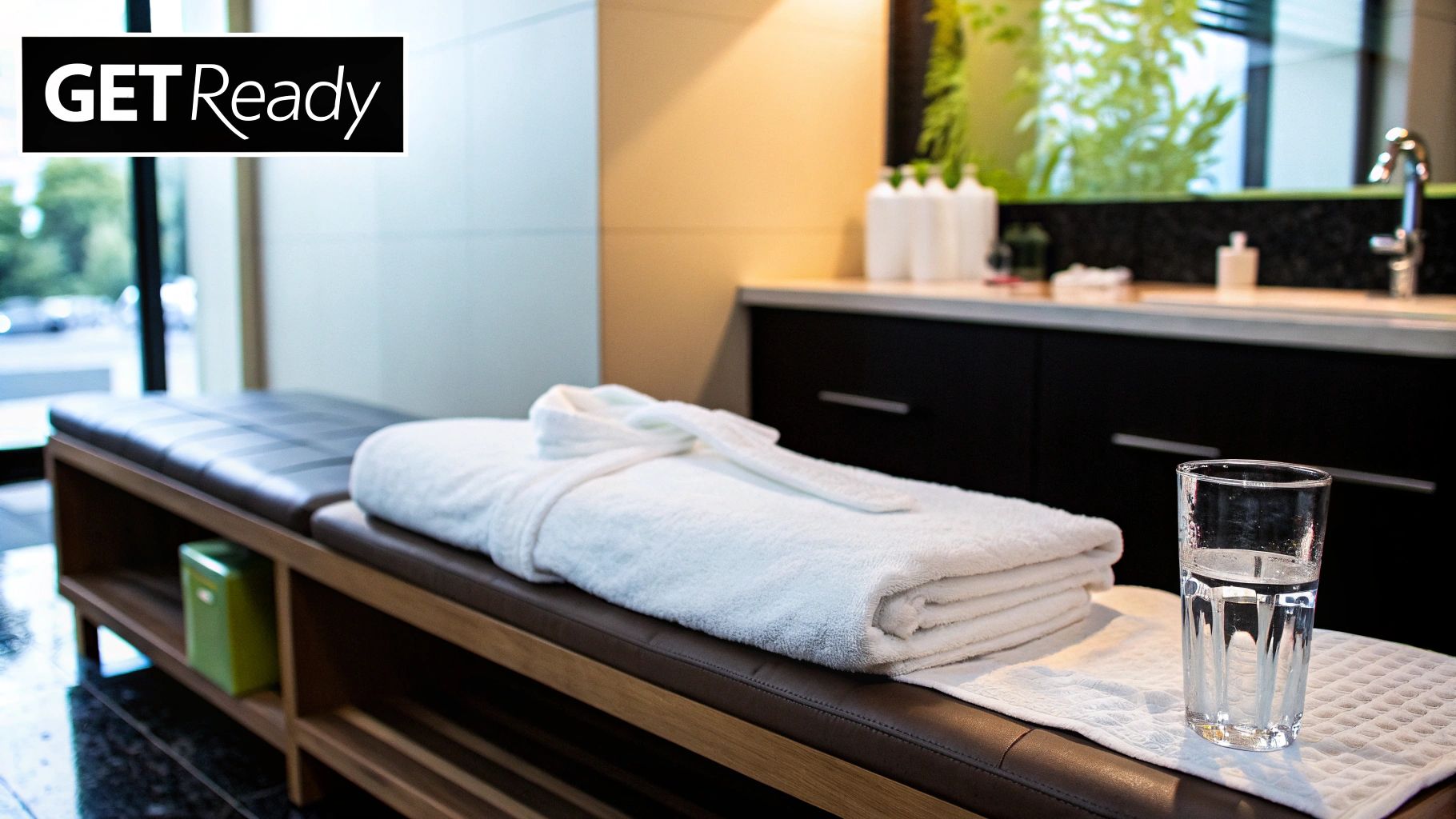
Walking into a spa and seeing a menu of massage styles—Swedish, Deep Tissue, Trigger Point—can feel a lot like trying to order from a menu in a foreign language. It's easy to get overwhelmed. But figuring out which one is right for you is the secret to getting a truly effective massage for back pain relief, not just a relaxing hour on the table.
Choosing the right massage isn't just a matter of personal preference. It's about matching the therapist's technique to the root cause of your pain. A gentle, flowing massage won't touch a deep, chronic knot, while an intense deep tissue session could be overkill if you're just dealing with general soreness.
Swedish Massage for General Soreness and Stress
Swedish massage is what most people imagine when they think of a classic massage. It’s built around long, gliding strokes (known as effleurage), combined with kneading, friction, and even some light tapping. The main goal here is relaxation and easing overall muscle tension.
This is the perfect choice if your back pain is a dull, widespread ache that you suspect comes from stress or too much time hunched over a computer. A good Swedish massage gets the blood flowing, which helps flush out the metabolic byproducts that make muscles feel sore and tired.
- Best for: General muscle tightness, stress-related backaches, and anyone who is new to massage.
- What to expect: A soothing and deeply relaxing session using light to medium pressure.
Deep Tissue Massage for Chronic Pain and Knots
When your pain feels stubborn, deep, and stuck in one area, a Deep Tissue massage is probably what you need. This style uses slower, more forceful strokes to reach the deeper layers of your muscle and connective tissue. It's specifically designed to break up old scar tissue and the adhesions—what we usually call "knots"—that can restrict movement and cause chronic pain.
There’s a common myth that deep tissue has to be painful to work. That's not true. An experienced therapist will communicate with you, finding a pressure that feels intense but productive—what many people call a "good hurt." This technique is fantastic for nagging issues like a constantly tight lower back or knots between the shoulder blades that never seem to go away.
Deep Tissue is a powerful treatment, but it isn't for everyone. Open communication with your therapist about the pressure is crucial. Don't be surprised if you feel a little sore for a day or two afterward; it's a lot like the feeling you get after an intense workout.
Trigger Point Therapy for Specific Pain Referral
Have you ever found a tender spot in your shoulder, and when you press on it, you feel a sharp pain shoot up into your neck or head? That’s a trigger point. It's a tiny, hyper-irritable knot in your muscle tissue that can refer pain to completely different areas of the body.
Trigger Point Therapy is all about locating and releasing these specific points. The therapist applies direct, sustained pressure to the knot until the muscle finally lets go. This can bring incredible massage for back pain relief, especially if your issue is a stubborn knot causing sciatica-like symptoms or tension headaches that start in your upper back. This technique is often woven into a broader Deep Tissue or Swedish massage.
- Best for: Those tight, specific knots that cause pain to radiate to other areas.
- What to expect: Very focused and sometimes intense pressure on small, specific spots, usually followed by a significant feeling of release.
At-Home Self-Massage Techniques for Immediate Relief
While nothing beats a session with a professional, you can't always get to a therapist the moment a flare-up strikes. That’s where knowing how to manage your own pain becomes a game-changer. The right at-home self-massage techniques can offer immediate relief, putting you back in control.
The best part? You don't need a lot of fancy equipment. The core principles of massage—releasing muscle tension, boosting circulation, and calming angry nerves—can be achieved with simple tools and smart techniques that target those all-too-common pain points.
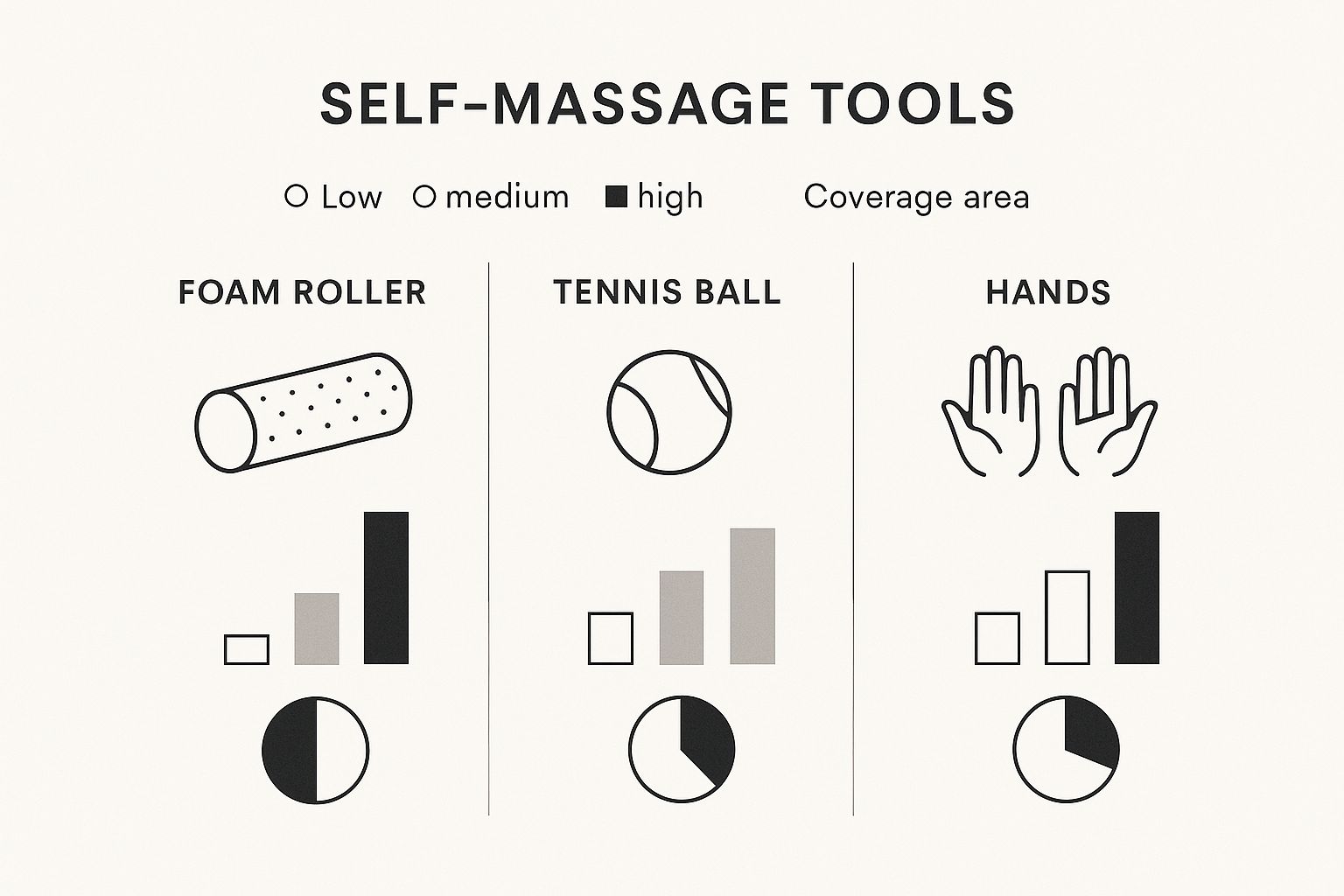
Simple Tools, Powerful Relief
Often, the most effective tools for self-massage are things you already have lying around the house. Think about a simple tennis ball. By placing it between your back and a wall, you can lean into it and get precise, controlled pressure right where you need it most.
A foam roller is another fantastic ally, especially for the broad muscles of the upper back. Just lie on the floor with the roller placed horizontally under your shoulder blades. Bend your knees, plant your feet on the floor, and use your legs to gently roll your body up and down. You’ll feel the roller working its magic on the tense muscles that run between your spine and shoulder blades—a common trouble spot from desk work.
A Quick Word on Safety: Your body is the expert here, so listen to it. Never roll directly over your spine or any bony areas. If you feel a sharp, shooting, or electric-like pain, back off immediately. We're aiming for a "good hurt"—that deep, releasing sensation—not actual pain.
Targeting Your Lower and Upper Back
For that nagging ache deep in your lower back, a tennis ball or a firmer lacrosse ball is perfect. Stand with your back to a wall and place the ball right on the fleshy muscle to the side of your spine (never directly on it). Gently bend your knees to roll the ball up and down, and you can even shift your weight side-to-side to hunt down those really tender spots.
When you find a knot, just pause. Hold the pressure steady for 20-30 seconds and focus on taking slow, deep breaths. You’ll feel the muscle start to give. This same technique works wonders for knots between your shoulder blades and in your upper traps.
To help you choose the right tool for the job, here's a quick comparison of the most common options and what they're best for.
Self-Massage Tools and Their Target Areas
| Tool | Best For | How to Use for Back Pain |
|---|---|---|
| Foam Roller | General muscle tightness, warming up larger muscle groups. | Lie on the floor and roll it under your upper or mid-back to release broad tension. |
| Tennis Ball | Pinpointing specific knots and trigger points in the lower and upper back. | Place it between your back and a wall for precise, controlled pressure on tight spots. |
| Lacrosse Ball | Deeper, more intense pressure on stubborn knots. For those who need more than a tennis ball. | Use it like a tennis ball against a wall, but expect a much firmer, more focused feel. |
| Massage Cane | Reaching difficult spots in the upper back, shoulders, and neck without straining. | Hook the cane over your shoulder and pull the handle to apply pressure to knots you can't reach. |
Each tool offers a different experience, so it's worth experimenting to see what your muscles respond to best.
Don't underestimate the power of these simple routines. Consistency is key. The potential for massage as an accessible, effective treatment is well-supported. In one case study, a 63-year-old man with chronic back pain saw significant improvements in his ability to walk and a reduced need for pain medication after just four massage sessions. You can learn more about how massage helped him on his journey by checking out the full story on IJTMB.org.
Here are a few tips I always give my clients for getting the most out of their self-massage:
- Warm up your muscles first. A few minutes with a heating pad or doing these moves after a warm shower makes a huge difference. Warm muscles are much more pliable.
- Don't forget to breathe. Deep, conscious breathing signals your nervous system to relax, which is essential for getting your muscles to let go of tension.
- Make it a habit. A few minutes every day is far more effective than one long, intense session once a week. This helps you stay ahead of the pain before it builds up.
Knowing When Massage Is Not the Answer
While a good massage can feel like a miracle for an aching back, it's not always the right move. I've seen firsthand how powerful massage can be for muscle pain, but it's crucial to understand its limits. Massage is not a cure-all, and jumping in at the wrong time can sometimes do more harm than good.
The most important thing is learning to listen to your body. There's a big difference between a tired, overworked muscle and something more serious. Your body has a way of telling you when the problem needs a doctor, not a massage therapist. Ignoring these warning signs can mean delaying critical medical care.
Red Flags That Mean "Call Your Doctor"
If your back pain comes with any of the symptoms below, stop what you're doing and get professional medical advice. These aren't things to guess about. They can point to underlying issues that massage can't fix and might even aggravate.
- Fever or Chills: When back pain is paired with a fever, it’s a classic sign of a potential infection that needs immediate attention from a doctor.
- Sudden Weakness or Numbness: If you suddenly feel weakness, numbness, or a "pins and needles" sensation in your legs, feet, or groin, it could be a sign of serious nerve compression.
- Loss of Bladder or Bowel Control: This is a medical emergency. It can signal severe spinal cord pressure and requires an immediate trip to the ER.
- Severe, Unrelenting Pain: Pain that is constant, excruciating, and doesn't get better or worse with movement or rest isn't your typical muscle ache.
My rule of thumb is simple: if the pain just feels "wrong" in a way that goes beyond a standard muscle pull or soreness, trust your gut. It's always, always better to be safe and get a proper diagnosis before trying any kind of massage.
Other Times to Steer Clear of Massage
Beyond those urgent red flags, there are other situations where you should avoid massage, at least on the affected area. In the industry, we call these contraindications.
- Acute Injuries: Right after a fresh injury like a sprain, strain, or fracture, the area is inflamed. Massaging it can increase that inflammation and get in the way of the body’s natural healing process. Let it rest first.
- Deep Vein Thrombosis (DVT): Anyone with blood clots or a history of them should absolutely avoid massage. The pressure could dislodge a clot, which can lead to a life-threatening pulmonary embolism.
- Certain Skin Conditions: You should never massage over open wounds, rashes, skin infections, or even severe eczema. It can make the condition worse and spread bacteria.
- Severe Osteoporosis: If you know you have severely brittle bones, even moderate massage pressure could be enough to risk a fracture.
Getting familiar with the different therapeutic approaches can help you understand what works for various types of discomfort. You can learn more about specialized back pain massage therapy to see how a professional might tackle specific issues when it's safe to do so. Ultimately, knowing when to go forward and when to hold back is the key to healing safely.
Your Top Questions About Back Pain Massage, Answered
If you're thinking about massage for back pain, you probably have a few questions. That's a smart place to start—you want to know what you’re getting into before investing your time and money. Let's walk through some of the most common questions I hear from clients, so you can feel confident about your next steps.
It's worth noting just how many people are turning to massage for relief. The massage therapy field is growing fast, with jobs expected to increase by 21% between 2019 and 2029. Americans got around 214 million massages in a single year recently, and with 88% of people agreeing it’s a great way to reduce pain, the results speak for themselves. You can dig into the full massage therapy profession stats to see how trusted this treatment has become.
How Often Should I Get a Massage for Chronic Back Pain?
This is the big one, and the honest, experienced answer is: it really depends. There's no one-size-fits-all schedule. The right frequency for you is a mix of factors—how severe your pain is, how long it's been a problem, your budget, and, most importantly, how your body reacts to the work.
For someone dealing with stubborn, chronic back pain, I usually suggest starting with a weekly session for the first four to six weeks. This gives us a real chance to get in there and make progress, breaking down those old, tight muscle adhesions and calming inflammation. Think of it as the initial push to get your body on the path to healing.
After that initial phase, we can re-evaluate together. Many people find they can maintain the relief and keep pain from creeping back with a maintenance session every two to four weeks.
It’s a bit like putting out a fire. The first few sessions are about dousing the flames. The follow-up appointments are about clearing the smoke and making sure no new embers can catch light.
Ultimately, your body is the best guide. If you notice that old, familiar ache returning after three weeks, that's your cue it's time to book your next massage.
Is It Normal to Feel Sore After a Deep Tissue Massage?
Absolutely. It's not only normal to feel a bit tender after a deep tissue or trigger point massage, but it’s often a sign that we accomplished what we set out to do. That feeling is called post-massage soreness, and it's a lot like the muscle soreness you’d feel a day or two after a really good workout at the gym.
During a deep tissue massage, a therapist uses firm, targeted pressure to break up those stubborn knots and get to the deeper layers of muscle. This process creates tiny, controlled micro-trauma in the muscle fibers—the same thing that happens when you build strength through exercise. Your body’s natural response is to send more blood flow to the area to repair it, which can cause that temporary tenderness.
The key is that it should feel like a dull, generalized ache, not a sharp, stabbing pain. This soreness typically fades within 24 to 48 hours. Here’s what you can do to feel better faster:
- Drink up. Hydrating with plenty of water helps your body flush out the metabolic byproducts released from your muscles.
- Take a warm soak. An Epsom salt bath is fantastic for soothing sore, tender spots.
- Stretch gently. A little light, gentle movement can keep you from feeling stiff.
Is Massage for Back Pain Covered by Insurance?
Now, this is where things can get tricky. While more and more insurance plans are starting to cover massage therapy, it’s far from a standard benefit. Whether you're covered often comes down to the fine print in your plan, your specific diagnosis, and if the massage is considered "medically necessary."
If you want to increase your chances of getting coverage, you'll almost certainly need a prescription or a formal referral from your doctor. This isn't just a casual note; it needs to be specific.
A helpful prescription will include:
- A clear diagnosis (like "lumbar strain" or "myofascial pain syndrome").
- The recommended frequency and duration (for example, "1x per week for 6 weeks").
- The specific type of massage required (such as "neuromuscular therapy").
Even with all that in hand, you might have to stick with an in-network therapist or pay for the session yourself and then submit the claim for reimbursement. Your best bet is to call your insurance company before you book an appointment. Ask them directly about your benefits for "manual therapy" or "massage therapy" so there are no surprises.
At La Moon Massage and Facial, we focus on therapeutic massage that delivers lasting relief from back pain. Our skilled therapists in Houston are here to design a treatment plan that’s right for your body. Book your session today and start your journey to a pain-free life.
Effective Massage for Muscle Pain Relief | Tips & Techniques
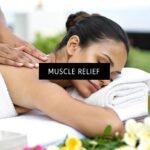
When your muscles are screaming for relief, a good massage isn't just a luxury—it's a legitimate, evidence-based therapy that can make a world of difference. It works by manipulating your body's soft tissues to boost blood flow, break up stubborn knots, and soothe your nervous system. The end result? Less pain and better movement.
Understanding How Massage Eases Muscle Pain
Let's get past the idea that massage is just for pampering. It's a powerful tool for managing and healing sore, overworked muscles. Think about what happens when you push your body too hard, sit at a desk all day, or recover from an injury. Your muscles can develop tiny tears and incredibly tight, painful knots, often called trigger points. These are what lock you up and cause that nagging ache.
A skilled massage therapist knows exactly how to tackle these issues head-on. The physical manipulation of muscle fibers delivers a few key benefits all at once:
- It gets the blood moving. The pressure and strokes from a massage push fresh, oxygen-rich blood into tissues that have been starved of it. This improved circulation is crucial for flushing out metabolic waste, like lactic acid, which is a major contributor to that post-workout soreness.
- It melts away tension. Techniques like sustained pressure and deep, gliding strokes physically break down those adhesions and knots. This process releases the muscle from a state of chronic contraction, restoring its natural flexibility and easing that stiff, guarded feeling.
- It calms everything down. Massage sends calming signals from your skin and muscles straight to your brain. This helps lower the body's production of stress hormones like cortisol while encouraging the release of feel-good chemicals like serotonin and dopamine, which are your body's own natural painkillers.
The Real Science Behind the Soothing Sensation
I often tell my clients to picture a knotted muscle like a tangled-up rope. It's stiff, it can't move properly, and it’s yanking on everything connected to it. A targeted massage works to patiently untangle that rope, fiber by fiber. This not only eases the immediate pain but also improves the overall health of the muscle, helping to prevent future problems.
This is especially true for the kind of pain that comes from our modern lives. Think about it: hours hunched over a laptop, repetitive movements from a job, or the aftermath of a weekend warrior's intense workout all create predictable patterns of chronic tension. Massage goes right to the source of these patterns.
A fascinating study revealed that getting a massage right after a muscle strain can actually accelerate healing. The targeted pressure helps clear out excess fluid and cellular debris left behind from the body's initial inflammatory response, making way for faster recovery.
This therapeutic approach isn't a niche practice anymore; it's a go-to solution for millions. The global market for massage therapy services is expected to surge from around USD 72.5 billion in 2025 to a staggering USD 126.8 billion by 2035. This massive growth is fueled by people just like you, seeking real, effective solutions for musculoskeletal pain. If you're interested in the numbers, you can dive into the full market analysis from Future Market Insights.
Matching Massage Techniques to Your Pain
Knowing how massage works is your first step toward finding lasting relief. The next is figuring out which specific technique is right for your particular pain. A dull ache in your lower back from sitting too long requires a different approach than a sharp, shooting pain in your shoulder from a sports injury.
To help you get started, here’s a quick-reference table that connects common types of muscle pain to the most effective massage approaches.
| Type of Muscle Pain | Common Cause | Recommended Massage Approach |
|---|---|---|
| General Soreness & Stiffness | Overexertion, post-workout, stress | Swedish Massage: Uses long, flowing strokes to improve circulation and promote overall relaxation. |
| Deep Knots & Chronic Tension | Poor posture, repetitive strain | Deep Tissue Massage: Applies firm, sustained pressure to target the deeper layers of muscle and fascia. |
| Specific "Trigger Points" | Injury, chronic muscle overload | Trigger Point Therapy: Focuses on isolating and releasing tight knots that refer pain to other areas. |
| Sports-Related Aches | Athletic activity, muscle strain | Sports Massage: Combines various techniques to enhance performance, prevent injury, and speed recovery. |
| Widespread, Dull Aches | Stress, sedentary lifestyle | Hot Stone Massage: Uses heated stones to warm and relax muscles, allowing the therapist to work more deeply. |
Choosing the right method makes all the difference. When you understand the 'why' behind the technique, you're not just getting a massage—you're actively participating in your body's healing process. For a deeper dive into these methods, our guide on pain relief massage therapy is a great next step.
Choosing the Right Massage for Your Pain
Walking into a spa and seeing a long list of massage options can feel a bit overwhelming. But picking the right massage is the single most important step for dealing with muscle pain. It’s what separates a bit of temporary relief from genuine, targeted healing. The best choice always comes down to the kind of pain you're feeling.
Think about it like this: you wouldn’t use a sledgehammer to hang a small picture frame. In the same way, the gentle, flowing strokes of a Swedish massage are fantastic for melting away the general tension from a stressful week. But they won’t do much for that stubborn, deep knot in your shoulder that’s been there since you tweaked it lifting weights.
For that kind of chronic, localized pain, you need something more specific. A deep tissue massage is usually the answer. This technique uses firm, deliberate pressure to work on the deeper layers of muscle and the surrounding connective tissue (fascia). It’s designed to break down the adhesions and scar tissue that cause pain and limit your movement. It can be intense, for sure, but that intensity is precisely what’s needed for those long-standing issues.
Matching the Technique to Your Specific Needs
To choose with confidence, it helps to know what each type of massage is really for. Let’s walk through a few common situations to see how this works in practice.
-
You're an athlete or active person: Imagine you just ran a half-marathon and your calves and hamstrings are screaming. A general relaxation massage might feel nice, but a sports massage is built for this exact scenario. It uses a combination of techniques to cut down on muscle soreness, boost your flexibility, and speed up your recovery. If you're active, it's worth learning about the key distinctions between a sports massage and a regular massage to see if it’s a better fit for you.
-
You have a nagging, specific knot: What about that sharp, nagging pain behind your shoulder blade that sometimes sends a jolt up your neck? That’s a classic sign of a trigger point—a small, hyper-irritable spot in a tight band of muscle. For this, trigger point therapy is perfect. Your therapist will find that exact knot and apply direct, sustained pressure to release it and stop the referred pain.
Understanding Fascia and Targeted Therapies
Sometimes the problem isn’t just in the muscle, but in the web of connective tissue that wraps around it, called fascia. When this tissue gets tight and restricted, it can cause widespread aches that are hard to pin down.
Myofascial release is a specialized technique that focuses entirely on this system. It involves applying gentle, sustained pressure to allow the fascia to slowly "unwind" and release that built-up tension. This is a game-changer for people with diffuse pain that doesn’t seem to have a clear, single source.
The core principle behind any effective massage for muscle pain is restoring healthy function. Whether it’s by boosting circulation, breaking up knots, or releasing fascial restrictions, the goal is always to help the tissue return to a relaxed, pliable, and pain-free state.
This image really simplifies how a good massage delivers relief. It's a chain reaction.
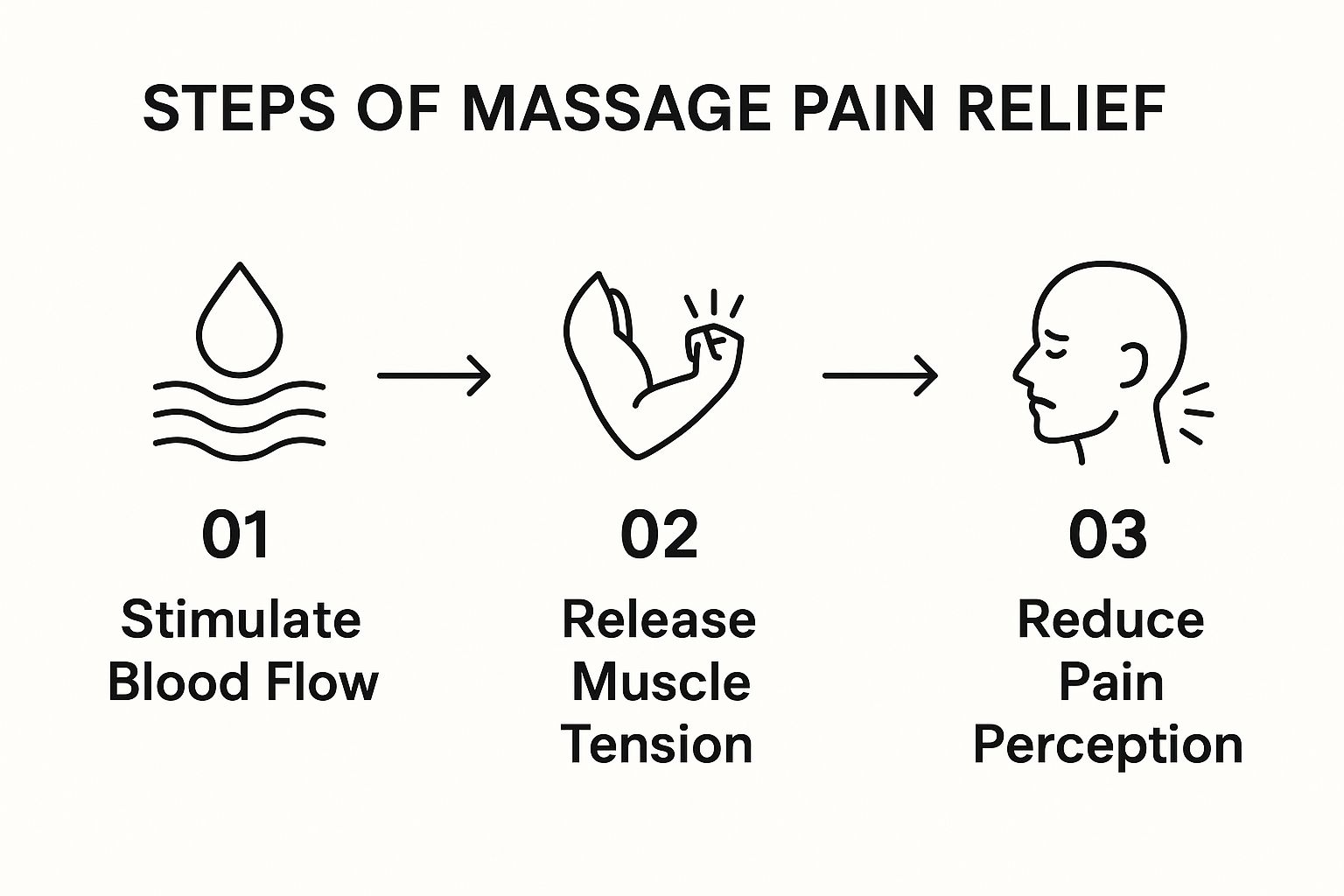
As you can see, pain relief isn't just about someone pressing on a sore spot. It’s a physiological process that kicks off with better blood flow and ends with your brain getting a different signal.
Once you understand these different approaches, you can go beyond just asking for a generic "massage for muscle pain." You can walk in and confidently ask for the specific therapy that targets the root cause of your discomfort. That’s how you get the most effective and lasting relief possible from your session.
How to Prepare for Your Massage Session
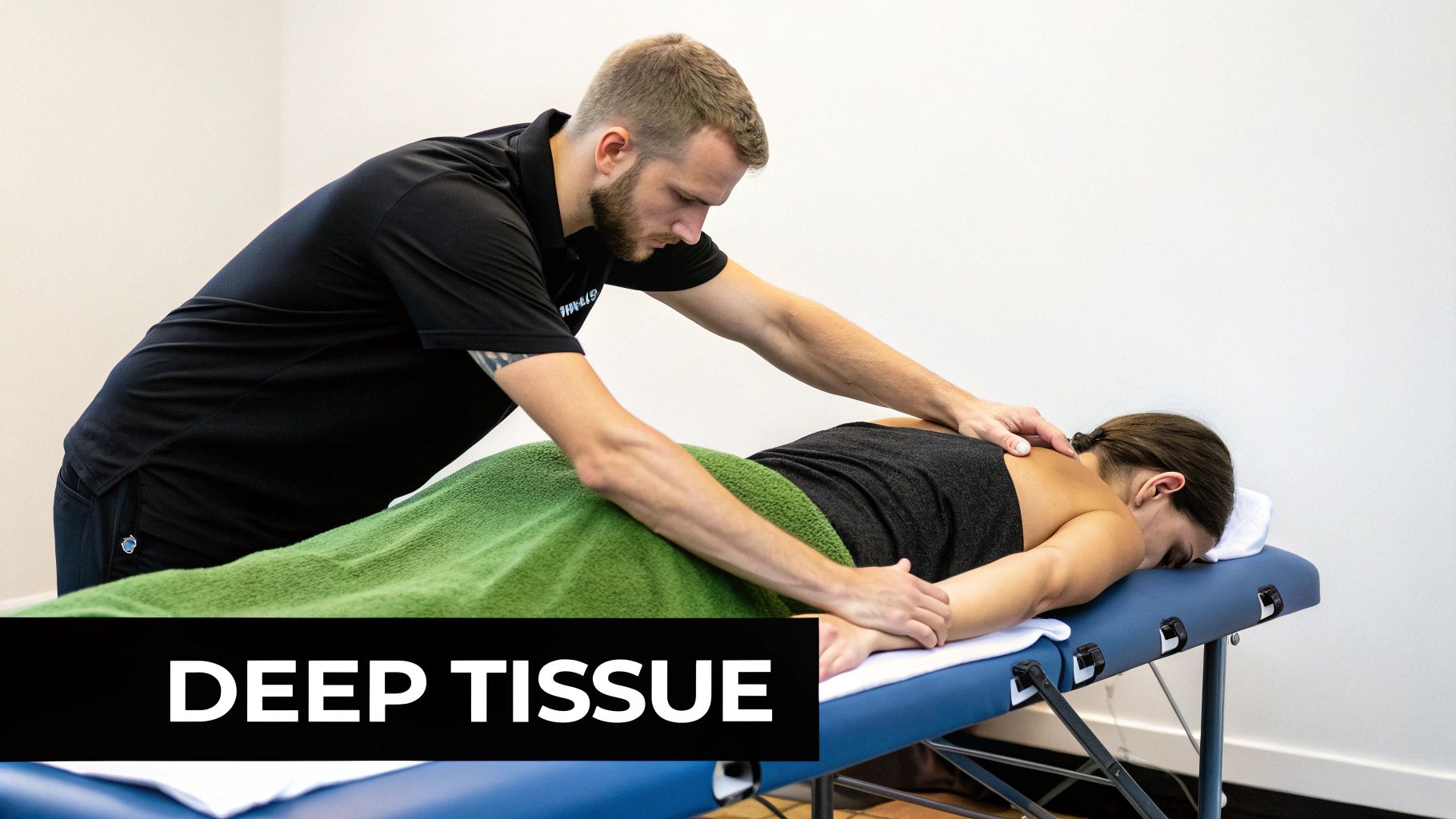
To get the absolute most out of a massage for muscle pain, your work starts well before you’re on the table. A bit of prep work can be the difference between a massage that feels nice and one that truly starts the healing process. When you arrive ready, you empower your therapist to give you their best work.
First things first: hydrate, hydrate, hydrate. Think of it this way—massage is like a deep cleaning for your muscles, releasing all sorts of metabolic gunk that’s been stuck in those tight tissues. Drinking plenty of water the day before and the day of your appointment helps your body efficiently flush all that out. Skip this, and you might feel sore or groggy afterward.
Just as important is open communication. I can't stress this enough. Your therapist wants to help you, but they can't read your mind.
A vague request like "my back hurts" will get you a generic back rub. But telling your therapist "I have a sharp, pinching pain right here, below my left shoulder blade, especially when I turn my head," gives them a treasure map to the source of your problem.
What to Discuss with Your Therapist
Before any hands-on work begins, you need to have a quick but detailed chat. Being ready with the right information makes a world of difference.
Be prepared to pinpoint exactly where you’re feeling pain. Is it a dull ache that radiates down your leg? Is it a sharp, stabbing sensation? The more specific you are, the better they can target the issue. You also need to be clear about your preferred pressure. There’s no shame in saying “a little lighter” or “you can go deeper there.”
Don't forget to mention your health history. It's not just paperwork; it’s crucial for your safety and the effectiveness of the massage. Be sure to cover:
- Any recent injuries or surgeries.
- Chronic conditions like arthritis, sciatica, or fibromyalgia.
- Allergies or skin sensitivities (especially to oils or lotions).
Arriving and Settling In
When it’s time for your appointment, show up in comfortable, loose clothing. It just helps you start the session in a relaxed state of mind from the get-go.
Once you're on the massage table, your only job is to breathe. Focus on taking slow, deep breaths, which signals to your nervous system that it's safe to relax. When your therapist finds a particularly stubborn knot, your instinct might be to tense up against the pressure. Instead, try to breathe into it. You'll be amazed at how this simple shift helps the muscle release.
To keep that post-massage bliss going, you can create a similar tranquil vibe at home. Using things like aromatherapy candles for relaxation can help extend the calming benefits long after you've left the clinic. These small steps ensure you feel genuinely rejuvenated, not just temporarily better.
Effective Self-Massage Techniques You Can Use Today

While nothing quite replaces a professional massage, you don't have to wait for your next appointment to find relief. Learning a few simple self-massage techniques is an incredibly powerful way to manage daily aches and pains as they pop up. And the best part? You can get started right now, often with things you already have around the house.
This isn't just a niche trend; it's a mainstream solution. The reality is that musculoskeletal pain is incredibly common, with some estimates suggesting that two-thirds of adults in developed countries deal with it every year. It’s no wonder that in the United States alone, nearly one in five Americans (19%) got a massage for pain management in the last year.
Targeting Common Trouble Spots
Let's get practical and focus on the areas that give most people grief: the neck and shoulders, the lower back, and the legs. Each area responds best to a slightly different approach.
For Neck and Shoulder Tension
This is the classic "tech neck" or stress-related tightness. Those upper trapezius muscles, which run from your neck out to your shoulders, can get notoriously tight and achy.
- Hands-On Approach: Sit comfortably and reach your right hand over to your left shoulder. Gently squeeze the meaty part of the muscle at the top of your shoulder, holding the pressure for about 10-15 seconds before releasing. Slowly work your way from the base of your neck toward your shoulder joint. Repeat a few times, then switch sides.
- The Wall Method: Grab a tennis or lacrosse ball and place it between your upper back (near the shoulder blade) and a sturdy wall. Lean into the ball and gently move your body up, down, and side-to-side to hunt down those tender spots.
This kind of direct pressure helps break up tight muscle fibers and encourages blood flow, which can bring almost immediate relief.
Using Simple Tools for Deeper Relief
Sometimes, your hands just aren't enough to get the job done, especially for bigger muscles. That's when a few simple tools can become your secret weapons.
A foam roller is a game-changer for large areas like your quads, hamstrings, and calves. To work on your calves, for instance, sit on the floor with your legs straight out. Place the roller under one calf and use your hands to lift your hips off the ground. Slowly roll from just above your ankle toward the back of your knee, pausing on any sore spots you find.
For that one stubborn knot in your back that’s just out of reach, the tennis ball against a wall is perfect. You're in complete control of the pressure by simply leaning in or out. It's a fantastic way to zero in on the trigger points that often cause pain to radiate elsewhere.
Expert Tip: When you find a particularly sore spot, resist the urge to just roll over it quickly. Instead, pause on that spot and hold firm pressure for 20-30 seconds. As you hold it, focus on taking slow, deep breaths. This gives the muscle the time it needs to truly relax and release the tension.
For a deeper dive into this, our guide on how to get rid of muscle knots effectively is a fantastic resource.
Remember, the goal here is to apply firm, consistent pressure without causing sharp pain. Your body is great at giving you feedback, so listen to it. A little discomfort on a knot is totally normal, but if you feel any sharp or shooting pain, that's your cue to ease up. Think of these techniques as your personal first-aid kit for muscle soreness.
When to Get a Massage and When to See a Doctor

A great massage can feel like a miracle worker for aching muscles, but it's not a cure-all. From my experience, one of the most important things to learn is when to book a massage session versus when it's time to call the doctor. Getting this right is crucial for your safety and for getting the results you want.
Think of it this way: your massage therapist is your go-to for muscular issues, but your doctor is the one who needs to diagnose underlying medical conditions.
For example, that classic day-after-the-gym soreness? That's Delayed Onset Muscle Soreness (DOMS), and it's the perfect candidate for massage. A good session can help calm the inflammation and improve blood flow, getting you back on your feet faster. The same goes for that nagging tightness you get from sitting at a desk all day or from general stress—this is exactly what massage is built for.
However, some symptoms are more than just a sore muscle. They're red flags telling you that something more serious might be going on, and a massage could actually make things worse.
The rule of thumb I always share is this: massage is for sore muscles, not for undiagnosed injuries. If you're ever on the fence, check with a doctor first. It’s always the safest bet.
Red Flags That Require a Doctor's Visit
If your muscle pain shows up with any of these other symptoms, it's time to pause the massage plans and see your healthcare provider. These signs can point to an acute injury, a brewing infection, or another condition that needs a proper medical diagnosis.
- Sudden, Sharp, or Intense Pain: This isn't your typical ache. If the pain is stabbing, comes out of nowhere, or is so bad you can barely move, a doctor needs to take a look.
- Pain with Swelling and Redness: When you see significant swelling, or the area feels hot to the touch and looks red, you could be dealing with an acute tear, serious inflammation, or an infection.
- Fever or Chills: Muscle pain accompanied by a fever is a big warning sign. It suggests your body is fighting a systemic infection that requires medical treatment.
- Persistent Numbness or Tingling: That "pins and needles" feeling that just won't quit could be a sign of nerve compression or damage.
- Loss of Function: If you can't put weight on a leg or the pain is so severe it stops you from doing everyday tasks, it's definitely time for a professional medical opinion.
The Growing Accessibility of Safe Massage
Knowing these boundaries helps you make smart decisions about your health. The good news is that getting a safe and professional massage for muscle pain is more straightforward than ever. We're seeing a huge shift in the industry, with everything from easy-to-use booking apps and subscription services to mobile massage therapists who come right to your home.
This trend, pushed forward by a greater focus on wellness worldwide, means finding a qualified therapist in your area is no longer a major hurdle. You can discover more about the growth of massage therapy services and see how the market is evolving to fit our modern lives.
Answering Your Questions About Massage for Pain
https://www.youtube.com/embed/3eC7nB5cxzQ
Deciding to get a massage for muscle pain is a fantastic first step. Still, it's completely normal to have a few questions before you get on the table. Knowing what to expect helps you feel more relaxed and makes sure you get the absolute most out of your time with the therapist.
Let's clear up some of the most common things people wonder about.
How Often Should I Come In?
This is probably the number one question I get, especially from clients dealing with stubborn, long-term issues. For something like chronic back pain, a good rule of thumb is to start with one session per week for the first 4-6 weeks. This consistent schedule gives us a real chance to get ahead of the pain cycle and make lasting progress.
Once we've gotten things under control, you can usually scale back. Many of my clients find that a maintenance massage every 2-4 weeks is the sweet spot for keeping pain from creeping back in.
Is It Supposed to Hurt This Much?
I hear this a lot during deep tissue work. The goal is never to cause pain, but you should expect to feel some productive intensity. It's a fine line, and communication is everything.
There's a world of difference between "good pain" and "bad pain." Good pain is that satisfying, releasing sensation you feel when a therapist finds a deep knot you didn't even know you had. Bad pain is sharp, nervy, or makes you instinctively tense up. If you ever feel that, you need to speak up immediately. A good therapist relies on your feedback to be effective.
What to Do About Soreness the Next Day
Feeling a bit tender the day after a deep massage is incredibly common, so don't be alarmed. Think of it like the soreness you feel after a great workout—your muscles were put through their paces. This feeling, often called post-massage soreness, should fade within 24 to 48 hours.
Here’s what I always tell my clients to do to ease the discomfort:
- Drink lots of water. Hydration is key. It helps your body flush out all the metabolic byproducts released from your tight muscle tissues during the session.
- Take a warm Epsom salt bath. The heat and magnesium are fantastic for soothing worked muscles and reducing any lingering stiffness.
- Move gently. Avoid hitting the gym hard, but some light stretching or a casual walk can do wonders. It keeps the blood flowing and prevents your muscles from tightening right back up.
This kind of soreness is a normal sign that the massage successfully targeted deep-seated tension.
Can Massage Help Nerve Pain Like Sciatica?
This is a great question with a nuanced answer. While massage can't fix the root cause of true sciatica—like a herniated disc compressing the sciatic nerve—it can be incredibly effective for what's often mistaken for it.
Many people suffer from "sciatic-like" pain that's actually caused by a tight piriformis muscle, a small muscle located deep in the buttocks. When it gets too tight, it can press directly on the sciatic nerve, causing pain to shoot down the leg. This condition, known as piriformis syndrome, responds beautifully to massage. A skilled therapist can carefully work to release the tension in the piriformis, taking pressure off the nerve and often eliminating the pain completely.
At La Moon Massage and Facial, our experienced therapists in Houston, Texas, are experts at getting to the source of your pain. We build customized massage sessions to help you recover and feel your best. Book your appointment today and start your journey to a pain-free life.
Sports Massage Recovery: Speed Up Healing & Prevent Injuries

If you've ever been amazed at how quickly professional athletes recover from punishing workouts, you might think it's all about rest. But here's the secret: it’s really about active recovery. Sports massage recovery isn't just a random rubdown; it's a methodical way of healing that uses specific techniques to slash muscle soreness, boost flexibility, and kickstart your body's own repair crew.
Why Sports Massage Is Your Recovery Secret Weapon

Too many athletes, from weekend joggers to seasoned pros, mistakenly file sports massage under "luxury" or "injury treatment only." This view completely misses its most powerful role: proactive recovery and preventing injuries before they happen. It’s time to stop thinking of it as a treat and start seeing it as essential training gear.
This isn't your average spa massage. It’s a highly focused therapy designed to work on the exact muscle groups you tax during your sport. A runner’s massage will look very different from a swimmer’s, zeroing in on the specific areas that take the biggest hit. The whole point is to manipulate soft tissues to get them back to fighting shape.
The Science Behind Faster Healing
So what’s actually happening on the table? A great sports massage gets your blood flowing, big time. This surge of circulation brings a fresh supply of oxygen and nutrients your muscles are screaming for, while also flushing out the junk left behind from a tough workout, like lactic acid. That’s the stuff that makes you feel sore and stiff.
This process delivers some pretty immediate and tangible results for any athlete:
- Less Muscle Soreness: It directly tackles that dreaded delayed onset muscle soreness (DOMS) by calming muscle tension and inflammation.
- Better Flexibility: The techniques help stretch and release tight, knotted-up muscle fibers, which dramatically improves your range of motion and makes you more efficient.
- Smarter Injury Prevention: By finding and fixing muscular imbalances and trigger points before they turn into real problems, you build resilience against common strains and sprains.
The true magic of a regular sports massage plan is finding those tiny issues before they have a chance to grow into major injuries that take you out of the game. Think of it as an investment in your athletic future.
To give you a clearer picture, here’s a quick breakdown of how these massages translate into real-world results.
Core Benefits of Integrating Sports Massage into Your Recovery
This table summarizes the key advantages, connecting each benefit to a specific outcome for you as an athlete.
| Benefit | Physiological Impact | Athlete Takeaway |
|---|---|---|
| Reduced Soreness (DOMS) | Flushes metabolic byproducts like lactic acid and reduces micro-inflammation in muscle fibers. | You'll feel less stiff and sore, allowing you to get back to quality training sooner. |
| Improved Flexibility | Lengthens tight muscle fibers and breaks down small adhesions (knots) between tissues. | Your movements become more fluid and efficient, reducing the risk of muscle tears. |
| Enhanced Circulation | Increases blood flow, delivering more oxygen and nutrients to tired muscles. | Your muscles repair themselves faster, leading to quicker recovery between sessions. |
| Injury Prevention | Identifies and corrects muscular imbalances and trigger points before they become chronic problems. | You're less likely to suffer from overuse injuries like shin splints or rotator cuff issues. |
Ultimately, integrating sports massage means you're not just recovering; you're actively preparing your body for the next challenge with more strength and resilience.
More Than Just a Passing Fad
The buzz around sports massage isn't just talk. The global massage therapy market hit a value of USD 18.25 billion in 2023, and the sports massage segment is expected to grow at the fastest clip—9.4% through 2030. What's driving this? In part, it's a documented increase in sports-related injuries since 2021, according to market analysis from Grand View Research.
This isn't a practice just for the pros anymore. When you add sports massage to your routine, you’re making a smart, deliberate choice to support your body's long-term performance and health. To dig deeper into how this can become your personal game-changer, check out our guide on sports massage therapy and its benefits. For anyone serious about their fitness, it's a strategy that pays dividends.
How to Prepare for Your Massage Session
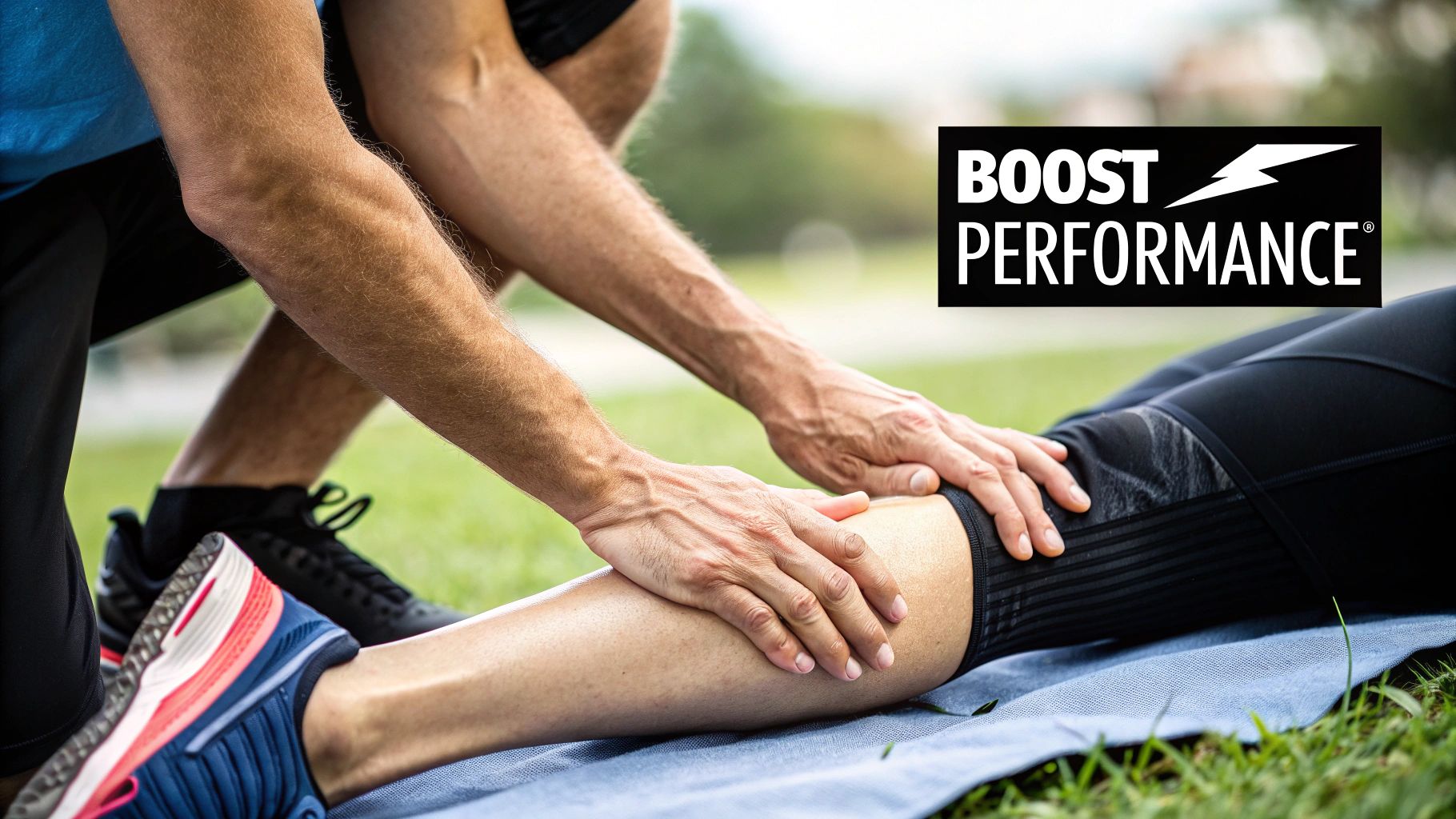
Getting the most out of a sports massage starts well before you ever lie down on the table. What you do in the 24 hours leading up to your appointment can seriously impact your sports massage recovery, turning a decent session into a game-changing one.
Think of it like prepping your body for a tune-up. You're not just showing up; you're creating the right conditions for your muscles to actually release and respond to the treatment. The small things you do beforehand really do prime your body for repair.
Your 24-Hour Preparation Checklist
A bit of simple planning makes all the difference. To get the most out of your time, focus on what you drink, what you eat, and how you communicate.
-
Hydrate Smarter, Not Harder: When you're well-hydrated, your muscle tissue is much more pliable, making it far easier for your therapist to work effectively. Try to sip water consistently throughout the day before your appointment. Chugging a huge bottle right before you walk in won't cut it—think of it like marinating a tough piece of meat. It needs time.
-
Time Your Meals Correctly: Try not to eat a big, heavy meal within 90 minutes of your massage. If you do, your body will be focused on digestion, pulling blood flow away from the very muscles you want to treat. A light snack, like a banana or a small handful of almonds an hour or two before, is a much better idea.
-
Avoid Intense Workouts: It’s a good rule of thumb to skip any heavy lifting or intense cardio on the day of your massage. Showing up with freshly exhausted or inflamed muscles can make the session unnecessarily painful and much less productive. A light walk or some gentle stretching is fine, but save that high-intensity workout for another day.
A sports massage is basically a workout for your muscles. You wouldn't run a 10k right before a heavy leg day at the gym, would you? The same logic applies here. You want your body ready to receive the work, not fight against it.
Communicating with Your Therapist
Once you're in the treatment room, open communication is your best friend. This is absolutely not the time to be quiet or tough it out. Your therapist is your partner in recovery, but they aren't a mind reader.
Come prepared to talk about what you've been doing. For instance, saying, “I ran a half-marathon three days ago, and my right hamstring feels way tighter than my left,” gives them a roadmap. It’s so much more helpful than a generic, “my legs are sore.” Pinpoint where it hurts, mention any aches that flare up with certain movements, and be clear about what you hope to get out of the session.
This back-and-forth is what turns a standard massage into a targeted sports massage recovery session built just for you. The more info you give, the better your therapist can tailor their techniques to get to the root of the problem, making sure you walk out feeling lasting relief.
What Really Happens During a Sports Massage
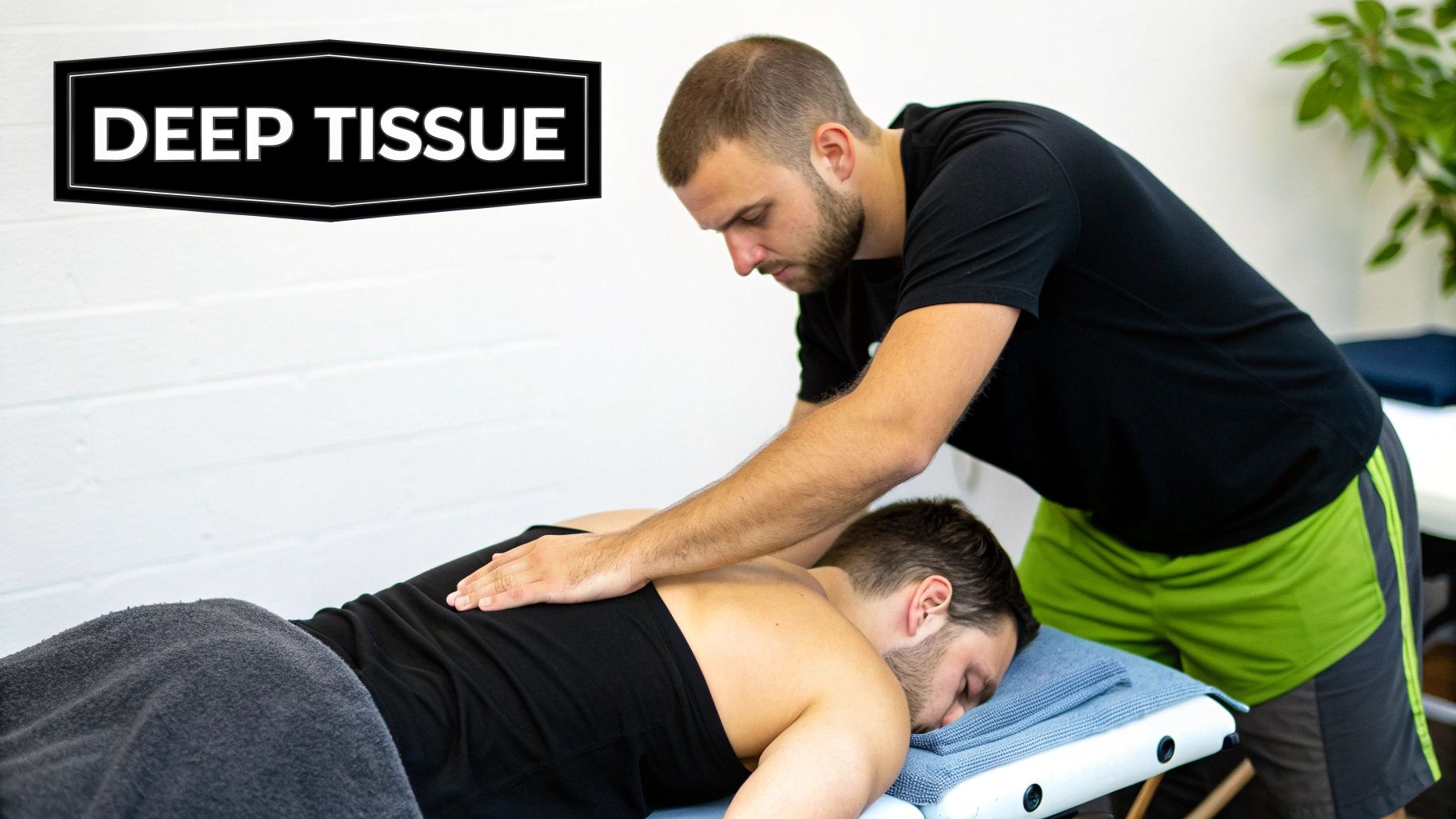
If you're expecting a quiet, dimly lit spa experience, a sports massage might surprise you. This isn't about gentle relaxation; it's a targeted, functional treatment designed to support your athletic endeavors and accelerate your sports massage recovery. Think of it less as a pampering session and more as a dynamic collaboration between you and your therapist.
There's no one-size-fits-all routine here. A good therapist tailors every session to your specific sport, training load, and individual needs. A swimmer, for instance, might need intensive work on their lats and shoulders to improve their reach and power in the water. For a cyclist, the focus will almost certainly be on the quads, hamstrings, and glutes to release tightness from hours spent hunched over the handlebars.
The Core Techniques in Action
During your massage, the therapist will draw from a toolkit of specialized techniques, each serving a distinct purpose. They aren't just rubbing your muscles; they are systematically working through layers of tissue to restore mobility and function.
You'll likely feel a combination of these classic methods:
- Effleurage: These are the long, sweeping strokes that usually start and end a session. They warm up the muscle tissue, get the blood flowing, and allow the therapist to feel for any obvious knots or tight spots.
- Petrissage: This is the deeper work—the kneading, squeezing, and rolling motions. The goal here is to lift the muscle away from the bone, which helps release stubborn, deep-seated tension and flush out metabolic waste.
- Friction: When the therapist finds a specific adhesion or patch of scar tissue, they'll use this technique. It involves deep, concentrated pressure applied in circular or cross-fibre movements to break down the "stuck" tissue that's restricting your movement.
These techniques are rarely used in isolation. A session might begin with broad effleurage strokes on your legs, progress to petrissage on a tight calf, and then finish with targeted friction work on a particularly nasty knot in your hamstring.
"Good Pain" and Why Your Feedback Matters
One of the biggest keys to a successful sports massage is communication. There's a world of difference between productive discomfort and harmful pain, and you need to know which is which. You'll probably feel a deep, sometimes intense sensation when your therapist hits a trigger point—that's what many of us call "good pain." It’s that satisfying feeling of a tight knot finally letting go.
However, sharp, shooting, or unbearable pain is a red flag. That's your body telling you the pressure is too intense or the technique isn't suitable for that specific area.
A great therapist is constantly looking for your feedback. Don't be shy. Saying, "a little less pressure there" or "that spot on the right feels much tighter" provides them with the real-time information they need to adjust the treatment for maximum effect. Your input makes it a true partnership.
This focused approach is precisely why sports massage has become a non-negotiable part of athletic maintenance. It's a growing field, with the market for sports rehabilitation services valued at roughly USD 12.3 billion in 2024 and projected to climb to USD 24.1 billion by 2033. This isn't just a trend; it's a clear indicator of how seriously athletes and active individuals are taking proactive recovery. You can dig into more of the data in reports from Verified Market Reports. Knowing what's happening on the table helps you get the most out of every session, leading to faster recovery and smarter training.
Your Post-Massage Action Plan for Peak Recovery
The real work of recovery often begins after you get off the massage table. What you do in the next 24 to 48 hours is the difference between maximizing the benefits of your session and letting them fade away. Think of this as your game plan for locking in every bit of that therapeutic work.
Your muscles have just been put through a passive, but intense, workout. They're more pliable and open now, but they're also a bit vulnerable. The goal is to help them rehydrate, flush out the metabolic junk that was just released, and gently adapt to their new, less-restricted state.
Rehydrate the Right Way
Everyone tells you to drink water after a massage, but there’s a good reason for it. Your therapist just broke up adhesions and knots, which frees up metabolic waste that was stuck in those tight tissues. Your job now is to help your body's natural filtration systems—your lymphatic system and kidneys—get rid of it all.
Make it a point to drink at least two to three extra glasses of water in the hours immediately following your appointment. If the massage was particularly deep or you were a bit dehydrated beforehand, consider adding an electrolyte powder to one of those glasses. It helps your muscle cells actually pull that water in and rehydrate more efficiently.
A fantastic move for later that evening is an Epsom salt bath. A 20-minute soak can work wonders. The magnesium helps soothe any lingering tenderness and encourages your muscles to relax even further.
Smart Movement and Nutrition
Your body needs a moment to integrate the changes from the massage. The absolute worst thing you can do is jump right back into a grueling workout. That's a recipe for injury.
- Gentle Movement Only: For the next 24 hours, keep it light. Think slow walks or some gentle, dynamic stretching. This keeps the blood flowing without putting any real strain on the muscles that were just worked so deeply.
- Refuel with Protein: Your muscles have officially entered repair mode. Give them the building blocks they need by having a protein-rich meal within a few hours of your session. Amino acids are essential for repairing muscle tissue.
To really get the most out of your healing, you need to support it with the right fuel. You can learn more about how to optimize your muscle recovery through smart nutritional choices, which is a key piece of the puzzle.
Listen to Your Body and Plan Ahead
Pay close attention to how you feel the next day. This is valuable intel. Feeling a bit tender in the spots that got the most work is completely normal—it’s a sign that real change happened. Sharp pain, however, is not. Make a mental note of how your body is responding. Which areas feel amazingly loose? Which ones might still need a little more attention next time?
Bring this feedback to your therapist at your next session. This creates a collaborative process where each massage builds effectively on the last. For a deeper dive into how this all comes together, our guide on massage for muscle recovery is a great resource. Following these simple steps ensures that every single massage gives you the best possible results.
5. Supercharge Your Recovery with At-Home Tools
While a professional sports massage is a fantastic tool for recovery, what you do between those sessions is what truly makes the difference. Think of your home as your personal recovery sanctuary, filled with tools that extend the benefits of your therapist's work and keep your muscles ready for action.
This isn't about cluttering your space with every new gadget that hits the market. It’s about being strategic. Let's say your therapist mentioned some stubborn tightness in your IT band during your last session. Using a foam roller on that specific area for just a few minutes each day can make a world of difference, preventing it from seizing up before your next appointment.
The sports recovery market is booming for a reason—these tools work. Valued at USD 1.32 billion in 2024, the demand for devices like massage guns, foam rollers, and compression systems is driven by athletes who want to reduce soreness and heal faster.
The Right Tool For The Job
Your at-home recovery toolkit should be built around your body and your training. Here's how to think about some of the most popular options:
- Foam Rollers: These are your go-to for broad, general pressure. They work wonders on large muscle groups like your quads, hamstrings, and lats. A few slow, deliberate rolls can help release general tightness after a long run or heavy lifting session.
- Massage Guns: For those deep, specific knots—like the ones in your traps or glutes your therapist pointed out—a massage gun is perfect. Its percussive action provides targeted relief that's hard to achieve on your own.
- Compression Systems: Think of these (like Normatec boots) as a high-tech flush for your limbs. The pneumatic pressure helps move metabolic waste out and reduces swelling, making them an incredible asset after a tough leg day or a long bike ride.
It's crucial to see these tools as complementary maintenance, not replacements for professional bodywork. In my experience, athletes who use these tools consistently actually get more out of their professional massages because their muscles are in better condition to begin with. You can explore the full range of benefits of sports massage in our detailed guide.
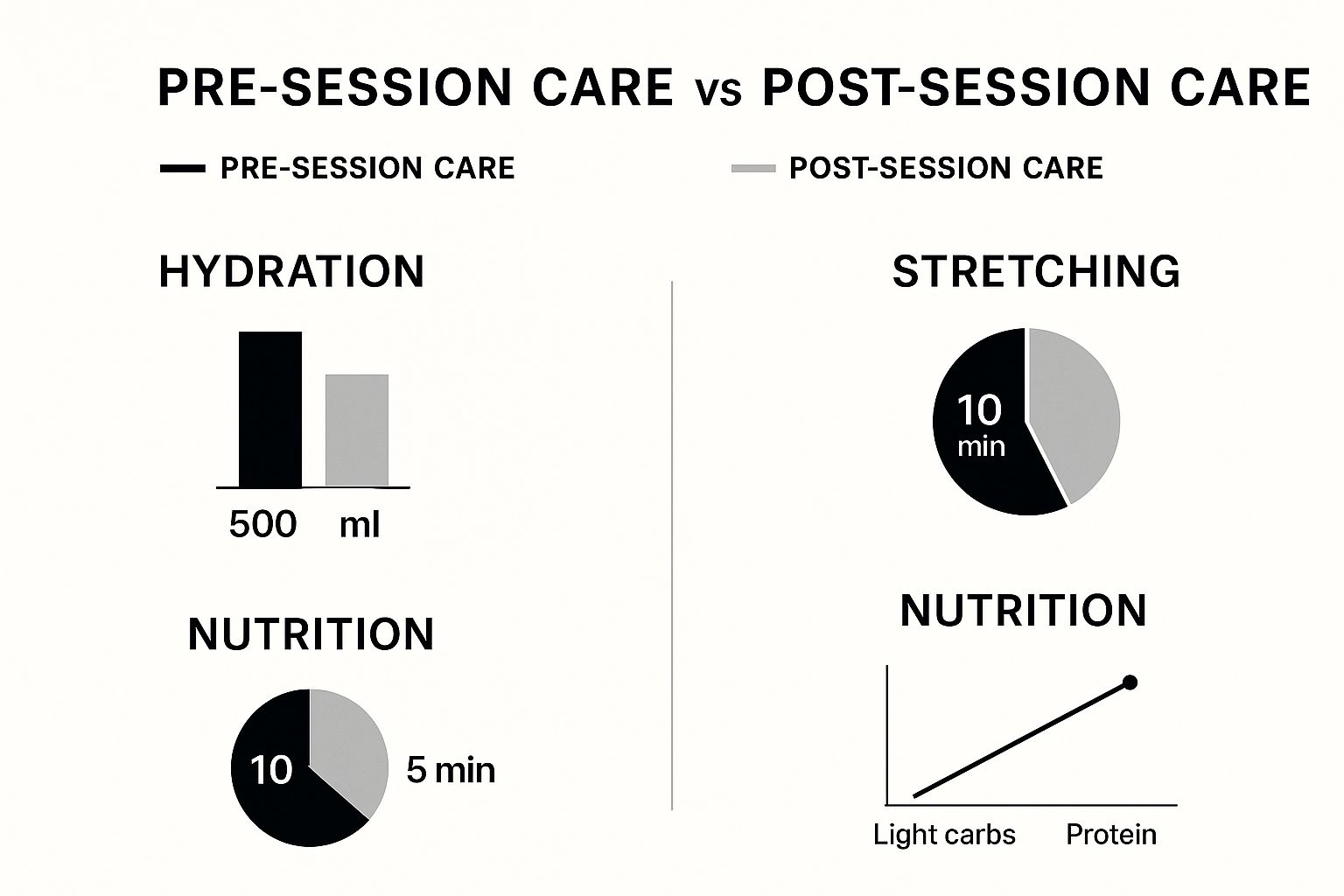
As you can see, the focus shifts dramatically from pre-session prep (hydration, light carbs) to post-session care, where protein for muscle repair and a more gentle approach to stretching take priority.
To help you decide which tools might be right for you, here’s a quick comparison of some popular options and how they fit into a comprehensive recovery plan.
At-Home Recovery Tool Comparison
| Recovery Tool | Primary Function | Best Used For | How It Complements Massage |
|---|---|---|---|
| Foam Roller | Myofascial Release | General tightness in large muscles (quads, hamstrings, back) | Maintains muscle pliability between sessions, addressing broad tension. |
| Massage Gun | Percussive Therapy | Targeting deep, specific knots (traps, glutes, calves) | Breaks up stubborn adhesions your therapist identified, preventing them from returning. |
| Compression Boots | Lymphatic Drainage | Reducing post-workout swelling and flushing metabolic waste | Speeds up recovery from intense workouts, meaning muscles are less inflamed for your next massage. |
| Lacrosse Ball | Trigger Point Release | Pinpointing small, hard-to-reach areas (feet, pecs, shoulders) | Provides focused pressure on small trigger points, extending the detailed work of a therapist. |
Each tool serves a unique purpose, and the best recovery routines often incorporate a mix. By using them to address day-to-day soreness, you allow your therapist to focus on deeper, more complex issues during your professional sessions.
When To Use Heat Versus Cold
This is a classic question, and getting it right is a game-changer for at-home care. Heat and cold have opposite physiological effects, so using them correctly is key.
Heat therapy is your best friend for chronic, nagging tightness or for warming up before activity. Applying a heating pad increases blood flow, which helps make stiff, sore muscles more pliable. Think of it as preparing the tissue for movement or easing general aches that aren't tied to a specific, new injury.
Cold therapy, on the other hand, is for acute inflammation. Use an ice pack immediately after a tough workout or if you've tweaked something and notice swelling. The cold constricts blood vessels, which helps numb sharp pain and, most importantly, reduces that inflammatory response.
Here's the simplest way to remember it: Heat for stiffness, cold for swelling. Never, ever apply heat to a fresh injury—it will just increase inflammation and make things worse.
Beyond these tools, don't forget the fundamentals. Simple practices can have a huge impact. For instance, many people find that incorporating a cold shower into your routine can improve sleep quality, which is when the vast majority of your muscle repair happens. By combining smart at-home care with professional therapy, you create a powerful, continuous cycle of recovery.
Answering Your Top Sports Massage Recovery Questions
Even when you've got a plan, it's natural to have questions pop up as you start weaving sports massage into your training schedule. Getting clear on the little details helps you make smarter choices and ensures every session truly moves the needle for your sports massage recovery. Let's tackle some of the most common things athletes wonder about.
Think of this as a quick chat to clear up any confusion. From timing your sessions to what you should feel on the table, these answers will give you the confidence to use this powerful recovery tool effectively.
How Often Should I Get a Sports Massage?
This is probably the most common question I hear, and the honest answer is: it depends entirely on your training load and what you're trying to achieve. There's no one-size-fits-all number. It’s all about listening to your body and matching the therapy to your physical output.
- Competitive Athletes: If you're deep in a training cycle or gearing up for a race, once a week can be a total game-changer. It helps you stay on top of the cumulative stress from hard workouts and keeps you from digging yourself into a recovery hole.
- General Fitness: For those who hit the gym or run consistently to stay in shape, a session every 2-4 weeks is a fantastic maintenance rhythm. This is frequent enough to break up any knots or tightness before they escalate into nagging, chronic problems.
- Post-Event Recovery: After a huge effort like a marathon, triathlon, or big game, getting on the table 48-72 hours later is the sweet spot. It's the perfect time to flush out inflammation and jump-start the healing process.
Is a Sports Massage Supposed to Hurt?
A sports massage should feel productive, but it shouldn't be agonizing. You'll likely experience some real discomfort—what many people call a "good hurt"—especially when your therapist is working on stubborn muscle knots or trigger points. That sensation is a sign that tight tissue is finally starting to release.
However, any sharp, stabbing, or shooting pain is a big red flag. That's your body's way of screaming that the pressure is too intense or is hitting a nerve.
Don't be a hero on the table. Your therapist is relying on your feedback to find the right pressure. The goal is therapeutic release, not an endurance test. Open communication is what makes a session both safe and effective.
What Makes It Different from a Deep Tissue Massage?
This is a great question, as they can feel similar. While both sports massage and deep tissue massage get into the deeper layers of muscle, their goals are quite different. Deep tissue massage typically focuses on relieving chronic tension patterns throughout the body, often related to things like posture or old injuries.
A sports massage, on the other hand, is laser-focused and functional. The entire session is tailored to the specific muscles and movements you rely on for your sport. For example, your therapist might incorporate active release or assisted stretching to improve your range of motion in a way that directly helps your golf swing or running stride. The whole point is to boost athletic function and prevent sport-specific injuries.
Can I Train After a Sports Massage Session?
I strongly advise against it. Your best bet is to give yourself at least 24 hours before jumping back into any intense training. Your muscles have just been through a serious therapeutic workout and they need time to settle down, recover, and adapt.
A light activity like a gentle walk or some easy dynamic stretching later in the day is totally fine—it can even help by promoting blood flow and preventing stiffness. But hitting the weight room or going for a hard run too soon can just make you more sore and completely cancel out the benefits you just paid for. Let your body rest and absorb the work.
Ready to make sports massage a core part of your recovery routine? The expert therapists at La Moon Massage and Facial specialize in targeted treatments to help Houston athletes and fitness enthusiasts feel and perform their best. Book your session today and experience the difference.
6 Key Benefits of Massage for Athletes in 2025
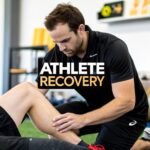
In the competitive world of athletics, every advantage counts. While rigorous training and precise nutrition are cornerstones of success, a crucial, often overlooked element in an athlete's toolkit is professional massage therapy. Far more than a simple luxury, targeted massage is a scientific approach to accelerating recovery, preventing injuries, and unlocking new levels of performance. It directly addresses the unique physical and mental toll that intense athletic activity places on the body, from aching muscles to the stress of competition.
This guide moves beyond generic advice to provide a strategic breakdown of the essential benefits of massage for athletes. We will explore six core advantages, offering actionable insights for integrating this powerful modality into any training regimen. Whether you are a weekend warrior or a professional competitor, you will learn precisely how massage can be leveraged to achieve specific outcomes. From reducing the debilitating effects of muscle soreness to sharpening your mental focus, you'll discover why athletes at every level are making massage an indispensable part of their journey to peak physical condition and competitive success. This is your blueprint for using therapeutic massage to gain a definitive edge.
1. Enhanced Muscle Recovery and Reduced Soreness
One of the most significant benefits of massage for athletes is its profound impact on muscle recovery and the reduction of soreness. After intense physical exertion, muscles experience micro-tears and an accumulation of metabolic byproducts, such as lactic acid and creatine kinase. This process leads to inflammation and the dreaded delayed onset muscle soreness (DOMS), which can hinder training schedules and performance.
Massage therapy directly addresses this by stimulating blood flow and lymphatic drainage. Increased circulation delivers vital oxygen and nutrients to damaged muscle tissues, accelerating the repair process. Simultaneously, improved lymphatic circulation helps flush out the metabolic waste that contributes to pain and stiffness, allowing athletes to feel better, faster.
How Top Athletes Leverage Recovery Massage
This isn't just a luxury; it's a strategic tool. Professional sports organizations integrate massage as a non-negotiable part of their recovery protocols.
- NFL Teams: Use massage therapy as a standard post-game and mid-week recovery method to manage the physical toll of a demanding season.
- Olympic Swimmers: Often receive daily massages during intense training camps to maintain peak physical condition and prevent overtraining injuries.
- Professional Cyclists: Employ dedicated massage therapists during grueling multi-stage races like the Tour de France to combat muscle fatigue and prepare their bodies for the next day's stage.
The following infographic highlights key data points related to massage for muscle recovery, showing both the effectiveness and the optimal timing.
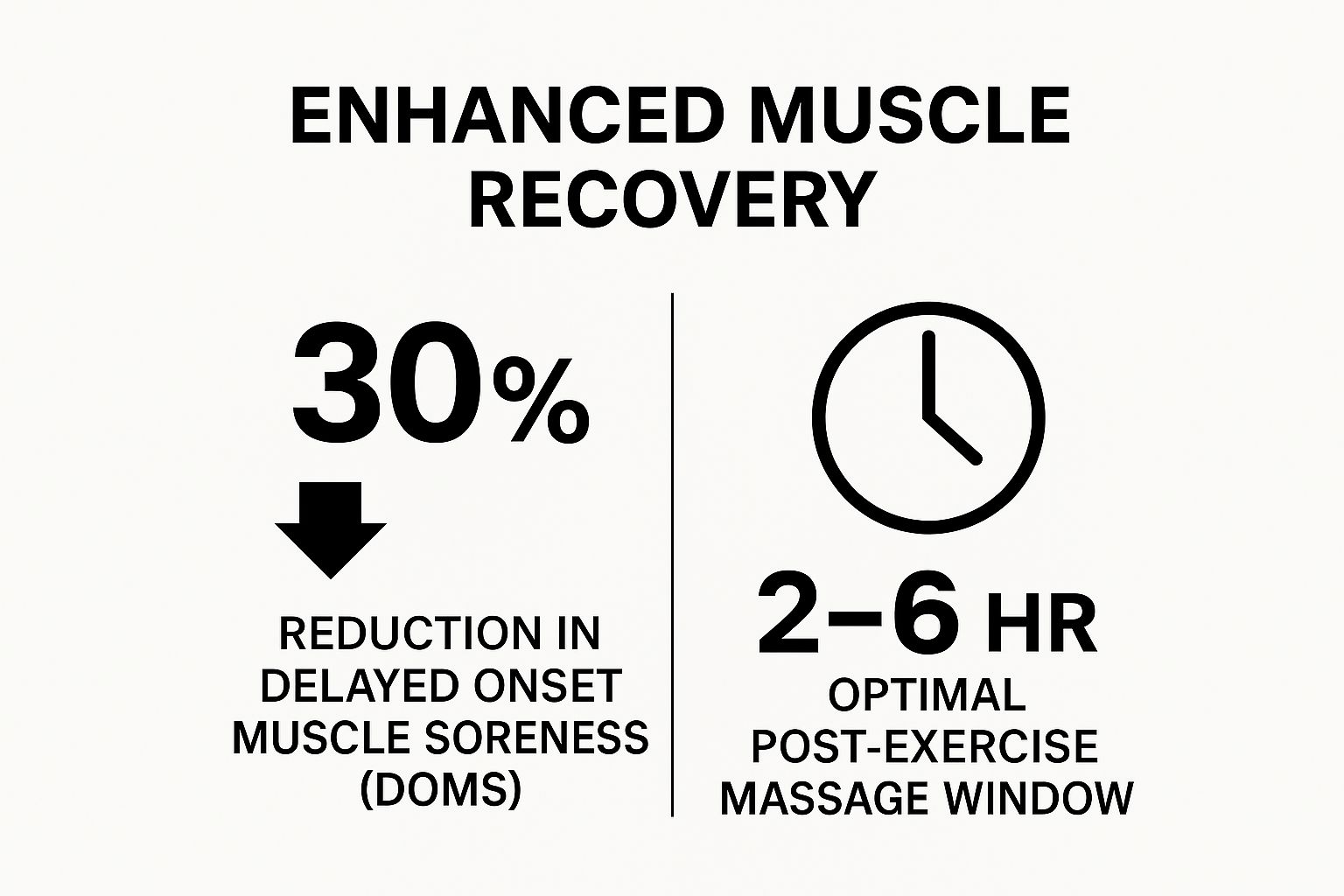
These statistics underscore a crucial point: a well-timed massage can significantly cut down recovery time and reduce the discomfort associated with intense training.
Practical Tips for Implementation
To maximize these benefits, timing and technique are essential.
Key Insight: Schedule your post-activity massage within a 2 to 6-hour window. This timeframe capitalizes on the body's natural recovery state, making the massage more effective at flushing out waste products before they fully settle in.
For post-exercise recovery, request lighter pressure (like a Swedish massage) rather than a deep tissue massage, which is better suited for addressing chronic issues between training sessions. Focus the massage on the primary muscle groups you just worked. A runner, for example, would prioritize glutes, hamstrings, quads, and calves. Combining this with proper hydration and nutrition creates a powerful synergy for recovery.
While massage is a cornerstone of physical recovery, a holistic approach often yields the best results. Beyond massage, exploring various strategies can further optimize an athlete's recovery process. For more comprehensive approaches, consider these 7 Genetics-Informed Muscle Recovery Tips. To discover more about the science behind massage and its role in recuperation, you can learn more about its direct impact on muscle recovery.
2. Improved Flexibility and Range of Motion
A crucial benefit of massage for athletes is its ability to significantly improve flexibility and range of motion. Athletic performance hinges on fluid, efficient movement, which is often restricted by tight muscles, fascial adhesions, and stiff joints. Over time, intense training can lead to the buildup of scar tissue and knots within the muscle fibers, limiting their ability to lengthen and contract fully.
Massage therapy directly targets these restrictions. Techniques like myofascial release, trigger point therapy, and active release work to break down adhesions in the soft tissues. This process helps to restore muscle elasticity and reduce overall tension, allowing joints to move more freely through their full, intended range. For an athlete, this means deeper squats, a longer stride, or a more powerful throwing motion.
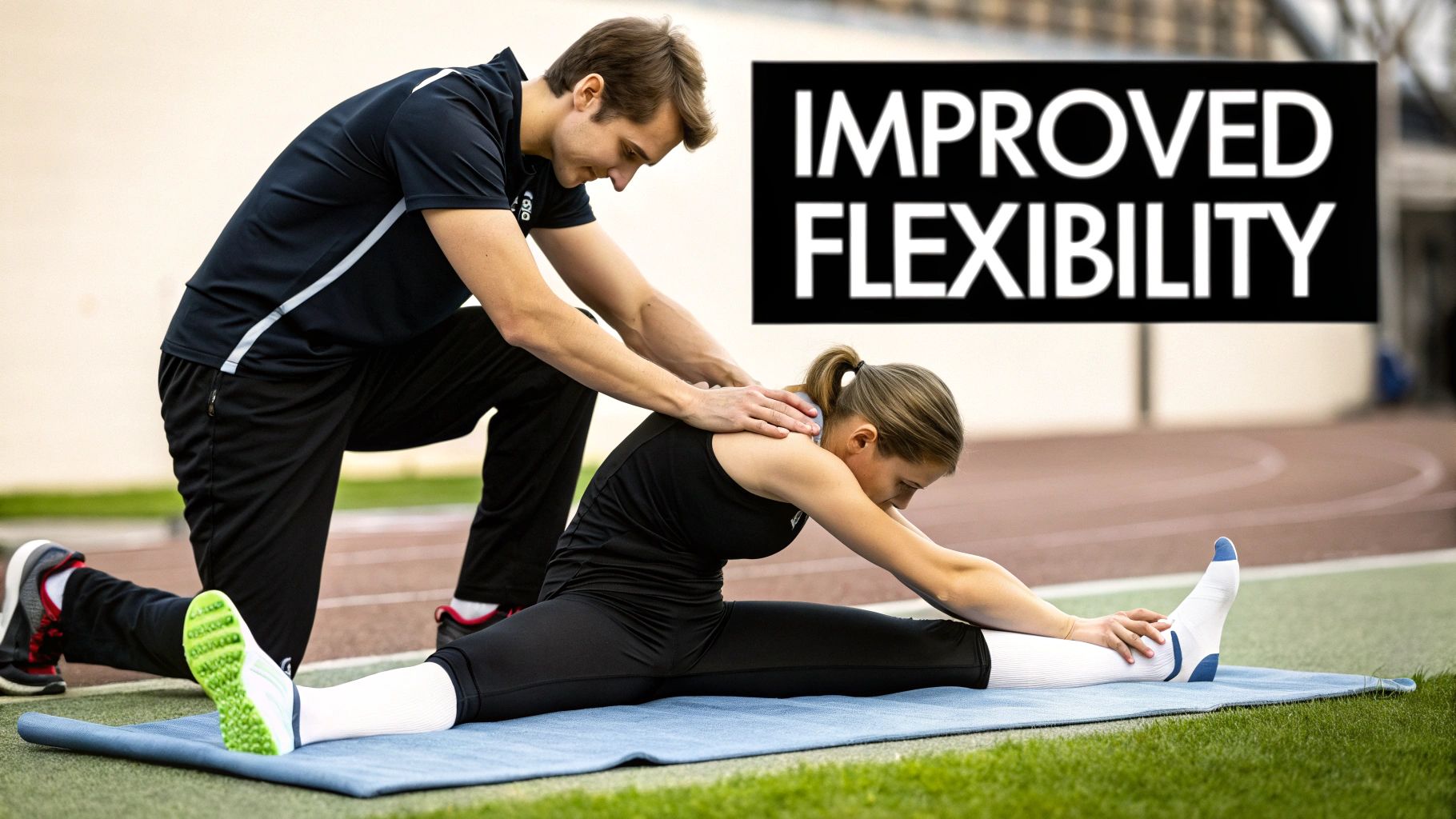
How Top Athletes Leverage Flexibility Massage
Maintaining optimal mobility is a non-negotiable for elite performers, and massage is a key component of their strategy. This practice was popularized by movement specialists like Vladimir Janda and is a staple for functional movement experts.
- Gymnasts: Rely on regular massage to maintain the extreme levels of flexibility required for complex routines on the floor, bars, and beam.
- Baseball Pitchers: Frequently receive targeted massage on their shoulders, rotator cuffs, and arms to preserve a full and fluid throwing motion, which is essential for both velocity and injury prevention.
- Professional Dancers: Incorporate massage into their daily training regimens to combat the muscular tension that builds from hours of precise, repetitive movements, ensuring they can achieve maximum extension and grace.
The video below demonstrates several massage techniques specifically designed to enhance flexibility and mobility in key athletic muscle groups.
Practical Tips for Implementation
To effectively use massage for flexibility, it's about more than just lying on the table; it requires a strategic, integrated approach.
Key Insight: The greatest gains in flexibility are achieved when massage is combined with active movement. Immediately following a massage session, perform sport-specific dynamic stretches to "teach" your muscles how to use their newfound range of motion.
Focus on sport-specific movement patterns during your massage session. For instance, a golfer might have their therapist work on the hips and thoracic spine to improve rotational mobility. For maintenance between professional sessions, use tools like foam rollers or massage balls on key areas to prevent adhesions from reforming. This proactive approach ensures that flexibility gains are not temporary but are integrated into your athletic performance.
3. Enhanced Athletic Performance
While recovery is a critical component, one of the most direct benefits of massage for athletes is its ability to enhance performance during competition and training. By optimizing muscle function and improving movement efficiency, massage helps athletes produce more power and sustain effort for longer periods. This isn't about post-event repair; it's about pre-event preparation and peak execution.
Massage therapy achieves this by increasing tissue pliability, warming up muscles, and stimulating the nervous system. This preparation allows muscle fibers to contract more efficiently and powerfully, reducing the energy wasted on internal friction or restricted movement. The result is a more explosive, coordinated, and resilient athlete ready to perform at their highest level.
How Top Athletes Leverage Performance Massage
Elite competitors see pre-event massage not as a relaxation tool, but as a performance-enhancing ritual. This practice was pioneered by Soviet sports scientists in the mid-20th century and has since been adopted by top-tier athletic programs globally.
- Sprinters: Often use a brisk, stimulating pre-competition massage to "wake up" the nervous system and prime fast-twitch muscle fibers in the glutes and hamstrings for explosive starts.
- Weightlifters: Incorporate massage between heavy training sessions to restore muscle pliability, ensuring they can achieve optimal form and power output in subsequent lifts without being hindered by tightness.
- Tennis Players: Receive targeted massages on their arms, shoulders, and legs during short tournament breaks to maintain muscle responsiveness and prevent cramping during long, grueling matches.
Practical Tips for Implementation
To harness massage for performance, the approach must be strategic and timed correctly. The goal is stimulation, not deep relaxation.
Key Insight: A pre-event massage should be light, brisk, and stimulating, not deep and invasive. The ideal window is 30 to 60 minutes before competition to elevate muscle readiness without causing fatigue or soreness.
Focus this type of massage on the primary muscle groups essential to your sport. For instance, a swimmer would benefit from work on the lats, shoulders, and chest, while a soccer player would prioritize quads, hamstrings, and calves. Consistency is key; integrating this into your pre-competition routine helps your body adapt and respond predictably on game day. Avoid any deep tissue work, as it can create micro-trauma and leave muscles feeling tender or weak just when you need them most.
4. Stress Reduction and Mental Well-being
Beyond the physical benefits, one of the most crucial advantages of massage for athletes lies in its powerful impact on mental well-being. The immense pressure of competition, rigorous training schedules, and performance expectations can lead to significant psychological stress. This mental strain can elevate cortisol levels, the body's primary stress hormone, which negatively impacts sleep, recovery, and focus.
Massage therapy directly counteracts this by promoting a deep state of relaxation. The therapeutic touch helps lower cortisol while stimulating the release of mood-regulating neurotransmitters like serotonin and dopamine, as well as endorphins, the body's natural pain and stress fighters. Embracing a holistic approach to an athlete's health, massage therapy also contributes significantly to mental well-being, aligning with the timeless principle of 'Mens Sana In Corpore Sano' (a sound mind in a sound body).
How Top Athletes Leverage Mental Well-being Massage
Mental fortitude is as important as physical strength, a fact that top athletes and their support teams, including sports psychologists like Dr. Jim Loehr, understand well.
- Olympic Athletes: Often use pre-competition massage not just for muscle activation but to calm nerves, center their minds, and visualize success.
- Professional Golfers: Incorporate massage into their routines to manage the intense mental focus required for a four-day tournament, ensuring they stay composed under pressure.
- Marathon Runners: Rely on regular massage during peak training weeks to manage the cumulative mental and physical stress, preventing burnout before race day.
Practical Tips for Implementation
To harness the psychological benefits of massage, the environment and intent are just as important as the technique itself.
Key Insight: Schedule massages during periods of high mental or physical stress, such as leading up to a major competition or during an intense training block. This proactive approach helps manage stress before it becomes detrimental to performance.
For optimal relaxation, ask your therapist to create a calm, distraction-free environment. You can enhance this by using aromatherapy with calming scents like lavender or chamomile. Combine the session with focused, deep breathing exercises to quiet your mind and amplify the relaxation response. This holistic method integrates physical relief with mental peace, creating a powerful synergy.
Massage is a key component in a comprehensive approach to an athlete's mental and physical health. For those interested in how these strategies fit into a broader wellness plan, you can explore more about holistic pain and stress management.
5. Injury Prevention
Perhaps the most crucial long-term benefit of massage for athletes is its role as a proactive injury prevention tool. Instead of simply reacting to pain and damage, regular massage helps maintain tissue health, identify potential problems before they escalate, and correct imbalances caused by repetitive athletic movements. This preventative approach is key to maintaining a consistent training schedule and avoiding devastating setbacks.
Massage therapy achieves this by keeping muscles pliable and elastic, breaking down adhesions and scar tissue that can restrict movement and create tension patterns. A skilled therapist can detect areas of excessive tightness or trigger points that an athlete may not even be aware of, addressing them before they lead to common overuse injuries.

How Top Athletes Leverage Preventative Massage
This strategy has been championed by sports medicine pioneers and is a standard practice in elite athletics. It’s about longevity and career preservation.
- Professional Soccer Teams: Regularly use massage to address hamstring and groin tightness, two of the most common and debilitating injuries in the sport.
- Endurance Runners: Incorporate routine massage to prevent chronic conditions like IT band syndrome and plantar fasciitis, which often stem from muscular imbalances in the hips and legs.
- Swimming Teams: Rely on massage to maintain shoulder health and prevent impingement, a frequent issue caused by the thousands of repetitive strokes performed in training.
This focus on prevention, rather than just treatment, allows athletes to train harder and more consistently without being sidelined.
Practical Tips for Implementation
To effectively use massage for injury prevention, it must be a consistent part of your training regimen, not just an occasional treat.
Key Insight: Integrate maintenance massage into your routine every 2-4 weeks during heavy training blocks. This frequency is often enough to manage developing issues without interfering with your workout schedule, serving as a critical "check-up" for your musculoskeletal system.
When you go for your session, be sure to communicate with your therapist about your specific sport and any areas that feel tight, weak, or "off." Focusing on muscle groups prone to injury in your discipline is essential. For example, a tennis player should prioritize the shoulder, forearm, and back. Combining this targeted massage work with a comprehensive warm-up and cool-down routine creates a powerful defense against injury.
While prevention is the primary goal, understanding how to manage issues when they arise is also important. For a deeper look into how massage can be used once an injury has occurred, you can learn more about its role in treating sports injuries.
6. Improved Sleep Quality
High-quality sleep is one of the most potent, yet often overlooked, recovery tools in an athlete's arsenal. One of the key benefits of massage for athletes is its direct and positive influence on sleep quality. By alleviating muscle tension, calming the nervous system, and reducing pain signals, massage therapy creates an ideal state for deep, restorative sleep.
This process is largely driven by the body's neurochemical response to massage. The gentle pressure and rhythmic strokes trigger the release of serotonin, a neurotransmitter that is a precursor to melatonin, the body's primary sleep-regulating hormone. This helps to regulate circadian rhythms, making it easier for athletes to fall asleep faster, stay asleep longer, and wake up feeling more refreshed and ready for the next training session.
How Top Athletes Leverage Massage for Better Sleep
Elite athletes understand that sleep is non-negotiable for recovery, hormone regulation, and cognitive sharpness. They strategically use massage to enhance this vital process.
- Professional Basketball Players: Frequently use pre-sleep massage protocols to combat the effects of jet lag and demanding travel schedules, ensuring their bodies can adapt and recover across different time zones.
- Endurance Athletes: Marathon runners and triathletes often incorporate massage into their nightly sleep hygiene routines during peak training blocks to mitigate overtraining and promote deep physical repair.
- Olympic Training Centers: Integrate massage therapy into comprehensive recovery programs, recognizing its role in promoting the deep sleep necessary for cellular repair, growth hormone release, and mental consolidation.
Practical Tips for Implementation
To harness massage for better sleep, timing and technique are crucial. It's not just about getting a massage, but about getting the right kind of massage at the right time.
Key Insight: Schedule your relaxation-focused massage approximately 2 to 3 hours before your intended bedtime. This allows your body to fully process the relaxing effects and lets your nervous system shift into a parasympathetic (rest-and-digest) state, priming you for sleep.
For this purpose, opt for calming techniques like Swedish massage or myofascial release over more intense, stimulating methods like deep tissue or sports massage. The goal is to signal relaxation, not to aggressively treat a chronic injury. Creating a consistent pre-sleep routine that includes a short self-massage of areas like the neck, feet, or hands can also reinforce this sleep-promoting habit. Combine this practice with other sleep hygiene fundamentals, such as a cool, dark room and avoiding screens before bed, to maximize the benefits.
Key Benefits Comparison for Athletes Massage
| Aspect | Enhanced Muscle Recovery and Reduced Soreness | Improved Flexibility and Range of Motion | Enhanced Athletic Performance | Stress Reduction and Mental Well-being | Injury Prevention | Improved Sleep Quality |
|---|---|---|---|---|---|---|
| Implementation Complexity 🔄 | Moderate – requires skilled therapist and timing | Moderate – needs skilled therapist and combination with stretches | Moderate – timing sensitive, requires correct technique | Low to Moderate – requires calm environment and consistency | Moderate – needs ongoing assessment and skilled therapist | Low to Moderate – timing and technique affect outcome |
| Resource Requirements ⚡ | Regular sessions; potentially costly | Regular sessions with skilled therapist | Regular sessions; pre-competition timing essential | Regular sessions; relaxing environment | Regular maintenance; skilled therapist needed | Regular sessions, ideally pre-sleep |
| Expected Outcomes 📊 | ⭐⭐⭐⭐ 30% soreness reduction; faster recovery | ⭐⭐⭐ 10-15% increased range of motion | ⭐⭐⭐⭐ 5-10% power boost; improved endurance | ⭐⭐⭐⭐ Significant cortisol reduction; mental clarity | ⭐⭐⭐⭐ Up to 40% reduced injury risk | ⭐⭐⭐ 20-30% more deep sleep; faster sleep onset |
| Ideal Use Cases 💡 | Post-exercise recovery; intensive training | Flexibility-dependent sports; injury prevention | Pre-competition prep; muscle activation | Stress management; mental preparation | Injury-prone athletes; maintaining training consistency | Athletes with sleep issues; jet lag recovery |
| Key Advantages ⭐ | Non-invasive; drug-free; improves training consistency | Enhances biomechanics; reduces strain risk | Boosts muscle function; improves coordination | Improves mood; reduces anxiety; enhances relaxation | Proactive injury identification; cost-effective vs treatment | Enhances hormone regulation; supports cognitive function |
Integrate Massage into Your Winning Strategy
Throughout this guide, we've explored the multifaceted and profound benefits of massage for athletes. Moving beyond the misconception of massage as a mere luxury, we have established its role as a powerful, science-backed tool for peak physical and mental conditioning. From accelerating muscle recovery and diminishing the dreaded DOMS to significantly improving flexibility and range of motion, the evidence is compelling. Integrating massage is not just about feeling good; it's a strategic investment in your athletic career and long-term health.
The journey from a good athlete to a great one is often paved with small, consistent efforts that compound over time. Regular, targeted massage therapy is one of those critical efforts. It addresses the cumulative stress your body endures, fine-tunes your physiological systems for optimal output, and builds a resilient foundation that helps you push boundaries safely.
From Knowledge to Action: Your Next Steps
Understanding these benefits is the first step, but true transformation comes from implementation. To harness the full power of sports massage, it's time to move from a reactive approach-getting a massage only when you're injured or in pain-to a proactive, integrated one.
Here’s how to make massage a non-negotiable part of your training regimen:
- Schedule with Purpose: Don't wait for soreness to strike. Plan your massage sessions strategically around your training cycle. A pre-event massage might focus on stimulation and flexibility, while a post-event session will prioritize recovery and flushing out metabolic waste.
- Communicate with Your Therapist: Your massage therapist is a key member of your support team. Be specific about your sport, your training load, any nagging issues, and your performance goals. This dialogue allows them to tailor each session precisely to your needs, whether that means focusing on your overused shoulder or tight hamstrings.
- Listen to Your Body's Feedback: Pay close attention to how your body responds after each session. Do you notice improved mobility in your next workout? Is your sleep deeper? Does your mind feel clearer? Use this feedback to refine your massage frequency and focus areas, creating a truly personalized recovery plan.
The Ultimate Competitive Advantage
Ultimately, the most significant of all the benefits of massage for athletes is the sustainable competitive edge it provides. While your competitors might be sidelined by preventable injuries or battling burnout, you will be consistently recovering faster, training harder, and performing at a higher level. This isn't just about winning one race or one game. It's about building a durable, high-performing athletic career. By prioritizing this crucial element of self-care, you are investing directly in your longevity, resilience, and ultimate potential. View massage not as an expense, but as an essential piece of equipment for the sophisticated athletic machine that is your body.
Ready to experience how professional sports massage can elevate your performance and recovery? The expert therapists at La Moon Massage and Facial in Houston specialize in techniques tailored to athletes' unique needs. Schedule your personalized session today and take the first step toward unlocking your full potential. La Moon Massage and Facial.
Best Treatment for Sore Muscles: Top Remedies for Fast Relief
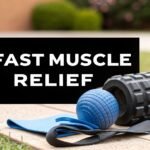
That familiar ache after a challenging workout, known as Delayed Onset Muscle Soreness (DOMS), is a universal sign of progress for athletes and fitness enthusiasts alike. While it signifies that your muscles are adapting and growing stronger, the resulting discomfort can significantly hinder your ability to train consistently and perform at your best. Effectively managing this soreness is not just about comfort; it's about optimizing your recovery cycle to prevent injury and maximize gains.
The world of muscle recovery is vast, often filled with conflicting advice and unproven fads. This guide is designed to cut through that noise. We will provide a clear, comprehensive breakdown of eight of the most effective, science-backed methods that truly represent the best treatment for sore muscles. Our goal is to move beyond generic tips and offer actionable strategies that you can implement immediately.
From foundational protocols like R.I.C.E. to the nuances of active recovery, targeted heat therapy, and strategic nutrition, we will equip you with a complete toolkit. Each technique is presented to help you turn recovery from a passive waiting game into an active, competitive advantage. For a deeper dive into the science behind post-exercise muscle pain, including its causes and management strategies, you can explore this kompletný sprievodca bolesťou svalov po cvičení for a thorough overview. By mastering these approaches, you can get back to your peak faster, stronger, and more resilient than before.
1. R.I.C.E. Protocol (Rest, Ice, Compression, Elevation)
The R.I.C.E. protocol is a cornerstone of first-aid treatment for acute muscle injuries and significant soreness, particularly in the critical 24-48 hours following trauma or intense exertion. Coined by Dr. Gabe Mirkin in 1978 and championed by organizations like the American Red Cross, this method is a foundational technique used by athletic trainers, physical therapists, and military medics worldwide. It stands out as one of the best treatments for sore muscles precisely because it directly addresses the immediate physiological responses to injury: inflammation and swelling.
The protocol's effectiveness lies in its simple, four-part approach designed to manage pain and accelerate the healing process by controlling the initial inflammatory phase. Each component plays a specific role:
- Rest: Immediately ceasing activity prevents further strain on the damaged muscle fibers.
- Ice: Applying cold constricts blood vessels, which helps reduce swelling and numb the area, providing pain relief.
- Compression: Using an elastic wrap helps physically limit the buildup of fluid (edema) in the tissues.
- Elevation: Raising the injured limb above the heart uses gravity to help drain excess fluid away from the site of injury.
Implementing the R.I.C.E. Method
To apply R.I.C.E. correctly, precision is key. For example, when icing a strained calf muscle after a run, use a towel-wrapped ice pack for 15-20 minutes every two to three hours. Follow this with a compression wrap that has about 50% stretch, ensuring it's snug but not tight enough to cut off circulation. While resting, prop your leg on pillows so it's at least 6-10 inches above your heart.
Key Insight: The primary goal of R.I.C.E. is not to eliminate inflammation entirely but to control its initial, aggressive stage. This management helps reduce secondary damage to surrounding tissues caused by excessive swelling.
The following infographic illustrates the crucial first steps for applying R.I.C.E. immediately after an injury.
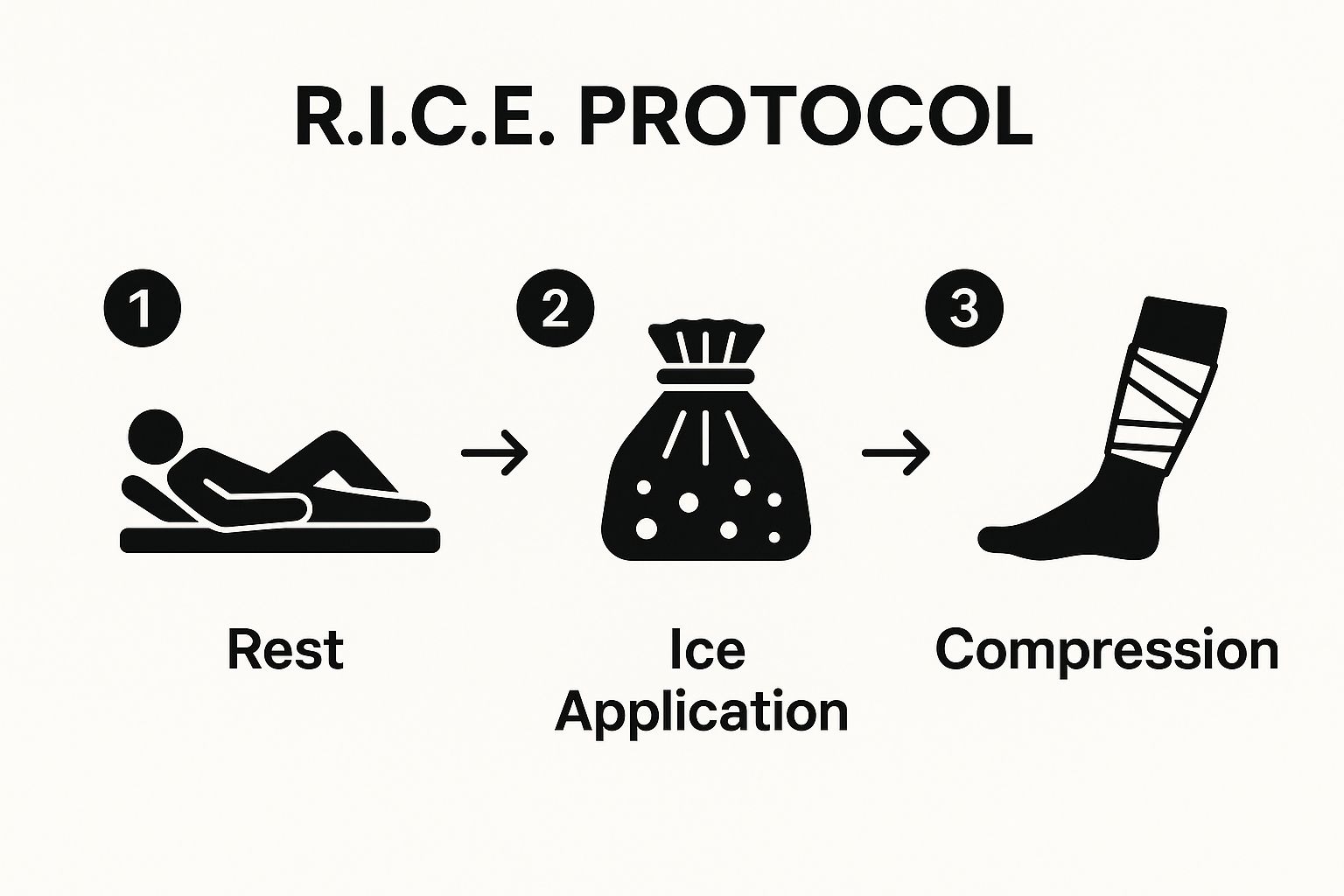
The diagram emphasizes that the process begins with immediate rest, followed by systematic icing and compression to manage the initial injury response effectively.
For a visual guide on how to apply compression bandages correctly, this video provides a helpful demonstration:
While R.I.C.E. is a highly effective initial response, modern sports medicine sometimes modifies it to PRICE (adding Protection) or POLICE (Protection, Optimal Loading, Ice, Compression, Elevation), highlighting the importance of gentle movement after the acute phase. However, for immediate care, the classic R.I.C.E. remains a trusted and accessible starting point.
2. Active Recovery and Light Exercise
Counterintuitive to the impulse to remain completely still, active recovery is a therapeutic approach that uses low-intensity movement to alleviate muscle soreness. Popularized by professional sports teams and mobility experts like Dr. Kelly Starrett, this method is considered one of the best treatments for sore muscles because it stimulates blood flow to fatigued tissues. This increased circulation delivers oxygen and nutrients essential for repair while simultaneously flushing out metabolic waste products, like lactate, that contribute to stiffness and pain.
The effectiveness of active recovery lies in its ability to gently engage muscles without inflicting further stress or damage. It keeps the body moving, preventing the "locking up" feeling associated with delayed onset muscle soreness (DOMS) and promoting a faster return to peak performance.
- Promotes Blood Flow: Low-intensity exercise increases circulation, delivering restorative nutrients and oxygen to tired muscles.
- Reduces Stiffness: Gentle movement helps maintain flexibility and range of motion, preventing the severe stiffness that can set in after a tough workout.
- Accelerates Waste Removal: Enhanced blood flow helps clear metabolic byproducts that accumulate during intense exertion.
- Psychological Boost: Light activity can improve mood and help athletes feel productive even on a rest day.
Implementing Active Recovery
To apply this method correctly, the key is to keep the intensity extremely low. For example, after a day of heavy squats, a 20-minute session on a stationary bike at a conversational pace or a gentle yoga flow focusing on the hips and legs would be ideal. The goal is to move the body through its range of motion without elevating your heart rate significantly or causing any strain. Professional athletes often schedule specific active recovery days with light training, and many CrossFit gyms program "active recovery" workouts consisting of rowing, biking, and mobility work.
Key Insight: The purpose of active recovery is not to build fitness but to facilitate healing. The intensity should be low enough that the activity feels restorative, not strenuous, typically between 30-50% of your maximum effort.
For a deeper understanding of the science and application of mobility for recovery, Dr. Kelly Starrett’s platform, The Ready State, offers extensive resources.
To ensure your active recovery session is effective and safe, follow these tips:
- Keep the intensity low and the duration short, generally 20-30 minutes.
- Focus on movements that engage the large muscle groups you worked previously.
- Incorporate dynamic stretches like leg swings and arm circles.
- Listen to your body; if any movement increases your pain, stop immediately.
While complete rest has its place, integrating active recovery can significantly reduce downtime and is a proactive strategy for managing the inevitable soreness that comes with pushing your physical limits.
3. Heat Therapy (Thermotherapy)
While cold therapy is ideal for acute injuries, heat therapy, or thermotherapy, is a powerful and time-tested method for addressing muscle soreness, stiffness, and chronic tension. Popularized through everything from Scandinavian sauna culture to modern ThermaCare heat wraps, this approach stands as one of the best treatments for sore muscles by promoting circulation and deep relaxation. Its effectiveness comes from its ability to address the subacute and chronic phases of muscle recovery, long after the initial inflammation has subsided.
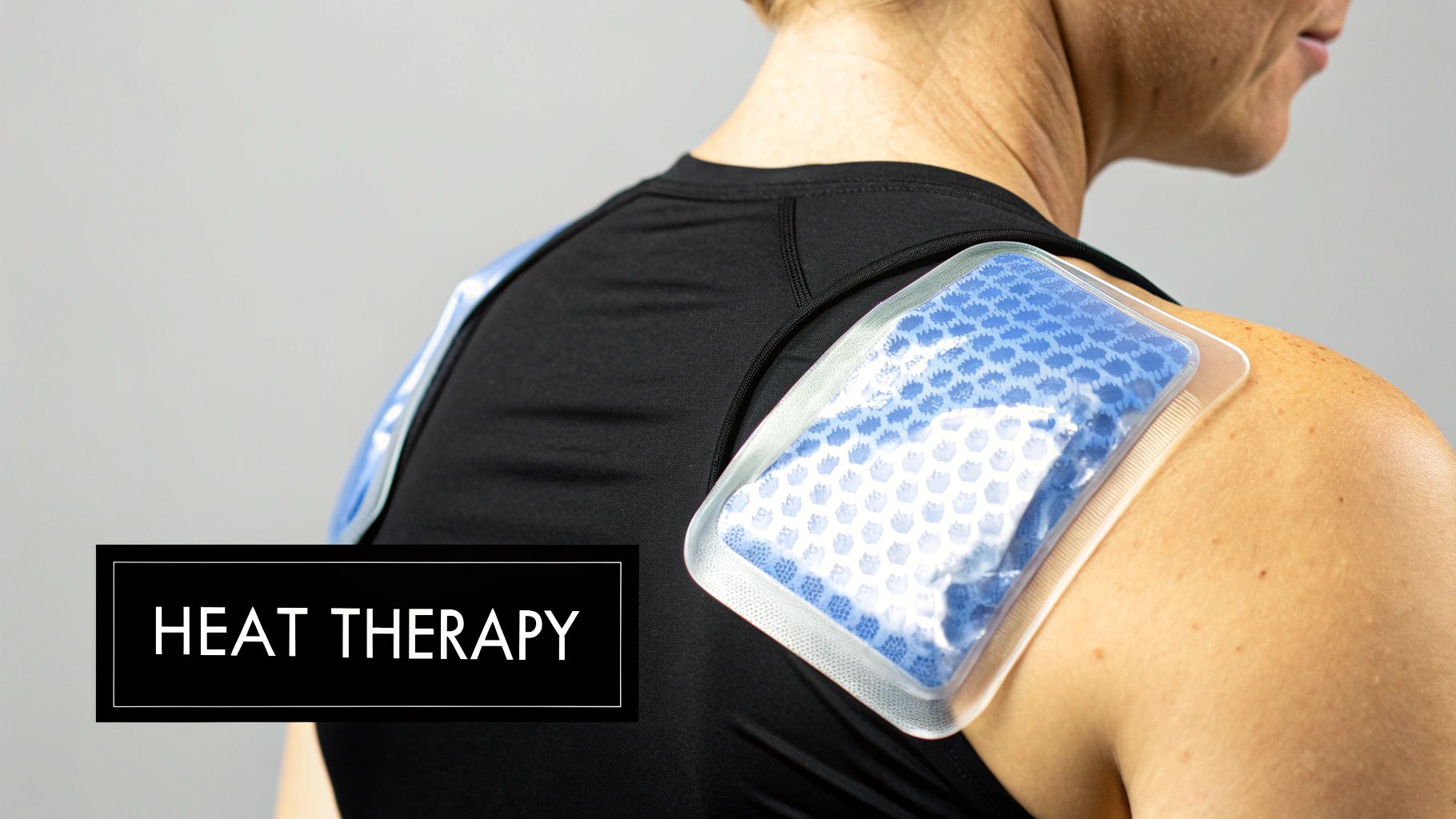
The primary mechanism behind thermotherapy is vasodilation, the widening of blood vessels. Applying heat to a sore area increases blood flow, delivering a fresh supply of oxygen and nutrients that are essential for repairing damaged muscle tissue. This process also helps flush out metabolic byproducts that contribute to soreness.
- Increases Blood Flow: Enhanced circulation accelerates the delivery of healing nutrients and the removal of waste.
- Reduces Stiffness: Heat increases the elasticity of muscle connective tissues, making them more pliable and reducing feelings of tightness.
- Soothes Pain: Warmth stimulates sensory receptors in the skin, which can help block the transmission of pain signals to the brain.
Implementing Heat Therapy
For optimal results, heat should typically be applied 48 to 72 hours after an injury, once the initial swelling has gone down. For general muscle soreness from a workout, you can apply heat sooner. Use a heating pad, warm towel, or take a warm bath for 15-20 minute sessions. A safe and effective temperature is generally between 104-113°F (40-45°C). For example, after a tough leg day, a warm Epsom salt bath can soothe quadriceps and hamstring soreness. Similarly, athletes often use targeted heat wraps on their lower back or shoulders before a competition to improve mobility and prevent injury.
Key Insight: Heat therapy is most effective when used for muscle soreness characterized by stiffness and ache, rather than the sharp pain and swelling of an acute injury. Combining gentle stretching after a heat session can significantly improve flexibility and reduce tension.
4. Massage Therapy
Massage therapy is a hands-on treatment that involves the systematic manipulation of the body's soft tissues, including muscles, tendons, and ligaments. A practice with roots in ancient medicine, it has become a scientifically-backed modality for modern recovery, championed by institutions like the Mayo Clinic and integrated into the standard care protocols for countless professional sports teams. It is one of the best treatments for sore muscles because it directly addresses mechanical tension, improves circulation, and can down-regulate the nervous system's pain response.
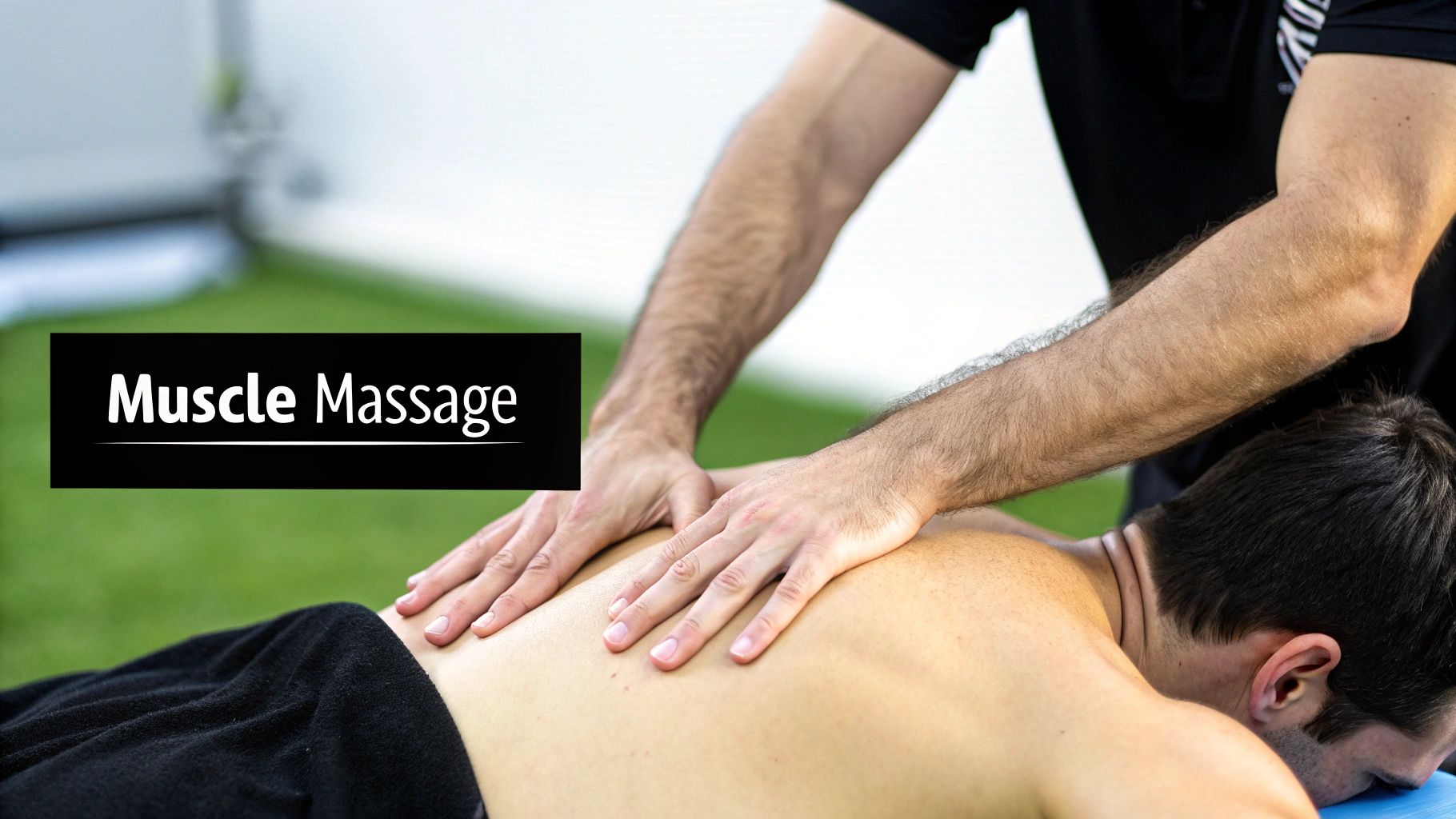
The effectiveness of massage therapy comes from its multi-faceted physiological impact. Different techniques apply pressure and movement to muscle fibers, which helps to increase blood flow, delivering oxygen and nutrients while flushing out metabolic waste products associated with exercise-induced muscle damage. Techniques include:
- Swedish Massage: Uses long, gliding strokes to promote overall relaxation and improve circulation.
- Deep Tissue Massage: Applies more intense pressure to target deeper layers of muscle and connective tissue, ideal for chronic tension.
- Sports Massage: A targeted approach that focuses on specific muscle groups used in a particular sport to prevent injury and enhance performance.
- Trigger Point Therapy: Applies direct pressure to specific "knots" or hyperirritable spots in the muscle to release tension and alleviate referred pain.
Implementing Massage Therapy
To get the most out of massage, timing and communication are critical. For post-workout soreness, it is often best to schedule a session 24 to 48 hours after your intense activity. This allows the initial, acute inflammation to subside, making the muscle tissue more receptive to manipulation. For example, a marathon runner might schedule a deep tissue session two days after a race to address deep-seated soreness in the hamstrings and calves.
Key Insight: Massage therapy does more than just "feel good." Research indicates it can reduce the production of inflammatory cytokines and stimulate mitochondria, the energy-producing units in cells, which directly supports cellular repair and muscle recovery.
During the session, always communicate your pain levels and preferences to the therapist. What works for one person may be too intense for another. After the treatment, be sure to drink plenty of water to help your body continue flushing out the metabolic byproducts released from the muscle tissue. Between professional sessions, using self-massage tools like foam rollers or percussion guns can help maintain muscle pliability and manage minor soreness effectively.
5. Stretching and Flexibility Training
A systematic approach to stretching and flexibility training is a foundational treatment for sore muscles, helping to alleviate tension, improve range of motion, and prevent future discomfort. Popularized by pioneers like Bob Anderson, author of Stretching, and modern movements like MobilityWOD, this practice has been integrated into physical therapy, professional sports, and wellness routines like yoga and Pilates. Its value as a treatment for sore muscles comes from its ability to gently elongate muscle fibers, release built-up tension, and increase blood flow to fatigued tissues.
This method's effectiveness stems from its diverse techniques, each targeting muscle soreness from a different angle. By improving the elasticity of muscles and the surrounding fascia, stretching helps reduce the sensation of tightness and stiffness that often accompanies delayed onset muscle soreness (DOMS).
- Static Stretching: Holding a stretch in a fixed position helps lengthen muscle fibers and calm the nervous system.
- Dynamic Stretching: Using controlled, movement-based stretches prepares muscles for activity and increases blood circulation.
- PNF Stretching: Proprioceptive neuromuscular facilitation is an advanced technique, often used in clinical settings, that involves both stretching and contracting the muscle group to achieve greater flexibility gains.
- Myofascial Release: Using tools like foam rollers helps break up adhesions and muscle knots, which can be a primary source of soreness. Learn more about effective techniques for getting rid of muscle knots.
Implementing Stretching and Flexibility
To effectively use stretching for muscle recovery, timing and technique are crucial. For example, after a strenuous leg workout, wait until your muscles are warm, perhaps after a short walk or a warm shower. Then, perform static stretches for your hamstrings, quadriceps, and glutes, holding each stretch for 30-60 seconds without bouncing. Breathe deeply and relax into the stretch to maximize its benefits. For specific localized muscle soreness, such as persistent back pain, gentle stretches and movements found in yoga can provide significant relief. You can explore how yoga for back pain relief offers a soft solution.
Key Insight: The primary goal of recovery stretching is not to force extreme flexibility but to gently guide the muscles back to their resting length. This process alleviates tension, reduces perceived soreness, and enhances the body’s natural repair cycle.
While dynamic stretching is best suited for a warm-up, static stretching and myofascial release are ideal for a cool-down or on rest days to aid recovery. This proactive approach not only treats existing soreness but also builds more resilient muscles, making it a vital long-term strategy for any active individual.
6. Topical Anti-inflammatory Treatments
Topical anti-inflammatory treatments offer a direct and localized approach to pain management, making them an excellent treatment for sore muscles when you need targeted relief. These products, which include creams, gels, salves, and patches, are applied directly to the skin over the affected area. Their popularity, from historical staples like Bengay to modern formulations, stems from their ability to deliver active ingredients precisely where they are needed, bypassing the digestive system and reducing the risk of systemic side effects associated with oral medications.
The effectiveness of these topicals lies in their active ingredients, which penetrate the skin to address pain and inflammation at the source. The mechanism of action varies depending on the compound:
- Counterirritants: Ingredients like menthol and camphor (found in Icy Hot) create a cooling or warming sensation that distracts the brain from deeper muscle pain.
- Salicylates: Related to aspirin, these compounds (found in Aspercreme) have mild anti-inflammatory properties that help reduce swelling and discomfort.
- NSAIDs: Prescription and over-the-counter options like Voltaren gel contain nonsteroidal anti-inflammatory drugs (e.g., diclofenac) that block the production of pain-causing prostaglandins.
- Natural Compounds: Ingredients such as arnica and CBD are believed to have anti-inflammatory and analgesic effects, offering a more holistic option.
Implementing Topical Treatments
To use a topical treatment effectively, start by applying a thin layer to the sore muscle and massaging it gently until it's absorbed. For direct application to sore areas, a dedicated muscle salve can provide targeted relief. Always test the product on a small patch of skin first to check for any irritation, and be sure to wash your hands thoroughly after application to avoid contact with your eyes or other sensitive areas. Never apply these products to broken skin or wounds.
Key Insight: Topical treatments are ideal for providing rapid, localized relief without the systemic impact of oral painkillers. They allow you to target specific sore spots after a workout, such as the quadriceps or shoulders, providing immediate comfort and reducing inflammation.
These treatments are a powerful tool for managing delayed onset muscle soreness (DOMS) or minor strains. For those interested in exploring plant-based options, you can learn more about natural remedies for muscle pain on lamoondayspa.com. This approach provides a practical way to manage discomfort and support the body’s recovery process directly at the site of soreness.
7. Hydration and Nutrition Optimization
While external treatments like massage and ice are effective, optimizing your internal environment through hydration and nutrition is a foundational strategy for muscle recovery. This approach, championed by sports nutritionists and institutions like the Gatorade Sports Science Institute, is one of the best treatments for sore muscles because it provides the essential building blocks for repair and inflammation control from the inside out. It addresses the physiological needs created by strenuous exercise, ensuring your body has the raw materials to heal damaged tissues efficiently.
The effectiveness of this method lies in its two-pronged approach: rehydrating the body to restore cellular function and supplying key nutrients to rebuild muscle and combat exercise-induced inflammation. Each component is critical for preventing prolonged soreness and accelerating the recovery timeline:
- Hydration: Water is essential for transporting nutrients to muscle cells and flushing out metabolic waste products like lactic acid. Dehydration can intensify muscle cramps and soreness.
- Electrolytes: Minerals like sodium, potassium, and magnesium are lost through sweat and are crucial for proper muscle contraction and nerve function.
- Protein: Consuming adequate protein provides the amino acids necessary to repair and rebuild the microscopic muscle tears caused by exercise.
- Anti-inflammatory Nutrients: Certain foods and supplements can help manage the inflammatory response, reducing pain and swelling naturally.
Implementing Hydration and Nutrition Strategies
Proper implementation requires a conscious effort both before and after your workout. For example, an endurance athlete preparing for a long race might focus on electrolyte-rich fluids and complex carbohydrates beforehand. After a heavy lifting session, their focus would shift to a recovery drink containing a 3:1 or 4:1 ratio of carbohydrates to protein, consumed within 30-60 minutes to maximize glycogen replenishment and muscle protein synthesis.
Key Insight: Viewing food and water as recovery tools rather than just fuel is a paradigm shift. This proactive approach ensures your muscles are constantly supplied with what they need to repair, adapt, and grow stronger, significantly reducing the downtime caused by soreness.
For a deeper dive into post-workout nutrition, this video from a registered dietitian offers evidence-based recommendations:
To effectively integrate this into your routine, monitor your urine color; a pale yellow hue typically indicates good hydration. Additionally, planning your post-workout meal or shake ahead of time ensures you never miss the critical recovery window, making it a powerful and consistent treatment for sore muscles.
8. Sleep and Recovery Optimization
While active interventions like stretching and massage are crucial, sleep is arguably the single most important component of muscle recovery. Sleep and recovery optimization is a holistic approach that treats sleep as the body's primary repair cycle, during which it performs the vital work of healing damaged tissues. This method moves beyond simply "getting more sleep" and focuses on improving sleep quality, duration, and timing, championed by sleep researchers like Dr. Matthew Walker and adopted by elite sports organizations worldwide. It is one of the best treatments for sore muscles because it directly facilitates the hormonal and cellular processes, like the release of human growth hormone (HGH), essential for muscle repair and adaptation.
The effectiveness of this approach lies in its focus on maximizing the body's natural, inbuilt healing mechanisms. During deep sleep stages, blood flow to muscles increases, delivering extra oxygen and nutrients that promote healing and growth. Optimizing this process leads to faster recovery, reduced soreness, and improved athletic performance.
- Muscle Repair: The majority of muscle repair and rebuilding occurs during slow-wave sleep.
- Hormone Regulation: Sleep regulates critical hormones like HGH for growth and cortisol for stress management.
- Inflammation Control: Adequate sleep helps manage the inflammatory response, preventing chronic inflammation that can impede recovery.
- Energy Restoration: The brain and body replenish glycogen, the primary energy source for muscles, during sleep.
Implementing Sleep Optimization
To truly leverage sleep for recovery, a systematic approach is necessary. For instance, a cyclist training for a race would not only aim for 8-9 hours of sleep but also establish a strict bedtime and wake-up time, even on weekends, to stabilize their circadian rhythm. They would also create a sleep sanctuary: a bedroom that is completely dark, quiet, and cool (around 65°F or 18°C).
Key Insight: The consistency of your sleep schedule is as important as the duration. A regular sleep-wake cycle trains your body and brain to anticipate rest, making it easier to fall asleep and improving the quality of your recovery stages.
This commitment to sleep hygiene is a non-negotiable for athletes seeking a competitive edge. It's a foundational recovery tool that amplifies the benefits of all other treatments. If you're looking to enhance your recovery routine, you can discover more in-depth strategies. Learn more about muscle recovery tips on lamoondayspa.com.
Many professional athletes and teams now employ sleep specialists and use tracking technology, like WHOOP or Oura rings, to monitor sleep stages and recovery metrics, making data-driven adjustments to their training and sleep habits. This highlights the shift from viewing sleep as passive downtime to an active and essential recovery strategy.
Top 8 Sore Muscle Treatments Compared
| Treatment Method | Implementation Complexity 🔄 | Resource Requirements ⚡ | Expected Outcomes 📊 | Ideal Use Cases 💡 | Key Advantages ⭐ |
|---|---|---|---|---|---|
| R.I.C.E. Protocol | Low – simple four-step procedure | Minimal – ice, compression wrap needed | Reduces inflammation & pain quickly | Acute muscle injuries within first 24-48 hours | Accessible, cost-effective, immediate relief |
| Active Recovery and Light Exercise | Moderate – requires intensity management | Low – no special equipment required | Promotes circulation, faster recovery | Delayed onset muscle soreness (DOMS), fatigue | Maintains fitness, improves mood, prevents stiffness |
| Heat Therapy | Low – simple application | Low – heating pads, warm baths | Relaxes muscles, reduces stiffness | Chronic muscle tension, stiffness | Immediate comfort, improves flexibility |
| Massage Therapy | Moderate to High – needs trained therapist | High – professional sessions required | Pain relief, improved range of motion | Muscle tension, targeted problem areas | Immediate pain relief, stress reduction |
| Stretching and Flexibility Training | Moderate – requires technique & consistency | Minimal – can be self-performed | Improves flexibility, reduces tension | Mobility improvement, prevention of muscle issues | Cost-effective, accessible, independent practice |
| Topical Anti-inflammatory Treatments | Low – simple application | Low – creams, gels, patches | Targeted pain relief, reduces local inflammation | Localized muscle pain and soreness | Fast-acting, minimal systemic effects |
| Hydration and Nutrition Optimization | Moderate – requires dietary consistency | Low to Moderate – food and supplements | Supports healing, prevents cramps and fatigue | Overall muscle recovery and long-term prevention | Natural, sustainable, enhances other treatments |
| Sleep and Recovery Optimization | Moderate – lifestyle adjustments | Minimal – sleep environment setup | Enhances healing, hormone release | General recovery, overtraining prevention | Most natural, cost-effective, improves performance |
Crafting Your Personal Recovery Blueprint
Navigating the landscape of muscle recovery can feel overwhelming, but as we've explored, the search for the single best treatment for sore muscles is often misguided. The true key to unlocking peak performance and minimizing downtime isn't about finding one miracle cure. Instead, it's about building a dynamic, personalized recovery blueprint that addresses your body's unique needs after every workout, competition, or physically demanding day. You are the architect of your own recovery, and the eight powerful strategies detailed in this guide are your essential building blocks.
Think of these treatments not as isolated options but as interconnected tools in a comprehensive system. Your goal is to move beyond a reactive approach, where you only seek relief when pain becomes unbearable, and adopt a proactive mindset that integrates recovery into your daily and weekly routines.
Synthesizing Your Strategy: From Theory to Action
The journey from soreness to strength begins with understanding how to layer these techniques effectively. Immediate, acute soreness from an intense leg day, for instance, might call for the classic R.I.C.E. protocol in the first 24-48 hours to manage inflammation. This can be followed by gentle active recovery, like a slow walk or a light swim, to stimulate blood flow and prevent stiffness from setting in.
As the initial ache subsides, you can transition to heat therapy, such as a warm bath or a heating pad, to relax tight muscles and improve circulation further. This is also the perfect time to incorporate targeted stretching or foam rolling to release knots and restore flexibility. For persistent trigger points, a topical anti-inflammatory cream can provide localized relief exactly where you need it, allowing you to stay mobile and comfortable.
Key Insight: The most effective recovery isn't a one-time fix. It’s a continuous cycle of listening to your body, applying the right technique at the right time, and consistently supporting the entire system with foundational health practices.
The Foundational Pillars of Lasting Recovery
While active interventions are crucial, they are only as effective as the foundation they're built upon. This is where the non-negotiable pillars of health come into play:
- Hydration and Nutrition: View your meals and water intake as the raw materials for muscle repair. Prioritizing protein, anti-inflammatory foods, and consistent hydration gives your body the essential nutrients it needs to rebuild stronger.
- Sleep Optimization: Never underestimate the power of restorative sleep. This is when your body produces growth hormone and engages in the deep cellular repair that turns effort into adaptation. Protecting your sleep is as critical as any workout.
By mastering these fundamentals, you create an internal environment that is primed for healing. This proactive approach ensures that when you do push your limits, your body has the resources to bounce back faster and more resiliently than before.
Your Path Forward: Experiment and Adapt
The ultimate best treatment for sore muscles is the one that works consistently for you. Your blueprint will evolve. What your body needs after a long run might be different from what it requires after a heavy lifting session. Start by experimenting. Try contrast therapy, alternating between cold and hot, and note how you feel. Pay attention to whether a deep tissue massage provides more relief than a gentle Swedish massage. Keep a simple journal to track your workouts, your soreness levels, and the recovery methods you use.
This process of self-discovery is empowering. It transforms you from a passive recipient of muscle pain into an informed athlete who understands how to manage and optimize your body's recovery cycle. By embracing this holistic approach, you’ll not only conquer muscle soreness but also unlock a new level of physical potential, ensuring you can continue pursuing the activities you love with vigor and vitality for years to come.
For those moments when stubborn knots and deep-seated tension require a professional touch, consider integrating expert massage therapy into your recovery plan. The skilled therapists at La Moon Massage and Facial specialize in techniques designed to address athletic soreness, release trigger points, and accelerate your body's natural healing processes. Elevate your recovery blueprint by booking a targeted session at La Moon Massage and Facial and experience the profound difference expert care can make.
How to Relax Tight Shoulder Muscles Quickly & Effectively
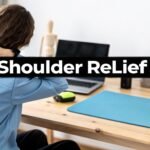
That nagging ache between your shoulder blades or the tight, rock-solid feeling at the base of your neck—if this sounds familiar, you’re in good company. Persistent shoulder tension is one of the most common complaints I hear, and for good reason.
Shoulder pain is incredibly widespread, with studies showing it affects anywhere from 13% to 37% of adults. You can find more detailed statistics on shoulder pain prevalence over at Physio-pedia, but the bottom line is clear: a lot of us are dealing with this. The culprits are often the everyday habits we don't even think about.
The Modern-Day Strain on Our Shoulders
Think about your daily routine. How many hours do you spend hunched over a laptop, with your shoulders creeping up toward your ears? Or what about the time spent with your head tilted down, scrolling through your phone? This posture, often called "tech neck," puts a tremendous and constant strain on your trapezius muscles, which run from your neck down to your mid-back.
Add in other factors, like lugging a heavy backpack on one shoulder or the physical demands of your job, and it’s easy to see how the tension accumulates day after day.
How Stress Ties Knots in Your Muscles
It's not just physical posture, either. Stress plays a huge role. When we feel overwhelmed or anxious, our bodies go into a "fight or flight" mode. One of the first physical reactions is to tense up, and the neck and shoulders are prime targets.
This isn't a conscious choice; it's a deep-seated physiological response. But when stress becomes chronic, that muscle clenching becomes a constant state, leading to stiffness, painful knots, and reduced mobility.
The most important thing to realize is that tight shoulders usually aren't from one single cause. They're the product of your daily posture, your ingrained habits, and how your body responds to stress. That’s why you need a well-rounded approach to find lasting relief.
Ready to get started? The good news is you can begin unwinding that tension right now. Below is a quick guide to some immediate actions you can take. Consistency is everything—making these small adjustments part of your daily life is the key to feeling better and keeping the pain from coming back.
Your Quick-Start Guide to Shoulder Relief
Here are three immediate actions you can take to begin relaxing tight shoulder muscles right now.
| Action | Example Technique | Primary Benefit |
|---|---|---|
| Gentle Stretching | Slowly tilt your head, bringing your right ear toward your right shoulder. Hold for 15-20 seconds, then repeat on the left. | Immediately lengthens and relieves tension in the upper trapezius muscle. |
| Mindful Movement | Take a deep breath in and shrug your shoulders up to your ears. Hold for a moment, then exhale and let them drop completely. | Resets your posture and helps you become aware of unconscious shrugging. |
| Self-Massage | Use your fingers to gently press and rub the tight area between your neck and shoulder. A tennis ball against a wall also works wonders. | Breaks up small muscle knots and increases blood flow to the area. |
By incorporating these simple techniques, you're not just temporarily easing pain; you're actively retraining your body to let go of its default tension pattern.
Gentle Stretches to Melt Away Tension
When your shoulders are knotted up and screaming after a long day, the last thing you want is a complicated workout. Honestly, some of the most effective relief comes from simple, targeted movements. The idea here isn't to force anything, but to gently encourage those tight muscles to lengthen and let go.
The image below breaks down a few of the biggest culprits behind that persistent shoulder ache.
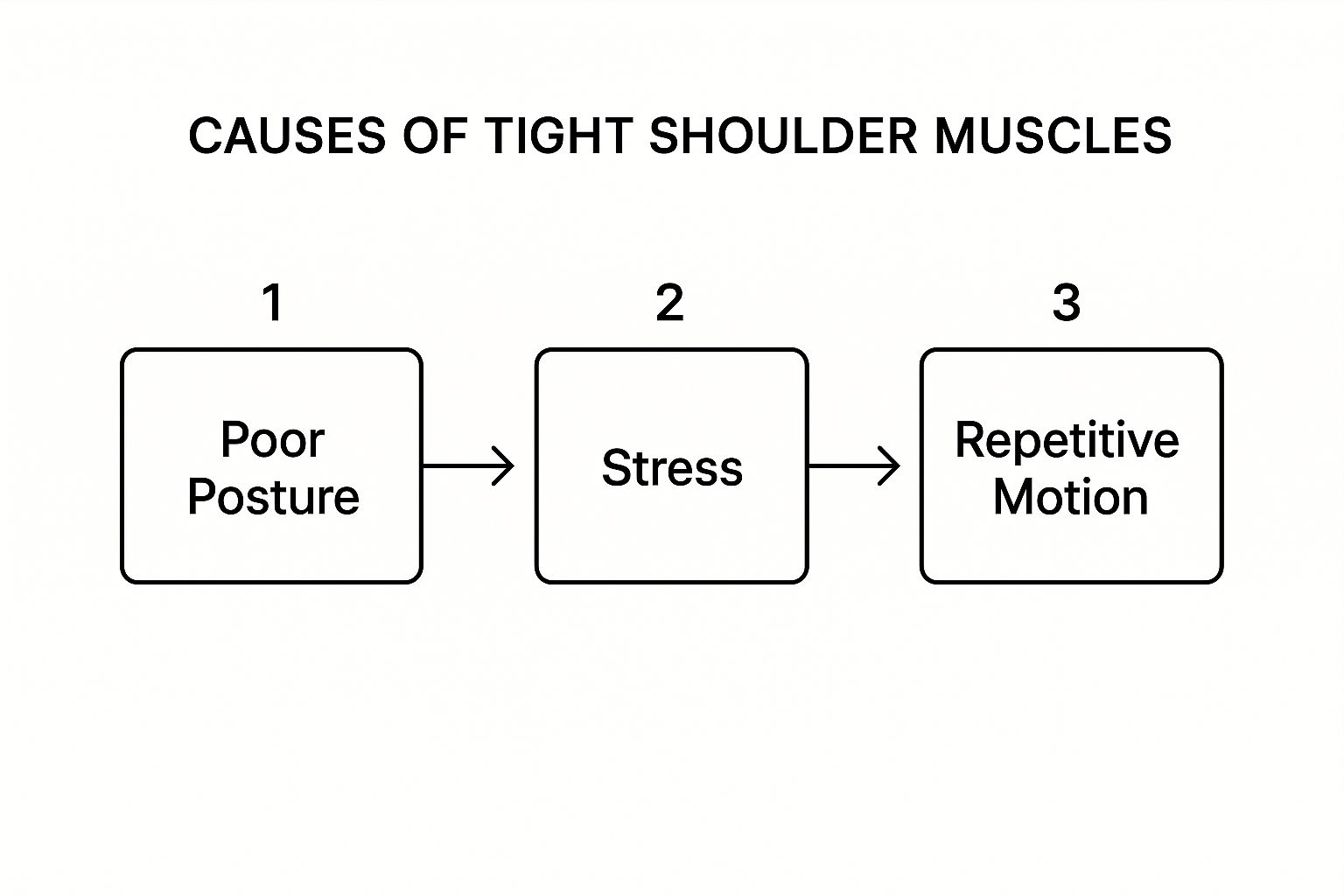
As you can see, things like poor posture, daily stress, and repetitive motions can trap you in a painful cycle, keeping your shoulders constantly tense. Mindful movement is one of the best ways to break free.
Essential Stretches for Daily Relief
Let's walk through two of my go-to stretches that you can do practically anywhere—your office chair, standing in line, or on your living room floor. The key is to breathe deeply and move slowly. If you feel any sharp pain, back off immediately.
-
Cross-Body Arm Stretch: Sit or stand up straight. Bring one arm across your chest and use your other hand to gently pull it closer. You're looking for a comfortable stretch in the back of your shoulder and upper back. Hold it for about 20-30 seconds, making a conscious effort to let that shoulder drop away from your ear. Don't forget to switch sides. This one is a lifesaver for the rear deltoid.
-
Thread the Needle: This one feels incredible. Get on your hands and knees. Slide your right arm underneath your left arm, with your palm facing up. Gently lower your right shoulder and the side of your head toward the floor until you feel a deep stretch across your shoulder blade and upper back. Hold for 20-30 seconds, breathing into the stretch, then slowly return to the start and do the other side.
This mindful approach to stretching does more than just loosen muscle fibers. It sends a signal to your nervous system to release its grip, making it an excellent practice for both physical and mental relaxation.
These stretches offer fantastic immediate relief. But sometimes, that tension digs in and forms stubborn knots that need a more direct approach. If that sounds familiar, you can find more targeted advice here: https://blog.lamoondayspa.com/how-to-get-rid-of-muscle-knots/
It can also be incredibly helpful to pair gentle movement with mindfulness practices for even deeper relief. For instance, you could explore candle yoga relaxation techniques to create a calming atmosphere that enhances your stretching session and helps melt away that stress-related tension for good.
Unlock Knots with Self-Massage Techniques
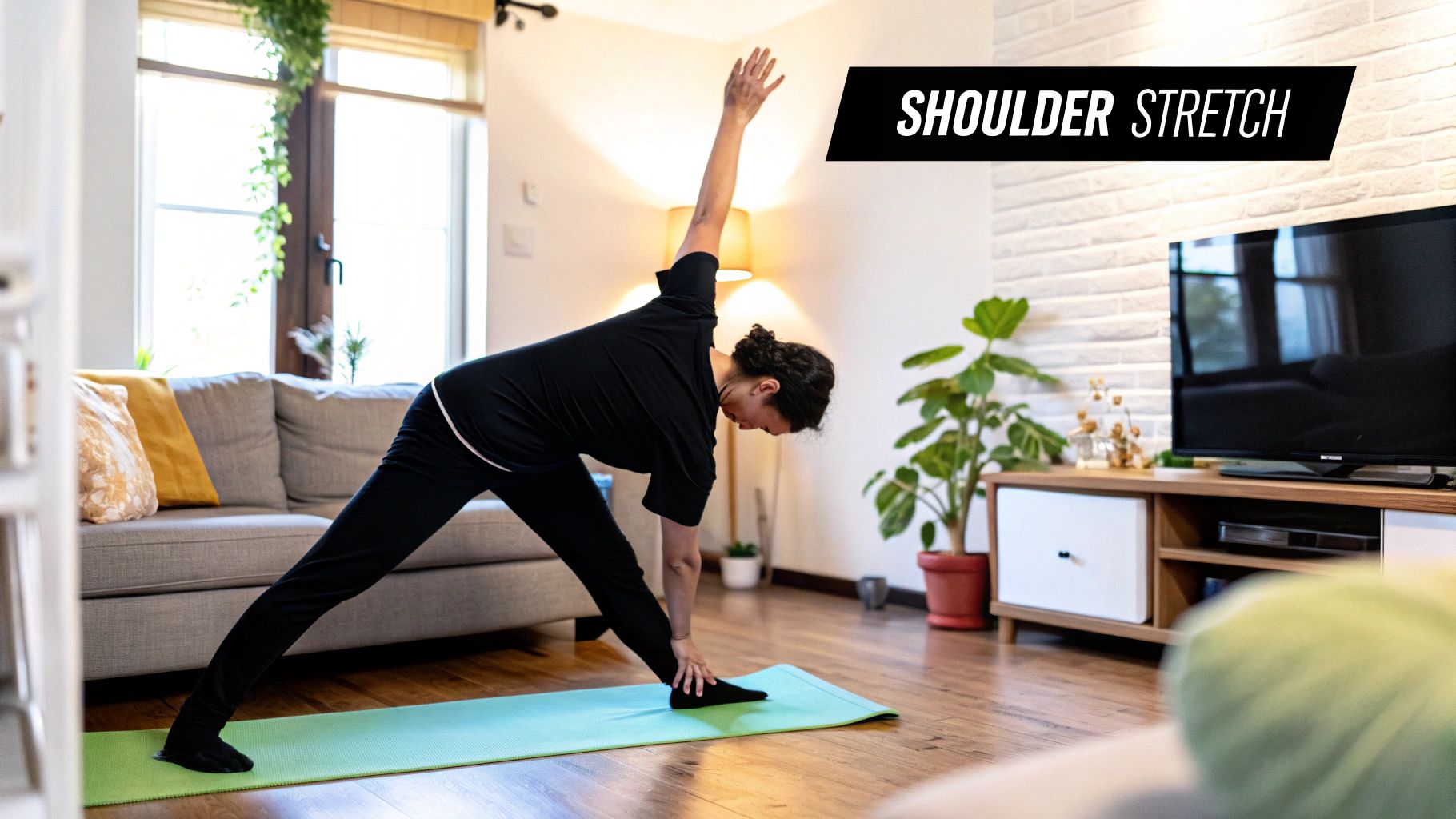
While stretching is fantastic for overall flexibility, sometimes you've got a stubborn knot that just won’t budge. For those really tight spots, you need to get more targeted. That's where self-massage comes in. It’s a game-changer because it puts you in the driver's seat, letting you apply direct pressure to those painful knots, often called trigger points.
And the best part? You don't need any special equipment to start. Your own hands or a humble tennis ball can work wonders. The real secret is using firm, sustained pressure to convince that tense muscle to finally let go.
Using Your Hands for Immediate Relief
Let's start with the most convenient tool you have: your hands. Take your left hand and reach it over your right shoulder. You're aiming for that fleshy, often-tight muscle between the side of your neck and the top of your shoulder joint—your upper trapezius.
Gently start to squeeze and knead that muscle with your fingers and thumb. As you explore, you'll likely find a spot that’s extra tender. That's your trigger point. Once you've found it, press down firmly and hold that pressure for 30-60 seconds. Remember to breathe deeply. You should feel the muscle start to soften under your fingers. Slowly release and then switch to the other side.
The Tennis Ball Technique for Deeper Knots
For those pesky knots between your shoulder blades that your hands just can't reach, a tennis ball is your new best friend. Simply stand with your back to a wall, placing the ball between the wall and the tight muscle.
- Lean your weight into the wall to create pressure.
- Slowly roll up and down or side-to-side, exploring the muscle.
- When you hit a sore spot, pause. Hold the pressure there for about 30 seconds while you breathe, giving the knot time to release.
Pro Tip: Be careful to keep the ball on the fleshy, muscular parts. Avoid rolling directly over your spine or the sharp edges of your shoulder blade. The beauty of this technique is that you control the intensity—just lean in more or less to adjust the pressure.
To make your self-massage even more effective (and feel a bit more luxurious), try using a relaxing massage oil. It helps your hands or the ball glide more smoothly over the skin and adds a calming element to the whole experience.
Learning to work on your own knots is an incredible skill. But for a deeper dive into professional techniques for lasting relief, check out our comprehensive guide on massage for neck and shoulder pain.
Build a Shoulder-Friendly Lifestyle
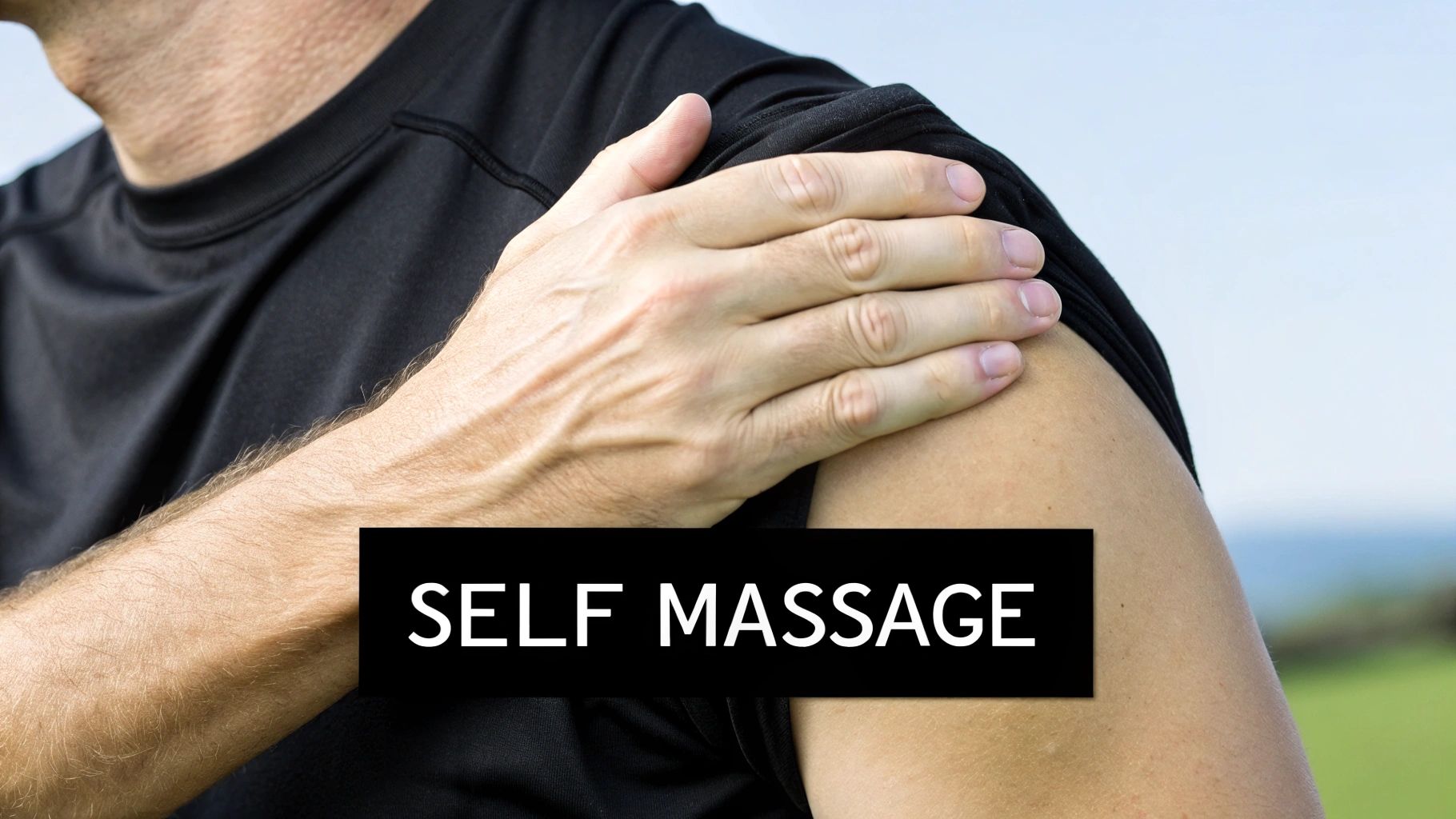
While stretches and self-massage are fantastic for immediate relief, they're really just putting out fires. If you want lasting comfort, you have to look at the small, everyday habits that cause that tension in the first place. Think of it this way: knowing how to fix tight shoulders is good, but preventing them from getting tight is even better.
This isn't just a minor annoyance, either. Globally, musculoskeletal issues—the very things causing your shoulder pain—affect an estimated 1.71 billion people. They're a leading cause of disability around the world.
Your Ergonomic Workspace
For many of us, the trouble starts at our desks. A poorly arranged workspace can force your body into awkward positions for hours on end, making shoulder tension almost a guarantee.
Let's break down how to fix it:
-
Monitor Height: Your monitor needs to be straight ahead, with the top of the screen at or just below your eye level. If it's too low, you'll spend all day looking down, which is a one-way ticket to a strained neck and tight shoulders.
-
Chair Position: Sit with your feet flat on the floor and your knees bent at about a 90-degree angle. Your arms should form a similar 90-degree angle, allowing your wrists to stay straight when you type.
-
Keyboard and Mouse: Pull them in close! Reaching for your keyboard or mouse all day puts a surprising amount of stress on your shoulder joints.
A truly shoulder-friendly lifestyle also requires looking beyond your physical setup. True relaxation extends beyond stretching and massage; understanding the profound impact of sleep on our overall health is fundamental to recovery and prevention.
Handling daily stress is the other major piece of the puzzle. When you feel that tension creeping up, take a few moments for diaphragmatic breathing. These deep belly breaths help calm your nervous system, stopping stress from making a home in your shoulders.
And if you’re an athlete or just physically active, you might find that proactive care is the best approach. Exploring the benefits of sports massage can be a game-changer for both recovery and preventing future issues.
Strengthening Exercises for Resilient Shoulders

While stretching and massage bring that much-needed immediate relief, building strength is your long-term ticket to keeping that tightness from creeping back in. Think of it as creating a durable, stable support system around your shoulder joint. This isn't about hoisting heavy weights; it’s about focused, controlled movements that activate the smaller, often-ignored muscles in your rotator cuff and upper back.
This is especially crucial if you lead an active life. Athletes, particularly those in overhead sports like tennis or swimming, are incredibly susceptible to shoulder pain. In fact, some studies show injury rates as high as 90% in these groups. For them, consistent strengthening isn't just a good idea—it's essential for counteracting repetitive strain. You can learn more about the specific risk factors for athletes to see just how important this balance is.
When you focus on stability, you naturally improve your posture and essentially train your shoulders to manage daily stress without seizing up.
Foundational Movements for Shoulder Stability
Here are a couple of my favorite low-impact exercises that build a solid foundation of strength without putting unnecessary strain on your joints. Always remember the golden rule: form over force.
-
Wall Push-Ups: Start by standing about arm's length away from a wall. Place your hands on the wall, just a bit wider than your shoulders. Keeping your back straight, slowly bend at the elbows and lean your body in. Push back to the start. It’s a fantastic way to gently engage your chest and shoulder muscles.
-
Band Pull-Aparts: Grab a light resistance band with both hands, palms facing the floor. Extend your arms straight out in front of you. Now, pinch your shoulder blades together as you pull the band apart, bringing your arms out to your sides. Hold that squeeze for a second before slowly returning to the starting position.
The real aim here is to build endurance in the postural muscles that hold your shoulders in place. By performing these controlled movements consistently, you’ll make your shoulders far more resilient against everything from desk work to carrying heavy groceries.
Getting to the Bottom of Shoulder Muscle Relief
Even when you know the right moves, questions inevitably come up as you work on those tight shoulder muscles. Getting clear answers is the key to creating a routine that actually works and provides lasting relief.
Let's dive into some of the most common things people wonder about.
How Often Should I Be Stretching My Shoulders?
For day-to-day maintenance, think of it like brushing your teeth. A few minutes of gentle stretching every single day goes a long way in preventing bigger issues later on. It’s a small habit with a big payoff.
If you’re already dealing with some serious tightness or soreness, you can bump that up to two or three short sessions a day. Keep them brief—just 5-10 minutes each is plenty. The golden rule here is to always listen to your body. If you feel any sharp pain, back off immediately.
Should I Use Heat or Ice for Tight Muscles?
Absolutely, and picking the right one at the right time makes all the difference.
For that chronic, deep, nagging ache and stiffness, heat is your best friend. A heating pad, a warm compress, or even a hot shower can work wonders by boosting blood flow and helping those tense muscles finally let go.
Ice, on the other hand, is what you want for a new injury or sharp pain—like a sudden strain. It helps by constricting blood vessels to bring down swelling and numb the area. For general tightness from sitting at a desk all day, heat is almost always the better choice.
Pro Tip: Combining temperature therapy with gentle movement often yields the best results. A little heat followed by some light stretching can seriously speed up the relief process.
When Is It Time to See a Doctor?
Self-care techniques are fantastic, but they have their limits. It’s crucial to know when to bring in a professional. If your shoulder pain is severe or just won't go away after a week of consistent stretching and self-massage, it's time to book an appointment with a doctor or physical therapist.
More urgently, you should seek immediate medical attention if the pain is shooting down your arm or you're experiencing weakness, numbness, or tingling. These can be signs of a more serious issue that needs a proper diagnosis from a healthcare provider.
At La Moon Massage and Facial, we’re experts in tackling that deep-seated muscle tension to help you find genuine relaxation. If you're tired of fighting with persistent shoulder pain, let our skilled therapists guide you toward lasting relief. Experience premium massage therapy designed to soothe your body and mind by booking your appointment.
